|
04 Oct
2020 |
import |
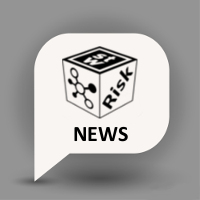 |
import
|
|
|
|
|
|
02 Jun
2020 |
2020 CBRN Stakeholder survey |
 |
ENCIRCLE launched the "2020 CBRN Stakeholder survey" covering CBRN specific areas and also general questions concerning standards and procurement so are applicable to not just the CBRN community, an additional area included is hybrid-threats.

The ENCIRCLE project ran a number of surveys concerning the market, standards and interoperability in Years 1 and 2. These surveys have been combined so we can compare any progress and changes against the original results. The survey takes the form of 18 multiple choice questions and two open questions, which should not take long to complete and are provided in English, French, German and Italian. The questions cover CBRN specific areas and also general questions concerning standards and procurement so are applicable to not just the CBRN community, an additional area included is hybrid-threats. The survey results are anonymous and it will be open until July 31st. We will then publish and present the results in September 2020.
The survey can be found at the following: https://www.sli.do/
- CBRN Stakeholder Survey – English: Event code: #ENCIRCLE-P1
- CBRN Stakeholder Survey – French: Event Code #ENCIRCLE-FR1
- CBRN Stakeholder Survey – Italian: Event Code #ENCIRCLE-IT1
- CBRN Stakeholder Survey – German: Event Code #ENCIRCLE-DE1
|
|
|
|
|
|
13 Apr
2020 |
EC4SafeNano proposal for the creation of a self-sustainable European-wide virtual Centre for risk management and safe innovation in nanomaterials and nanotechnology |
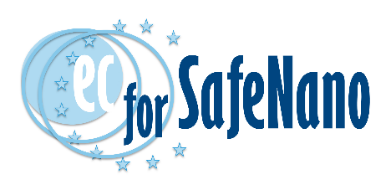 |
The H2020 project is now completed, with a concrete proposal for the creation of a self-sustainable European-wide virtual Centre for risk management and safe innovation in nanomaterials and nanotechnology.
|

|
EC4SafeNano
European Centre for Risk Management and Safe Innovation in Nanomaterials & Nanotechnologies
|

|
The H2020 project is now completed, with a concrete proposal for the creation of a self-sustainable European-wide virtual Centre for risk management and safe innovation in nanomaterials and nanotechnology.
What is the EU project about?
 |
The EC4SafeNano project objective was to build a distributed Centre of European organizations offering services for Risk Management and Safe Innovation for Nanomaterials & Nanotechnologies. EC4SafeNano aimed to bridge the gap between scientific knowledge on hazard and risk, and ‘fit-for-purpose’ risk management tools and strategies supported by measurement and control methods. The consortium comprises 15 partners from 11 European Member States with significant expertise on risk assessment and management, who already provide knowledge and technical services to public and private organizations, to industry and to public authorities and regulatory bodies. |
What are the main outcomes?
- Mapping of the needs and resources available
- Fit-and-gap analysis tool to match the customer needs with the available resources, and identify uncovered or poorly-covered customer demand.
- Inventories of available tools, methods, training courses, standards and standard operating procedures (SOPs), guidance documents and best practices
- Catalogue of services: methods, guidance, studies, standards, training or certification, helpdesk, support for the development of national expertise centres...
- Robust collaborative open structure and network, gathering and sharing the best available resources and knowledge from Europe and beyond, with a governance, a business model, and evaluation and update mechanisms and operating procedures.
What will be the benefit as a member of the EC4SafeNano Center?
- Access to the worldwide available information on institutes, projects and experts in the field of nanosafety and nanotechnologies
- Access to highly qualified services providers and a higher guarantee of the quality of the services provided thanks to a collective service review
- Opportunities to promote and participate in initiatives for harmonization of methods & services
- Active involvement at an early stage in the debate on highly strategic topics
- Enhanced opportunities to establish quicker contact with other partners and reach the critical mass on a given priority topic
- A bigger voice speaking to the institutions
- Reducing the effort and cost of development and harmonization at EU level of approaches for risk assessment & management in nanosafety
What are the services offered by the center?
- HELP DESK to create an efficient interface with external customers and facilitating access to technical information and the available Catalogue of Services
- PROVISION OF TECHNICAL EXPERTISE AND SCIENCE-BASED ADVICE to questions (simple and complex demands, review of services) raised by stakeholders, including regulatory bodies and competent authorities
- ANNUAL JOINT PROGRAMME OF ACTIVITIES (JPA) to organize activities, collectively agreed by the members of the Centre, such as interlaboratory studies, expert group meetings on high-priority topics selected by members, position papers, guidance documents, etc.
- DEVELOPMENT AND PROMOTION OF HARMONIZED SERVICES by the creation and promotion of EU certification of marked services and the training of service providers.
- REGULAR PROMOTION OF THE ACTIVITIES OF THE CENTRE to provide an overview of research projects, standardisation activities and other relevant initiatives in the field of nanosafety in Europe and beyond.
Role of EU-VRi
Besides the support to the coordinator (INERIS) for the project management, monitoring and reporting, the main contributions of EU-VRi were the analysis of the needs of the civil society, the collective development of the business model and business plan of the center and the development of the online version of the catalogue.
More information on the project, the public deliverables and the current Catalogue of Services can be found at the project website http://ec4safenano.eu/. The site also posts an open invitation for research labs or companies providing NanoSafety services to join the future Centre and/or promote their resources and expertise through the Centre.
Duration: 36 Months / Partners: 15 / Programme: Coordination & Support Action in H2020 / Budget-EC Grant: approx. 2-2 Million Euro |
|
|
|
|
|
13 Apr
2020 |
SmartResilience final achievements |
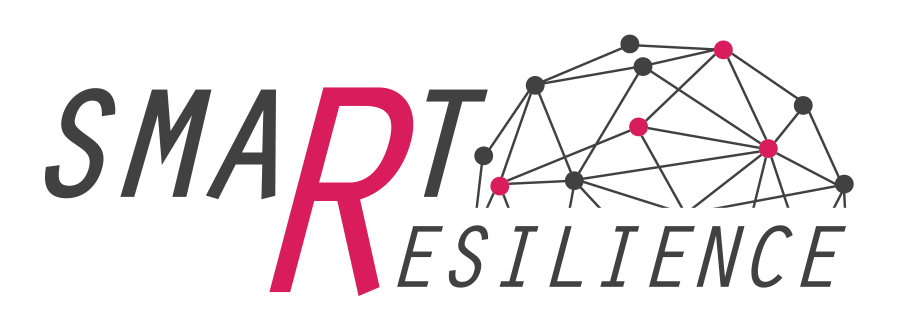 |
The SmartResilience H2020 project, coordinated by EU-VRi, has finished and its main results are released.
|

|
SmartResilience
Smart Resilience Indicators for Smart Critical Infrastructures
|

|
The SmartResilience H2020 project, coordinated by EU-VRi, has finished and its main results are released.
SmartResilience in a nutshell
Modern critical infrastructures are becoming increasingly smarter (e.g. the smart cities). Making the infrastructures smarter usually means making them smarter in the normal operation and use: more adaptive, more intelligent etc. But will these smart critical infrastructures (SCIs) behave smartly and be smartly resilient also when exposed to extreme threats, such as extreme weather disasters or terrorist attacks? If making existing infrastructure smarter is achieved by making it more complex, would it also make it more vulnerable? Would this affect resilience of an SCI as its ability to anticipate, prepare for, adapt and withstand, respond to, and recover? What are the resilience indicators (RIs) which one has to look at?
These are the main questions tackled by the SmartResilience project.
The project answered the above questions in several steps: (1) By identifying existing indicators suitable for assessing resilience of SCIs, (2) By identifying new smart resilience indicators including those from Big Data, (3) By developing, a new advanced resilience assessment methodology based on smart RIs and the resilience indicators cube, including the resilience matrix, (4) By developing the interactive SCI Dashboard tool, and (5) By applying the methodology/tools in 8 case studies, integrated under one virtual, smart-city-like, European case study. The SCIs considered (in 8 European countries!) deal with energy, transportation, health, and water.
Responding to EC Call H2020-DRS-2014-2015: Disaster Resilience: Safeguarding and securing society, including adapting to climate change, the project produced a complete resilience assessment methodology with several accompanying tools, notably the ResilienceTool which supports all of the developed methodology’s features. The methodology and its tools’ good reception made it clear to the consortium that the tool should and could be developed further which actually drove it from the promised RTL4 level (validation in lab) to a fully operational tool at TRL7 (operational prototype) with several real-world cases already implemented within.
Additionally, later in the project, the consortium identified an opportunity to drive the project’s results’ dissemination further and created the new work package (WP9): Ensuring uptake and sustainability of project results which would form the basis for the development of the European Risk and Resilience Assessment agency (ERRA) and that will see the embedding of the project’s results in the new ISO standard 31050: Guidance for managing emerging risks to enhance resilience.
For more information regarding the ResilienceTool, a full user guide is publically available as deliverable D3.7: “The ResilienceTool” of the SmartResilience project on the SmartResilience project’s website.
Main results
The European project SmartResilience has yielded five major break-through results:
|

|
1. Method:
An innovative state-of-the art concept
enabling quantitative assessment of resilience. The concept aims
combines the advantages of approaches oriented towards the
easy-to-understand communication of the assessments results (such as
“resilience very high” or “resilience level red”) with the advantages of
the in-depth assessment approaches, providing many, but often difficult
to understand results (e.g. detailed textual reports from complex
resilience exercises). This main elements of the indicator-based concept
are the “resilience cube” at the top, and the assessment methodology
allowing to (a) assess resilience in a given moment in time and monitor
it over the time, (b) analyze it during a particular adverse effect
scenario, (c) benchmark it, (d) stress-test it, (e) analyze it in a
system of multiple infrastructures and, last but not least, (f) optimize
it a transparent and intuitive way. The concept is public, presented in
publications and presentation and is being summarized in a book under
preparation with the publisher (Springer).
|
|

|
2. Tool:
The concept is applied within a
web-based system, the main elements of which are the resilience
indicator database (over 4,000 indicators available, over 3,000
indicators and almost 1,000 issues), the web-suite of tools (over
20different, combining those pertinent and developed within
SmartResilience project with the “” external” ones) and repository of
the application cases, the later in itself supporting future analyses. |
|

|
3. Applications:
The concept has been practically
applied in 19 case studies in which over 300 different resilience
assessments were made, about 30% of those made for the stakeholders
outside the project (e.g. in other DRS EU projects or the institutions
supporting the partners in the projects – e.g. ministries). The concept
has been discussed and agreed with over 50 different organizational
stakeholders, setup at 7 external-to-the-project “MySmartResilience”
sub-sites. |
|

|
4. Standard:
The project results, at the end of the project, are being
embedded into the new ISO 31050 standard currently under development.
|
|

|
5. Beyond-the-project use:
The “life-after-the-project” of the project results will be practically ensured by the dedicated “resilience rating agency”, the creation of which is initiated at the end of the project (ensuring free-of-charge use after the project), and the educational platform running under the umbrella of the site of one of the academic partners in project.
www.erra.eu-vri.eu |
The TRL (technology readiness level) envisaged at the start of the project to be TRL4, has been over-achieved (approx. TRL5-TRL6). The main results of the projects are already used in the follow-up EU projects and other initiatives.
Duration: 36 Months / Partners: 20 / Programme: Research and Innovation Action in H2020 / Budget-EC Grant: approx. 5-9 Million Euro
http://www.smartresilience.eu-vri.eu |
|
|
|
|
|
13 Apr
2020 |
AssureMoss selected for funding! |
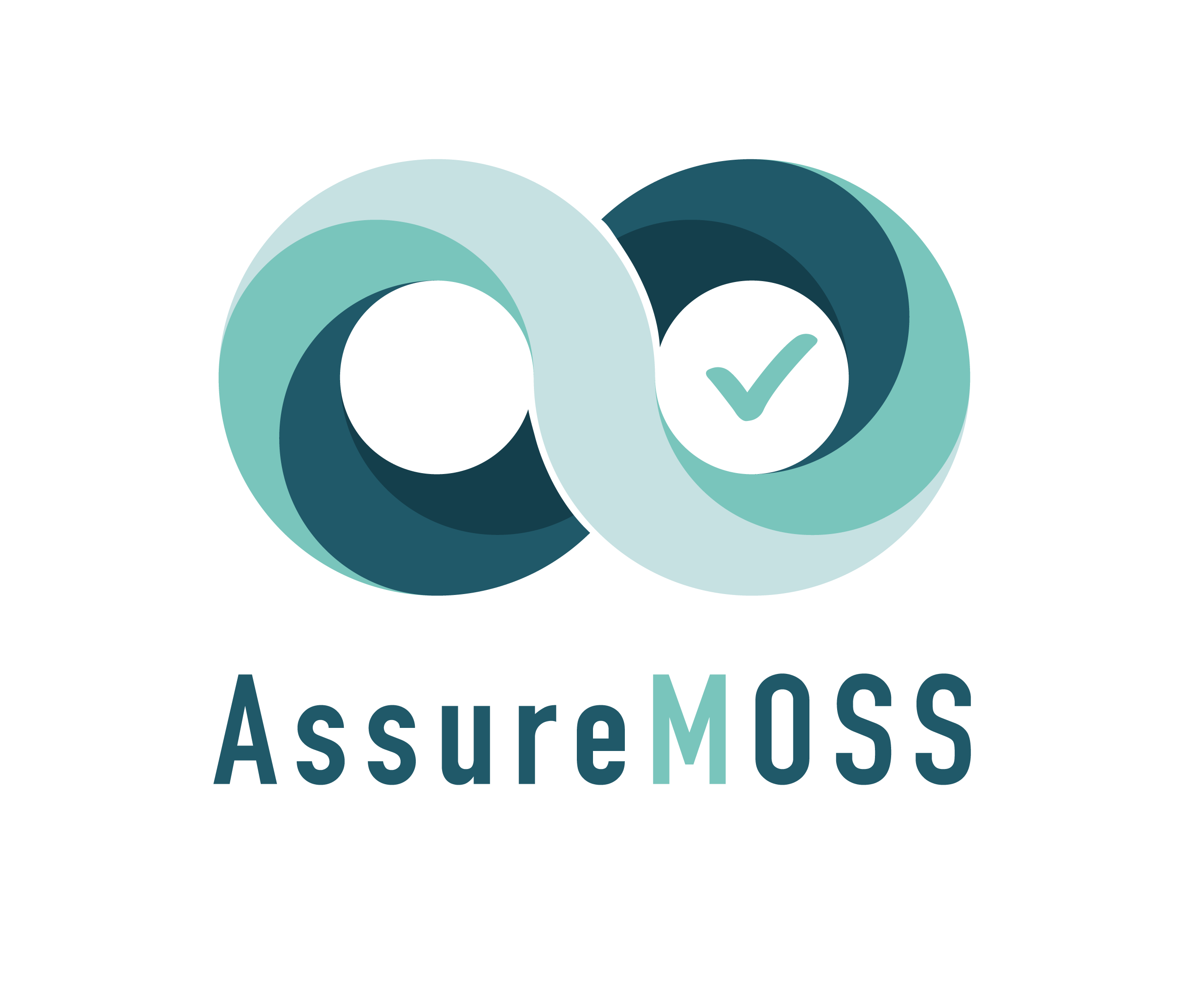 |
EU-VRi is glad to announce that the AssureMoss H2020 project has been selected for funding and is expected to start by the end of 2020.
 |
AssureMoss
Assurance and certification in secure Multi-party Open Software and Services |

|
EU-VRi is glad to announce that the AssureMoss H2020 project, coordinated by UNITN, has been selected for funding and is expected to start by the end of 2020.
AssureMOSS in a nutshell
Continuous, distributed changes rule today's European Digital Single Market as no single company does master its own national, in-house software. Software is mostly assembled from “the internet” and more than half come from Open Source Software repositories (some in Europe, most elsewhere). Security & privacy assurance, verification and process certification techniques designed for large, controlled updates over months or years, must now cope with small, continuous changes in weeks, happening in sub-components and decided by third party developers one did not even know they existed.
AssureMOSS addresses these challenges to the fullest extent: «Open Source Software - Designed Everywhere, Secured in Europe».
AssureMOSS proposes to switch from process-based to an artefact-based security evaluation by supporting all phases of the continuous software lifecycle (Design, Develop, Deploy, Evaluate and back) their artefacts (Models, Source code, Container images, Services). The key idea is to support mechanisms for light weight and scalable screenings applicable automatically to the entire population of software components by:
- Machine intelligent identification of security issues across artifacts,
- Sound analysis and verification of changes by tracing the security and side effects,
- Business insight by risk analysis and security evaluation.
This approach supports fast-paced development of better software by a new notion: continuous (re)certification.
The project will generate not only a set of innovative methods and open source tools but also benchmark datasets with thousands of vulnerabilities and code that can be used by other researchers.
 |
In CI/CD (continuous integration / continuous delivery), on any given
sprint (e.g., a two-week dev cycle), dev teams pull in new open source
libraries, the open source community produces security updates for those
libraries, dev teams make decisions that impact the (security)
architecture of the systems, new features (and their associated security
bugs) are deployed to the customers, and so on. There is a continuous
and high-volume stream of security-relevant events that are generated
both internally (because of own development and operation) and
externally (because of the dependencies to multi-parties).This figure
shows thee security events, both internal and external, that are of
interest in AssureMOSS. |
Main contribution of EU-VRi
|
EU-VRi will adapt to AssureMoss needs the methodology based on
multi-level dynamic checklists, initially developed and applied in the
ANL systems in the US and then developed further and extended in the EU
projects SmartResilience and InfraStress.
The set of about 1,000 indicators will be created for the assessment of risks and resilience in different configurations and situations, as well as for the prediction of whether a MOSS project has a vulnerability in its third-party components or own code.
EU-VRi will provide a large-scale empirical evaluation of the methodology on the set of Maven-based free open-source software libraries that are relevant from an industrial perspective in presence of continuous changes. The evaluation is planned to demonstrate the impact of the methodology for an individual software developer of a MOSS project, as well as for a free open-source ecosystem of software projects.
|
 |
Duration: 36 Months / Partners: 11 / Programme: Research and Innovation Action in H2020 / Budget-EC Grant: approx. 4.7-4.7 Million Euro |
|
|
|
|
|
01 Mar
2020 |
Extratex H2020 project launched in March 2020 |
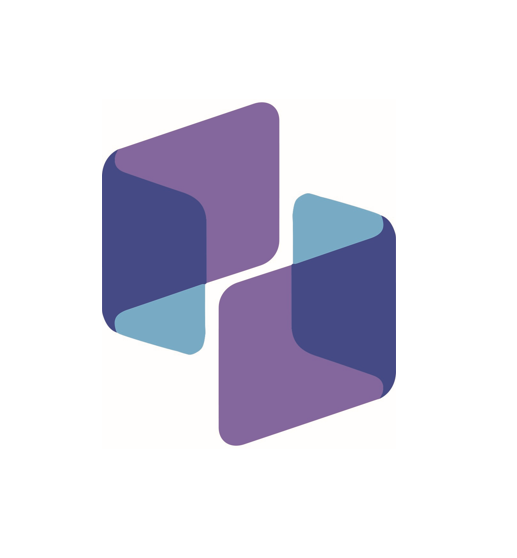 |
The Extratex project, coordinated by NTT, has been launched in March 2020.
|

|
Extratex
European TEXtile-TRAnsport-Sustainability paradigm for industrial clusters EXcellence in cross-sector innovation
|

|
The Extratex project, coordinated by NTT, has been launched in March 2020.
Objectives
|
The partnership aims at enhancing the level
of excellence through strategic plans and joint strategies; in
particular, EXTRATEX will bring together clusters in different
industrial sectors with a high potentiality of collaboration in
technological innovation and technology transfer, namely textile,
transports and sustainable materials.
The project will enhance
innovation capacities, business models, knowledge and skill levels and
other key competitive factors that will determine future business
opportunities and increased capacities for European industrial actors.
Only by developing advanced strategies in cross-sector domains and
implementing them through comprehensive action plans the European
industry can maintain its global market share and current position
vis-à-vis emerging non-European competitors.
|
 |
Strategic thematic priorities
- Capacity building and cluster strategy definition for cluster managers
- Definition of a partnership strategy, as well as 6 individual cluster strategies for the partnership members
- Increase of inter-regional cooperation
- Increase exchange of knowledge and technical skills
- Increase of management capacities for cluster staff, by reaching excellence certification
- Increase of technology transfer opportunities
- Organization of B2B and C2C events
- Definition of a ClusterXchange pilot scheme; at least, 50% of the supported exchanges will involve SMEs cluster member of different sectors
- Dissemination and awareness raising activities
Target group/audience
 |
As the European Cluster Excellence Programme requests, the EXTRATEX
action refers to all cluster organizations and business network
organizations, SMEs that are cluster members and scaling-up support
organizations from COSME participating countries. Besides, regional
authorities are considered potential target group ion EXTRATEX project. |
Expected benefits
- Better access of clusters to innovation opportunities and collaboration for cross-sector VCs set up
- Increased knowledge of R&D results with TRL and transferability (new materials, advanced manufacturing systems, ICT and photonic applications etc.), available for a fast transfer to the industrial level
- Increased quality, flexibility and environmental performances of industrial products and services to the final markets, by undertaking joint actions helping to overcome constraints and issues affecting the final consumer
- Better access to knowledge through new cross-regional RTD activities, technological and commercial partnerships in key areas of common interest, such as innovations addressing societal challenges, key enabling technologies, non-technological innovations or access to new advanced materials
- Advanced technical skills for cluster organizations
- Increased contacts among different industrial sectors in Europe for an improved exchange of opportunities and know-how.
Duration: 24 Months / Partners: 65 / Programme: H2020 COSME Programme / Budget-EC Grant: approx. 0.5-0.4 Million Euro |
|
|
|
|
|
16 Oct
2019 |
A. Jovanovic teaching upcoming course on Risk Based Inspection (RBI) in Amsterdam |
 |
Prof. Dr. Aleksandar Jovanović will be leading a MasterClass on RBI from October 22-23, 2019, in Amsterdam, Netherlands.

RBI, as an approach initially developed in and for Oil and Gas Industry has changed a lot in the year 2019. New industrial and international/European standards (such as EN 16991:2018 or new ISO standards, or the less recent API and ASME standards) have been brought into the modern practice. New tools corresponding to these documents and the overall Industry 4.0 trends have been developed, and, last but least; the application area has been broadened to areas such as power and paper industry. Read more about RBI and this upcoming course in the PDF course agenda linked here: RBI 2019 Course Agenda |
|
|
|
|
|
06 May
2019 |
Highlights from the Joint Final Conference of SmartResilience and SAYSO |
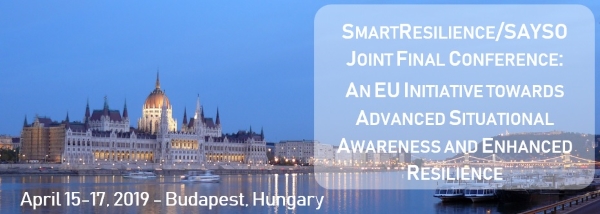 |
From Monday, April 15, 2019, through Wednesday, April 17, 2019, the SmartResilience team was pleased to collaborate with fellow EU Horizon 2020 project SAYSO in hosting their projects' Joint Final Conference in Budapest, Hungary, at the Hungarian Academy of Sciences, Institution for Social Sciences.
The conference, entitled An EU Intiative Towards Advanced Situational Awareness and Enhanced Resilience, involved more than 90 practitioners, developers, technology suppliers, and standardization and procurement specialists, as well as decision-makers, from over 20 different countries. These individuals gathered to share results and collaborate toward finding the best ways to harmonize, integrate, and enhance the projects’ outcomes in order to achieve tangible impact at the European level.
The three-day program included both integrated and project-specific sections to discuss not only the results achieved in the projects but also how their legacies will continue into lasting future impacts. The conference presented a unique opportunity to share experiences in areas including resilience and risk governance, situational awareness systems, cross-border issues, communication, and analysis and management, both among already involved and newly-engaged project stakeholders and experts. As co-conference organizers, we want to thank all those who attended and assisted with the preparation and execution of this impactful event and look forward to future collaborations.
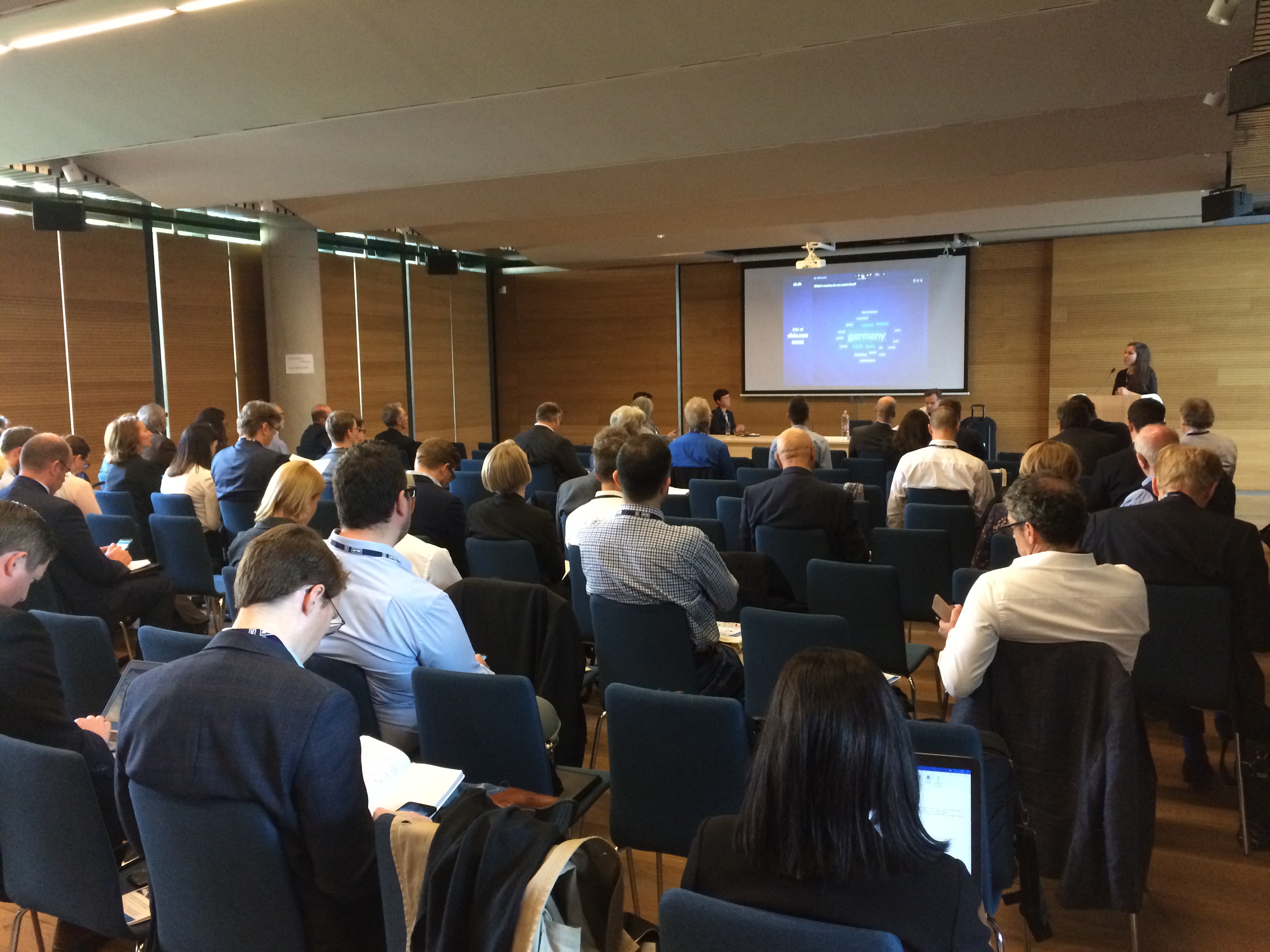
Above: Attendees being introduced to using the interactive audience feedback tool Slido
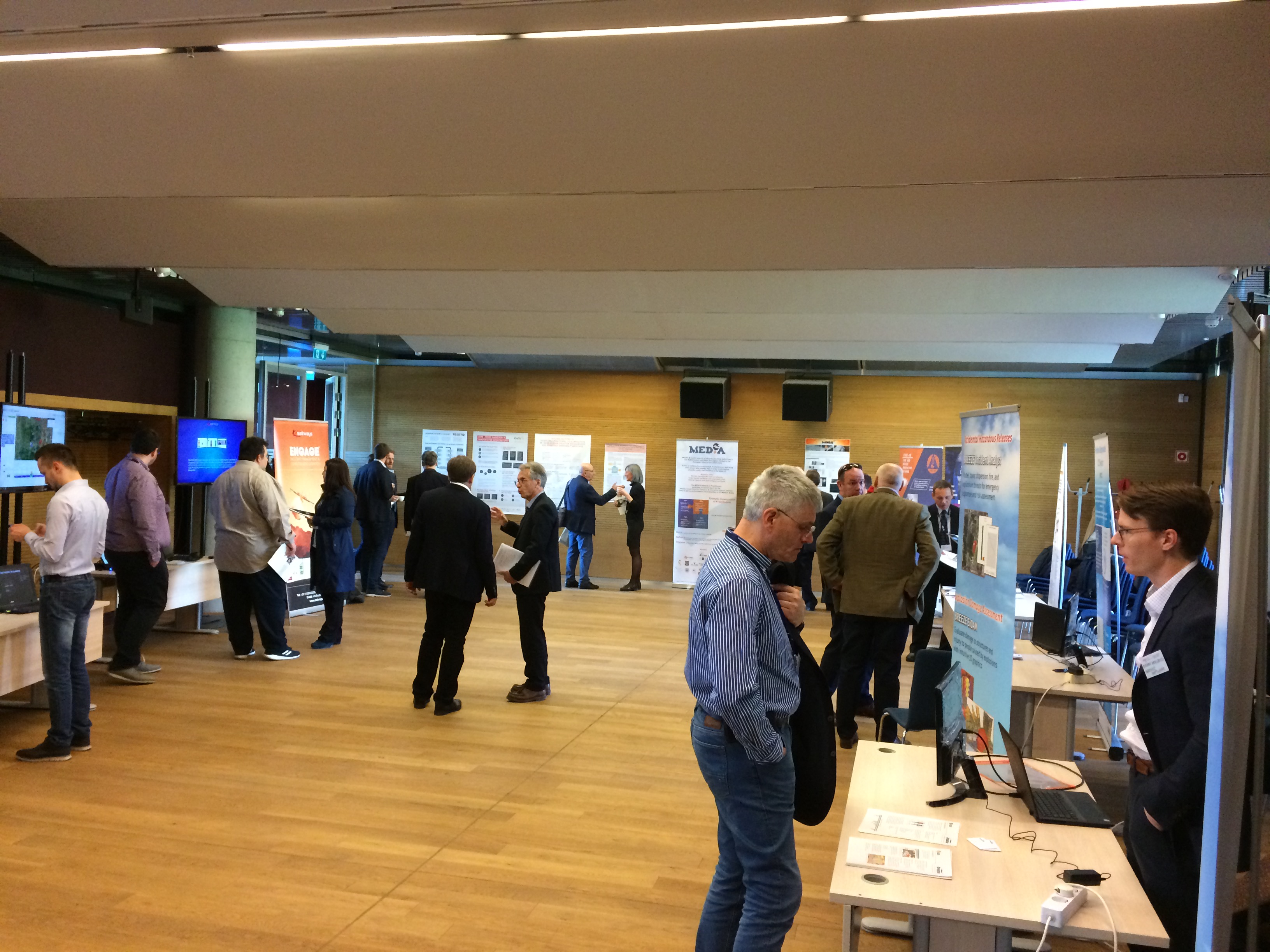
Above: The conference's Poster and Tradeshow session featured posters and information from multiple EU projects, researchers, and suppliers, as well as short courses related to the SmartResilience tool and educational platform |
|
|
|
|
|
22 Feb
2019 |
Register now for the Joint Final Conference of SmartResilience and SAYSO projects! |
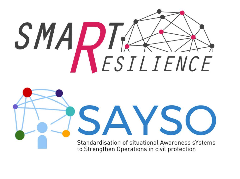 |
The SmartResilience and SAYSO H2020 projects are excited to announce their Joint Final Conference entitled "An EU Initiative Towards Advanced Situational and Enhanced Resilience." The conference will take place from April 15-17, 2019, in Budapest, Hungary.
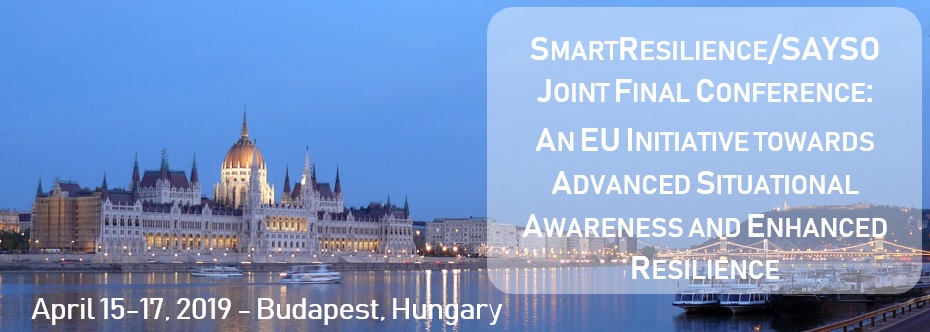
Event Details
The joint final conference of the SmartResilience and SAYSO projects will be hosted by the National University of Public Service in Budapest. The objectives of the joint conference are to present and discuss their respective outcomes as well as to discuss next steps. The conference will involve practitioners, developers, technology suppliers, and standardization and procurement specialists, as well as decision-makers, to find the best ways to harmonize, integrate, and enhance the projects’ outcomes in order to achieve tangible impact at the European level.
Registration
- Registration Fee: None (includes lunch and coffee breaks during the conference)
- Additional Costs: Conference participants are responsible for covering their own travel, lodging, and associated costs.
Call for contributions/presentations
The SmartResilience and SAYSO projects are seeking contributions/presentations related to critical infrastructure resilience and protection and to situational awareness systems in civil protection.
Proposals for contributions, including title, authors' names, and a short abstract (max. 1500 characters) should be sent to SAYSO-SmartResilience-Conference@eu-vri.eu using the application form available for download below.
Deadline: March 7, 2019
Accepted Notification: March 2019
*Please Note: Contributors/presenters should also register for the days of the conference which they will be attending!
Call for posters
Poster presentations will be displayed during a 90-minute poster session with the attendant author(s) available to discuss and present the poster (e.g. from EU or other projects). These will be scheduled on the afternoon of Monday, April 15, 2019.
Deadline: March 7, 2019
Accepted Notification: March 2019
*Please Note: Poster presenters should also register for the days of the conference which they will be attending!
Conference program
The final program is available for download here.
The projects
 The SmartResilience project provides a new indicator-based methodology for assessing and measuring the resilience level of critical infrastructures, such as energy and water supply, transportation networks and similar. The SmartResilience project provides a new indicator-based methodology for assessing and measuring the resilience level of critical infrastructures, such as energy and water supply, transportation networks and similar.
The SAYSO project aims to allow European civil protection and emergency responder organisations to procure, at a competitive price, innovative Situational Awareness systems and tools matching their needs. The production of the specifications of such solutions in SAYSO also involves suppliers, public procurement authorities and policy makers.
Access map
For information on how to reach the venue, click HERE.
Lodging
The conference organizing committee is not recommending any specific hotels for conference attendees, as we have decided this is best left to the personal tastes and preferences of each participant. However, there are many good options available near the venue, and any hotel in or near the city center should also be close to either a direct or connecting public transit line with a stop close to the conference center.
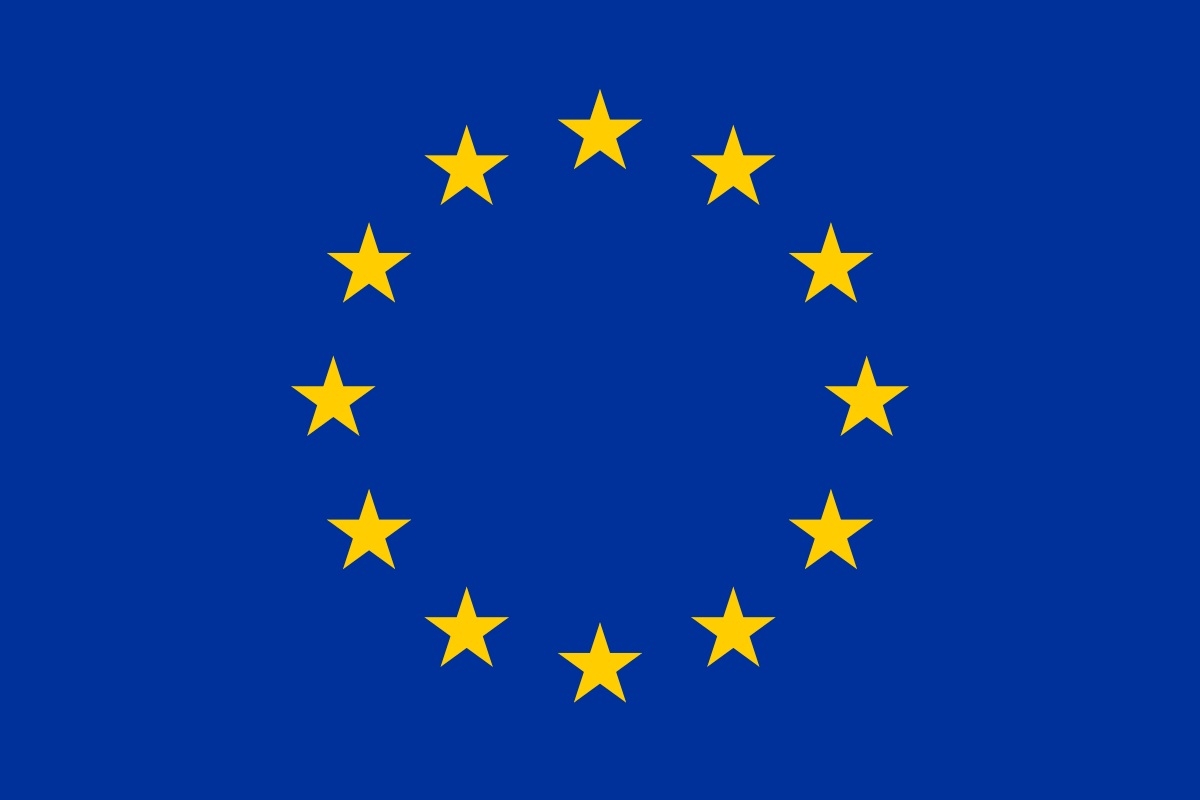 The SmartResilience and SAYSO projects have received funding from the European Union’s Horizon 2020 Research and Innovation Programme, under the Grant Agreement Numbers 700621 and 740872, respectively. The support provided by the European Commission for these projects and for their joint final conference is acknowledged and greatly appreciated. The SmartResilience and SAYSO projects have received funding from the European Union’s Horizon 2020 Research and Innovation Programme, under the Grant Agreement Numbers 700621 and 740872, respectively. The support provided by the European Commission for these projects and for their joint final conference is acknowledged and greatly appreciated.
|
|
|
|
|
|
14 Feb
2019 |
Steinbeis R-Tech and EU-VRi successfully passed the ISO 9001:2015 audit |
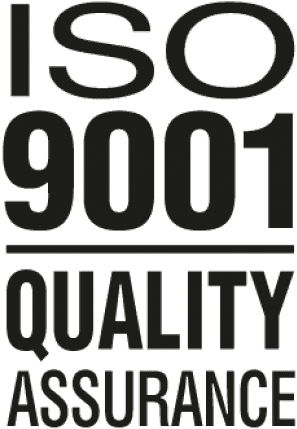 |
Steinbeis R-Tech and EU-VRi passed the ISO 9001 audit based on the 2015 revised version of the standard which is focusing on risk thinking and strategic planning.
The ZDH-ZERT audit took place on February 7-8, 2019 and showed again that the Steinbeis Advanced Risk Technology Group and EU-VRi duly improves and complies with the requirements of ISO 9001 Quality Management. The audit has covered the areas of integrated risk management and industrial safety with multidisciplinary, global and holistic approach, including education and training, information providing, innovation, professional services and consulting, products and software, project management. |
|
|
|
|
|
10 Feb
2019 |
Paper on energy indicators in Springer Journal of Thermal Science |
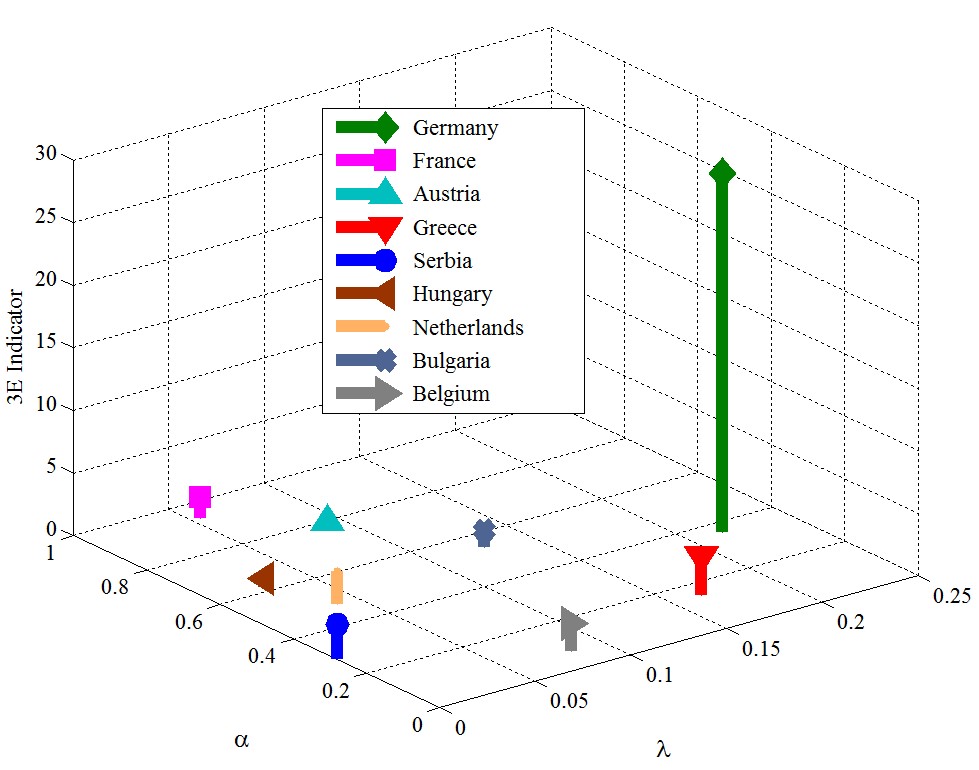 |
Steinbeis Center for Energy Technologies increased its visibility by achieving a milestone: The paper on "Evaluation of Electricity Generating System’s Technology Mix Using 3E Indicator" appeared in Journal of Thermal Science published by Springer. See more at https://rdcu.be/bjPQZ. It is also a great achievement for both Steinbeis Novi Sad and for Steinbeis Advanced Risk Technologies Group (www.risk-technologies.com). |
|
|
|
|
|
28 Jan
2019 |
SmartResilience referenced as part of the new ISO 31050 standard |
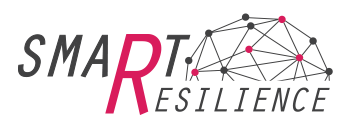 |
SmartResilience is referenced in a recent update to an International Organization for Standardization (ISO) webpage highlighting the work being done for the new standard ISO 31050 - Guidance for managing emerging risks to enhance resilience. The standard and will provide the guidance needed to deal with the "new, previously unknown or not considered, 'emerging' risks [which] can pose the greatest challenges to resilience, safety and operational and business continuity" and draws upon the work of organizations and projects including SmartResilience.
This standard is currently under development by ISO/TC (Technical Committee) 262 ‘Risk Management,’ which "develops international standards in the field of risk management to support organizations in all their activities including making decisions to manage and minimize the effects of accidents, disasters and faults in technical systems as well as response and recovery from major disruptive risks."
To learn more about the new ISO 31050 standard, visit: https://committee.iso.org/sites/tc262/home/projects/ongoing/iso-31022-guidelines-for-impl-2.html |
|
|
|
|
|
23 Jan
2019 |
Somik Chakravarty receives the Jean Bricard Prize 2019 |
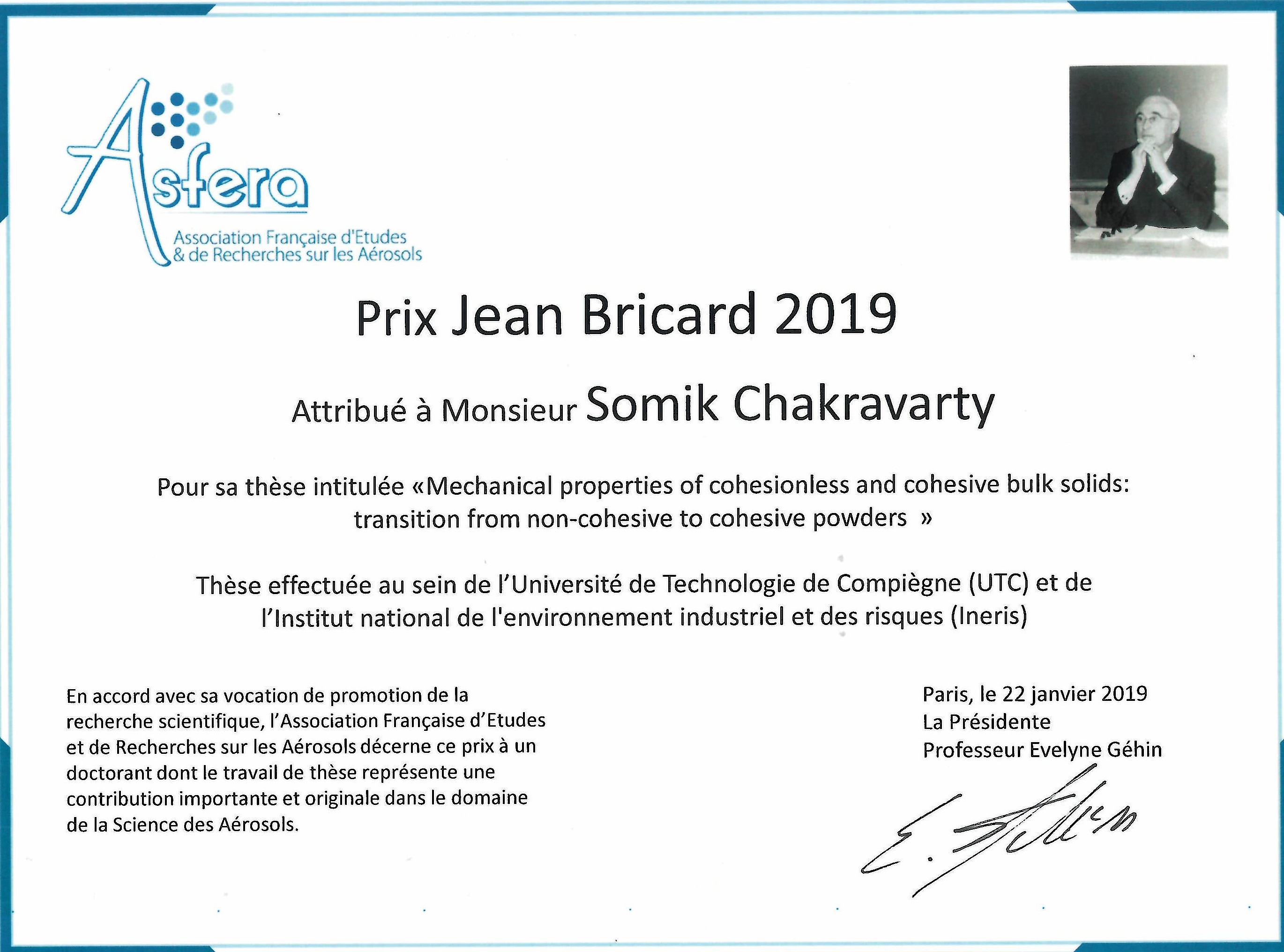 |
Somik Chakravarty (R-Tech) was awarded the Jean Bricard prize 2019 at the 32nd French Congress on Aerosols (CFA) in Paris on 22 January 2019.
Somik Chakravarty, Project Manager at Steinbeis R-Tech received the Jean Bricard Prize 2019 for his PhD thesis in Mechanical properties of cohesionless and cohesive bulk solids: transition from non-cohesive to cohesive powders. The PhD was supported by European Union Marie Curie Actions FP7 T-MAPPP and conducted at the Sorbonne Universités - UTC and INERIS, France.

Association Française d'Etudes & de Recherches sur les Aérosols (ASFERA) as a part of its mission to promote research in the field of aerosol science, awards each year the Jean Bricard Prize to a young researcher in France. More information on the prize can be found on the ASFERA website (https://www.asfera.org/fr/prixjeanbricard/presentation) |
|
|
|
|
|
09 Jan
2019 |
Participate in our stakeholder survey for the development of risk assessment tools! |
 |
Within the framework of H2020 project PANBioRA, the consortium is developing new techniques and instruments for biomaterial risk assessment. In this regard, Steinbeis Advanced Risk Technologies (R-Tech) is carrying out a stakeholder survey for the development of risk assessment tools. Please take a few minutes to fill out our survey.
We would very much appreciate your input and expertise!
|
Survey for identifying the stakeholder needs and perspectives
 
"Personalised and Generalised Integrated Biomaterial Risk Assessment''
Are you an expert working in the field of "biomaterials", "implants", "medical devices", "risk analysis", "multiscale modelling", "policies & regulations" or related fields?
Help us develop an integrated risk governance framework for biomaterials and related devices/products by participating in the survey.
Participate in our survey and receive feedback!

|
|
|
|
|
|
|
07 Jan
2019 |
SmartResilience article in Safety Science journal |
 |
The SmartResilience project is highlighted in the recently released Safety Science journal article "Quantitative resilience assessment in emergency response reveals how organizations trade efficiency for redundancy." SmartResilience Project Coordinator Prof. Dr. Aleksandar Jovanović is one of the article's co-authors.
The authors note that their "results open the obvious possibilities for optimization along several lines that could be explored in future research," including comparison of "'big-data-based indicators'...This option would open up a completely new way of looking onto the monitoring of resilience in real time, which was exactly the idea promoted by the SmartResilience project."
Read the full article at: https://www.sciencedirect.com/science/article/pii/S0925753518312013
|
|
|
|
|
|
20 Dec
2018 |
SmartResilience project announces joint final conference with SAYSO H2020 Project |
 |
The SmartResilience project is excited to announce it will be hosting its final conference in joint collaboration with the SAYSO Horizon 2020 Project from April 15-17, 2019, in Budapest, Hungary. Registration will open in early 2019. More information is available in the "save the date" invitation below.
Invitation for the Joint Final Conference
of the SmartResilience and SAYSO H2020 projects
April 15-17, 2019
Budapest, Hungary
The joint final conference of the SAYSO and SmartResilience projects will be hosted by the National University of Public Service in Budapest on April 15-17, 2019. The objectives of the joint conference are to present and discuss their respective outcomes as well as to discuss next steps! The conference will involve practitioners, developers, technology suppliers, standardisation and procurement specialists, as well as decision-makers to find the best ways to harmonise, integrate, and enhance the projects’ outcomes and achieve tangible impact at the European level.
If you wish to participate as a speaker, please contact us before January 31, 2019, at SAYSO-SmartResilience-Conference@eu-vri.eu.
The e-registration for all participants will open early 2019.
To be among the first informed, follow us on Twitter!
@SmartResilience and @SAYSO
Contributors and participants from other projects and institutions are welcome to attend.
We look forward to welcoming you in Budapest!
Kind regards,
A. Jovanovic & H. Burkow
on behalf of the SmartResilience and SAYSO Consortia

|
|
|
|
|
|
11 Dec
2018 |
SmartResilience public deliverables D3.6 and D4.4 now available |
 |
The SmartResilience project recently published two more public deliverables in the Results section of its public-facing website.
These newly posted deliverables are:
|
|
|
|
|
|
27 Nov
2018 |
SmartResilience project team to participate in upcoming international events |
 |
The SmartResilience team will be attending and participating in several upcoming international events for promotion and dissemination of the project.
These events include:
 December 2-6, 2018: December 2-6, 2018:
Society for Risk Analysis (SRA) Annual Meeting, New Orleans, LA (USA) – Professor Jovanović will be sharing the following presentation related to SmartResilience:
Analyzing Interdependencies Among Infrastructures Based on Big Data and Resilience Indicators (Jovanovic AS, Klimek P)
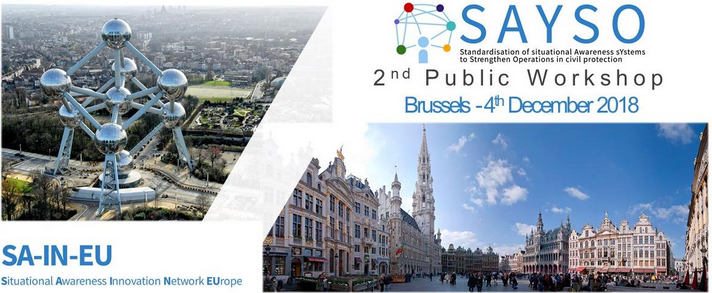
December 4, 2018:
Second Project SAYSO Public Workshop, Brussels, Belgium

December 5-6, 2018:
Security Research Event (SRE) 2018, Brussels, Belgium |
|
|
|
|
|
26 Nov
2018 |
SmartResilience project: Web updates |
 |
The SmartResilience project is excited to share several recent updates related to its web tools, including the launch of the MySmartResilience and updates to the Welcome web page of the tool.
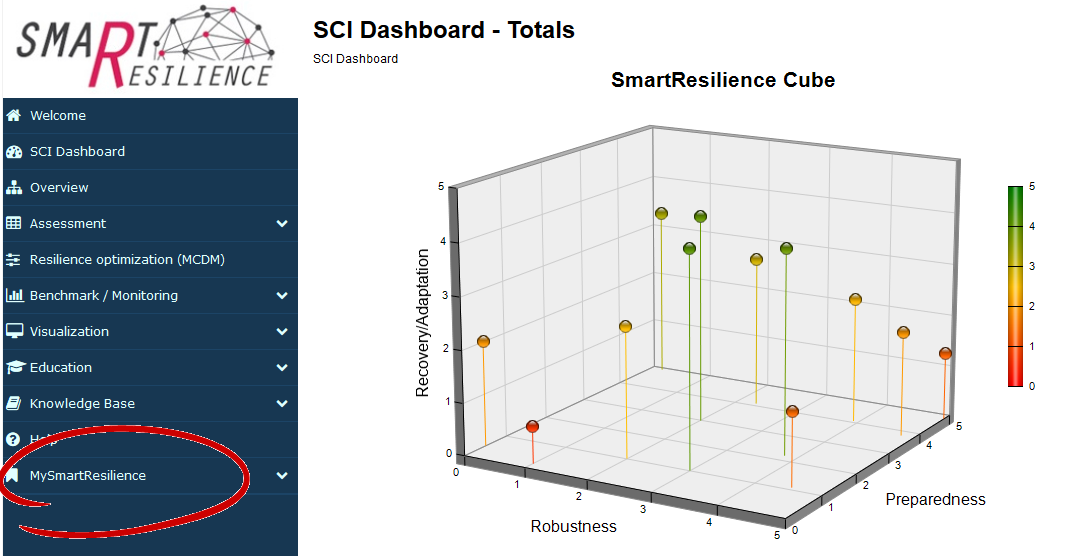
MySmartResilience Tool
A recent update to the SmartResilience web interface includes a new section of the tool called MySmartResilience that enables personalized data entry, analysis, and saving.
Project stakeholders should contact smartresilience-core@eu-vri.eu to gain access to this section of the tool.
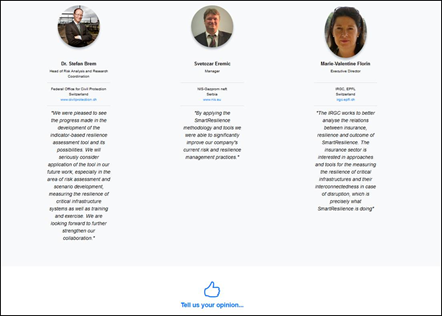
SmartResilience Welcome Web Page Updates
Two recent updates have been made to the Welcome web page of the SmartResilience tool:
1. Testimonials have been added to share end-user and project participant experiences with and impressions of SmartResilience.
2. A Feedback Survey is now available via the “Tell us your opinion” button and directly via this link: http://www.smartresilience2.eu-vri.eu/Survey_Run.aspx?ID=978. We ask that interested parties please help us by taking some time (estimated 10-15 minutes) to complete this survey to help us improve the SmartResilience tool and potential applications. This survey can be distributed to anyone who may be interested in providing feedback. There is also an opportunity included in this survey to provide a testimonial for the project.
|
|
|
|
|
|
23 Nov
2018 |
SmartResilience highlighted on WaterBriefing website |
|
|
|
|
|
|
05 Nov
2018 |
EC4SafeNano Day - 3 Open Workshops |
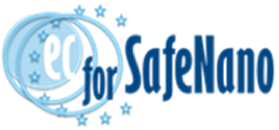 |
EC4SafeNano Day, November 5, 2018 in Grenoble, France (nanoSAFE 2018 Conference)
Let us work together to build the EC4SafeNano Centre! The EC4SafeNano project aims to bridge the gaps in sustainable production and use of nanotechnologies by understanding the safety and health risks of the technology and its end-products, and to implement practical strategies to manage the emerging risks. This is done by setting up an independent, science-based, managed Centre (hub) linked with several networks (spokes) to act at the interface between research organisations, industry, regulatory bodies, and civil society
If you are attending nanoSAFE 2018 – The Sixth International Conference organised by nanoSAFE, come join us for our one day event and get a say in building the EC4SafeNano Centre.
|

|
|
EC4SafeNano Day
Announcement and Call for Participation
3 Open Workshops at nanoSAFE 2018 – November 5, 2018
Maison MINATEC, Parvis Louis Néel, 38054 Grenoble, FRANCE
The overall objective of the EC4SafeNano project is to develop a distributed Centre of European organisations for Risk Management and Safe Innovation for Nanomaterials & Nanotechnologies. The operational objectives are therefore:
- To understand the needs of the various stakeholders.
- To identify the resources and capabilities available inside/outside the consortium to address the stakeholder needs.
- To provide solutions and build a range of services.
- To develop mechanisms and operating procedures.
- To test and benchmark the services.
- To develop a sound exploitation plan and business plan.
The project is structured around a core project partners and an enlarged community of associate partners (APs). The main objective of the open focus network is to design subject-specific focus groups. The Focus Network is accessible to everyone upon becoming a registered member by joining as an associated partner.
The EC4SafeNano Day will be organised as satellite meeting during nanoSAFE 2018. The event consists of three workshops. By participating in the event, you will learn more about our project and help us develop the centre to make it applicable in your own stakeholder context. The details of the event is given below:
|
Workshop 1: Establishment and operation of Focus Network, EC4SafeNano
(Organised by Geethu Balachandran, gbalachandran@eu-vri.eu, EU-VRi)
|
.gif) |
|
Aim: Discussing the already proposed concepts of the centre, exchange of information and services, promote the centre, collecting feedback and check the willingness of external participants to join as APs.
|
|
09:00 – 09:05
|
Welcome
|
Geethu Balachandran (EU-VRi)
|
|
09:05 – 09:25
|
Focus Group Governance - Presentation of already proposed concept and organisation of the centre
|
Emeric Frejafon (INERIS)
|
|
09:25 – 09:50
|
Focus Group Research
|
Iseult Lynch (UoB)
|
|
09:50 – 10:15
|
Focus Group Standardisation and certification
|
Patrick Berghmans (VITO)
|
|
10:15 – 10:30
|
Coffee Break
|
|
10:30 – 10:55
|
Focus Group Regulation and policy
|
Anthony Bochon (ULB)
|
|
10:55 – 11:20
|
Focus Group Safe technological innovation
|
Thies Oosterwijk (TNO)
|
|
11:20 – 11:45
|
Focus Group Education and training
|
Albert Duschl (PLUS)
|
|
11:45 – 11:55
|
General Open Discussion
|
Emeric Frejafon (INERIS)
|
|
11:55 – 12:00
|
Conclusion
|
Geethu Balachandran
(EU-VRi)
|
|
Expected Outcome: Use the feedback to adjust the centre and its functioning.
|
|
12:00 – 13:00
|
Lunch Break
|
|
Workshop 2: Blueprint for National Nanosafety Platform Development & Sustainability - BNP-DS
(Organised by Neeraj Shandilya, neeraj.shandilya@tno.nl, TNO)
|
.gif) |
|
Aim: BNP-DS will focus on the production of a blueprint (a set of guidelines for do’s and don’ts) for the development and sustainability of a nanosafety platform. It will be an interactive session between the representatives of various nanosafety platforms and other stakeholders. It is a first step towards the development of EC4SafeNano network for nanosafety platforms.
|
|
13:00-13:05
|
Welcome |
Thies Oosterwijk (TNO)
|
|
13:05-13:15
|
Importance of nanosafety platforms network and its potentials from European Commission perspective
|
Georgios Katalagarianakis (EC)
|
|
13:15-13:45
|
Critical elements for the organizational model of a nanosafety platform |
|
|
13:45-14:20
|
Interactive session among the participants |
|
|
14:20-14:45
|
One to one discussion/help desk |
|
|
14:45-15:00
|
Wrap up and concluding remarks |
|
|
Expected Outcome: Determination of organisational elements necessary for the development, sustainability and networking of a nanosafety platform.
|
|
15:00 – 15:30
|
Coffee Break
|
|
Workshop 3: Overcoming barriers to making data FAIR – integrating data management into data generation workflows-a joint workshop with H2020 NanoCommons
(Organised by Iseult Lynch, I.Lynch@bham.ac.uk, UoB)
|
.gif) |
|
Aim: The workshop aims to gain feedback on utility and user acceptability of proposed solutions to knowledge management and FAIR data and based on the user / stakeholder feedback to develop recommendations regarding solutions to maximise data sharing and data accessibility for the entire community and all stakeholders. Among the barriers to be considered, and for which best-practice solutions will be developed, are: Primary publication of data before the data are made available in a database; Labelling of the data (ontology); Confidentiality of the data; Security of the data storage and access (trust that the data are protected); Format of the data for long-term accessibility and sharing etc.
|
|
15:30 – 16:00
|
Opening and introduction to the data life cycle and the NanoCommons solution – online notebooks and their applicability to experimental scenarios of increasingly complexity up to mesocosms
|
Iseult Lynch & Anastasios Papadiamantis (UoB)
|
|
16:00 – 16:20
|
ACEnano approach integrating and streamlining data analysis and output formats for nanomaterials characterisation
|
Thomas Exner (Douglas Connect)
|
|
16:20 – 16:40
|
Adapting data management tools and platforms to industry stakeholders – stand-alone versus cloud applications
|
Antreas Afantitis (NovaMechanics)
|
|
16:40 – 17:00
|
NanoReg2 activities on data management beyond the project supporting FAIR approach |
Emeric Frejafon (INERIS)
|
|
17:00 – 17:20
|
Discussion on the solutions presented and other key barriers – suggestions to improve / adapt etc. Collection of other examples of low-cost / Open Source tools for data management / data sharing from the stakeholder community.
|
Facilitated by Iseult Lynch and Anna-Kaisa Viitanen (FIOH)
|
|
17:20 – 17:30
|
Wrap-up and key recommendations
|
Iseult Lynch (UoB)
|
|
Expected Outcome: A set of recommendations for EC4SafeNano data providers on how to capture, process and share their data to maximise its FAIRness, i.e., its Findability, Accessibility, Interoperability and Re-useability, which is essential to enable EC4SafeNano partners to provide their proposed services. Potential case studies where solutions are still missing will also be identified, which could be taken up within NanoCommons, e.g. with EC4SafeNano as the “User” of the NanoCommons research infrastructure expertise. Feedback to NanoCommons and ACEnano on their tools and services will also be provided.
|
Event Type: Open for all but registration is mandatory.
Participants: Consortium members, Associated Partners and open to all interested parties
Target Audience: Regulators, industry and consultants, academics and standardization bodies.
Organisers: E. Frejafon (INERIS), N. Shandilya (TNO), I. Lynch (UoB), A. Jovanovic & G. Balachandran (EU-VRi).
|
|
Participation in the event is free of charge and is open for all, but registration is mandatory due to limited capacity of the meeting room!
|
| The project is funded by the European Union's H2020 research and innovation programme (call H2020-EU.2.1.2.2. - Ensuring the safe and sustainable development and application of nanotechnologies; grant n° 723623). |
|
|
|
|
|
|
30 Oct
2018 |
Prof. Jovanović interviewed regarding risk standardization |
 |
Prof. Aleksandar Jovanović recently gave an interview for the leading German economic newspaper Wirtschaftswoche, recognizing the importance of standardization work in the area of risks. EU-VRi, Steinbeis, and Prof. Jovanović are long-time active leaders in the area of standardization related to emerging risks, currently working on a new ISO standard, ISO 31050 Guidance for Managing Emerging Risks to Enhance Resilience.
The original article is available in German here: http://www.inpactmedia.com/wirtschaft/risikomanagement/wir-brauchen-standards-fuer-globale-risiken#2287. A translated version in English is provided below:
»We need standards for global risks«
Globalization is driving forward world networking. But with complexity also comes risks. How can you correctly assess a threat situation? Are we even worried about the "right" things?
Klaus Lüber, Editorial Staff
And how can you handle risks that have global implications? An interview with Prof. Aleksandar Jovanović, Head of the European Virtual Institute for Integrated Risk Management (EU-VRi).
KL: Mr. Jovanović: natural disasters, infrastructure damage, political imponderables, supply chain disruption, piracy, sabotage, cybercrime - the number of risks in international business seems to be growing. Is that really the case, or is it just because we know more and more about risks?
AJ: That's not so easy to answer. What does "growing" mean? What we do know is that the present has become more complex and often entails new risks. As a system becomes more complex, in general, the risks become more complex, and the number of potential and new risks increases. The problem is that in order to really assess a threat situation, we need reliable reference points. At the “regulars” table you can talk about the real dangers of climate change at length, but as long as you do not have a reliable framework to define priorities, criteria and decision-making processes (when it comes to risk assessment) all remain just a roundtable discussion.
KL: You could consult experts.
AJ: Yes, of course you could, and of course you do, but that does not really make you “pass.” For example, if every expert has a different opinion, we get a collection of responses in silos. This is a very unfavorable situation, especially when dealing with complex risks, because here [with complex risks] it is particularly important to act interdisciplinary and to see the "big picture."
KL: Do you mean [to imply] action guidelines for companies and institutions?
AJ: Right, and here comes the next challenge: the classification of responsibilities - "mandates" - has also become more complex. As a result, it is often the very institutions that are supposed to exercise these mandates globally, such as the UN or the EU, which become increasingly powerless or unfree in doing so. At the national level, it is often not much better. Although consensus on dealing with complex and systemic risks is certainly very important, as well as [achieving] the acceptance of as many people as possible, the reluctance of an institution [to act], such as a competent ministry which actually has power to act on an issue such as “coal exit,” is out of place.
KL: What is the general policy in the area of risk management?
AJ: In my opinion, there is definitely room for improvement. Many authorities and institutions have long lost much of their expertise and have many specialist personnel issues. Take the cybercrime field: since it is often impossible for authorities to engage the right IT professionals to provide the TVL-like conditions, many “cybersecurity centers” lack the right professionals or expertise.
KL: What about the situation with companies? Do they usually have more financial leeway?
AJ: That's right, but they have the problem of having to decide whether to invest long-term or short-term. For example, insurers who have been dealing with risk management issues for years often have to balance the investments they have in short or long-term risks because they cannot always afford the required research on the long-term, more complex risks. As in politics, they are simply less and less interested in long-term planning. It's worth less or even nothing at all.
KL: Let’s speak [more] concretely about the risks that we are dealing with in business and society. The sociologist and risk researcher Ortwin Renn, with whom you have worked for many years, sees the greatest danger in so-called systemic risks.
AJ: Yes, Mr. Renn means risks that can have global implications, are closely networked with many functional areas of the economy and society, and have cause-and-effect chains where we cannot get by with a classic, statistic-based approach. Here we need a fundamental change of perspective.
KL: What do you mean?
AJ: One should say goodbye to the idea that one could simply avoid or combat systemic risks like an external disturbance. The truth is that it is no longer about avoiding risks but understanding them as best as possible and preparing for them in the best possible way [in order] to ensure the resilience of the systems. That's one thing. The other is that solving complex and global problems usually has to be complex and global. Global also in the sense of "integrative" and "integrated".
KL: You have to explain that, please.
AJ: The decisive factor is the integration of various solutions into integrated risk management. That is exactly what we are doing at the EU-VRi, [the Virtual] European Institute for Integrated Risk Management. In doing so, one must try to consider all the different sources, including those, for example, that can cause or promote the misperception of risks in social networks. Nowadays, you have to be able to analyze the large amounts of data available – “Big Data” -, to be able to analyze new methods and have new analysis software. This is the only way to detect new trends in risks in good time: by observing them in real time and to derive recommendations for action from them. It is very useful to compare these results, which you can get without experts, with expert opinions.
KL: So risk analysis tools alone are not enough [to avoid risks]?
AJ: No, because even with these tools you will hardly be able to avoid them; new solutions also generate new risks. A classic example is the risk of Alzheimer's disease. That [risk] is one in a hundred at the age of 65 but one in six at the age of 85. One could say: by avoiding the risks that lead to an early death, at the same tome you increase the risk of developing [other] diseases that increase [in risk] with age. That this pattern is repeated in other fields, such as the exit from coal, autonomous driving, or Industry 4.0, is to be expected.
KL: These are topics in each of which the aspect of social acceptance plays a role. Now many of your colleagues say that we often cannot assess risks properly. Isn’t it first of all a matter of distinguishing "real" from "fake" risks?
AJ: Of course you can do that, but you should be careful not to take so-called "false" risks less seriously. For a long time, insurers have had their own term: phantom risks. Although they have no material, statistical basis, they should still play an important role in a risk analysis. To perform a full risk analysis, one must consider factors such as risk perception and social acceptance. If technology is accepted in one corner of the world and not in another, it is important to understand why.
KL: Like, for example, the Transrapid?
Exactly. A cutting-edge technology that has not found social acceptance. Not least of all because the risks associated with the Transrapid in Germany and the classic train have been considered and categorized. Then it would be, as in every train, an emergency brake would be required on the Transrapid, while nobody would think of installing one in an airplane.
KL: What recommendations do you give to politics and business?
AJ: It's all about recognizing the importance of frameworks for efficient risk management. Just as we have agreed in many countries to drive to the right or measure speed in km/h, we also need more commonly accepted risk and resilience management standards in risk research - such as the new ISO 31050. That's because we need maximum clarity and the above framework in the implementation. Only then will we have a chance to prepare efficiently for the challenges of old and new risks. |
|
|
|
|
|
16 Oct
2018 |
Workshop on Risk Based Inspections (RBI) and the new EU standard EN16991 |
 |
On October 16, 2018, Steinbeis R-Tech and EnBW organized a workshop devoted to the new EU standard on Risk-Based Inspection (RBI) EN16991:2018, published on May 1, 2018. Participation in the workshop was free of charge.
|
|
Workshop
Risk Based Inspections (RBI)
and the new EU standard EN16991
Concept and application
October 16th, 2018
EnBW City, Schelmenwasenstraße 15, 70567, Stuttgart-Fasanenhof, Germany
Main topic:
On May 1st, 2018 the new EN16991:2018 standard was approved. It establishes the basis for application of European standardization in the area of RBI in Europe and worldwide. Following the pre-standard CWA 15740:2008/2011, the new EN16991 is aligned with API RPs and supported by national documents such as VGB 506-S. Already mentioned in the legislation of several countries, the standard supports a more efficient and effective inspection and maintenance planning in the industry (power, process, other). At the same time, it improves risk management and thus, safety, of the plants and their operation, including all aspects of improved environment and business management. This workshop is designed to present detailed information about the standard and its present and future applicability in industry.
Goals of the workshop:
• Understand the basis for Risk Based Inspection methodology, in particular in power and process
industry
• Understand the new EN16991:2018 standard, its details and implications
• Show how the standard is practically used
• Insights into other RBI standardization efforts such as the German VGB 506-S
Workshop program:
| 09:00 - 09:30 |
Registration and introduction |
| 09:30 - 10:45 |
RBI Introduction
- General principals of risk assessment and management (ISO, EN, national)
- General approaches to Risk Based Inspections (world, EU, Germany andcompanies) |
| 10:45 - 11:00 |
Coffee break |
| 11:00 - 12:30 |
RBI application
- Practical assessment of Probability of Failure (PoF) and Consequence of Failure(CoF)
- Implementation of tools and systems
- Application examples in the power and process industries |
| 12:30 - 13:30 |
Lunch break |
| 13:30 - 14:00 |
Presentation of the new EN16991 standard |
| 14:00 - 15:00 |
EN16991 - Concept and requirements
|
| 15:00 - 15:15 |
Coffee break |
| 15:15 - 16:45 |
EN16991 - practical applications |
| 16:45 - 17:00 |
Final discussion and closure |
|
Register here for the workshop, free of charge:
Risk Based Inspections (RBI) and the new EU standard EN16991 Concept and application
How to reach EnBW City
Main Speakers:
A. Jovanovic, R-Tech
J. Bareiß, EnBW
K. Metzger, GKM
A. Carlebur, NEN (tbc)
Note
The event is organized back-to-back to the 44th MPA seminar - "Fit for Future":
MPA seminar - October 17-18, 2018
|
|
Participation in the workshop is free of charge and is based on limited free seats; therefore, registration is mandatory!
Contact the organizers at RBIworkshop@risk-technologies.com
|
|
|
|
|
|
|
01 Oct
2018 |
EU-VRi and Steinbeis R-Tech jointly commenced the ERRA initiative |
 |
ERRA - The European Risk & Resilience Assessment and Rating Agency
|
|
ERRA
The European Risk & Resilience Assessment and Rating Agency:
going beyond compliance
Why ERRA?
In the spirit of new policies (e.g. the EU directive on non-financial reporting), ever increasing social responsibility and awareness, and the needs of globalized economies (e.g. overcoming differences in compliance rules in different countries), the need to prove that one is investing efforts in “SAFETY BEYOND LEGAL COMPLIANCE” and “STAYING RESILIENT WHEN AFFRONTING NEW RISKS” will increase.
The ERRA Agency, proposed here and based on the outcomes of the EU project SmartResilience, intends to help prove the effectiveness of the above effort, e.g. by means of RECOGNIZED VOLUNTARY AUDITING performed by the network of partners acting through the Agency.
ERRA Agency and the SmartResilience project
Ensuring sustainability of the SmartResilience project results after the project ends in April 2019 was one of the major triggers for the ERRA initiative. ERRA would thus be one the three main sustainable and lasting results of the project after the project ends:
1. Encoding the project approach and the main results in an ISO standard (ISO 31050)
2. Leaving the 2,500+ indicators, the methodology, and the software tool (web) as an “open system,” possibly on the EU/JRC platform
3. Creating a business model based on the project and its results – both for project partners and the community: The “European Risk & Resilience Assessment and Rating Agency” (ERRA).
The ERRA concept is being elaborated (2018/19) by EU-VRi as a part of the SmartResilience project deliverables.
ERRA concept cornerstones
The concept of ERRA relies on the following main documents:
i. SmartResilience resilience-indicator-based methodology documents and checklists (project deliverables)
ii. ISO 31000/31050 and 223xx-series
iii. EU Directive on non-financial reporting
iv. Cooperation agreement with key risk and resilience institutions worldwide (e.g. EU, JRC, ANL, PSC, BJAST…)
v. Cooperation agreements with Agency service-sub-providers
and on the following main tools:
i. SmartResilience system (open/free)
ii. Optional: Agency members’ tools as options (the respective network member’s conditions)
|

ERRA Services:
Risk and resilience “Assessment-as-a-Service”
The main ERRA service (risk and resilience “Assessment-as-a-service”) will be performed by the Agency together with and subcontracting by Agency member organizations (organizational members AND individuals) having the different competencies needed to meet the specific needs of specific industry branches or application areas (e.g. critical infrastructures or new technologies). In the most general terms, ERRA would contact and negotiate with the customers, engage the experts among the Agency members, process the contracts with the customer and guarantee the quality of assessment provided by the Agency. Main service provided to the Agency clients would be:
1. SELF-ASSESSMENT – free service
The customer registers at the page, submits request for using the online ERRA (SmartResilience) tool and, request approved, get the access to the tools and supporting documents. There are no fees, but the assessment (anonymized) remains in the pool and can be analyzed (big data) or viewed by other users.
2. AUDITED SELF-ASSESSMENT – auditing fees
The self-assessment report is audited by the ERRA appointed auditors. The fee for the audit apply. ERRA issues an audit certificate.
3. ERRA-performed AUDIT – full audit fees apply
ERRA appoints assessors/auditors, they do the assessment and produce the report. ERRA issues the full audit certificate.
Supporting services of the Agency
1. Education
(e.g. including certified courses in the area of risk and resilience)
2. Certification and management of auditors
(certification scheme to be accredited)
3. Managing/facilitating ad-hoc consultancy
(e.g. the consultancy provided by the members)
4. Research coordination and facilitation, as well as other actions which may arise from the Agency client’s needs
Members, in the due course, may also offer further member-specific service through the Agency.
Basic rule of engagement for the Agency members
The Agency itself is envisaged to be registered in Germany as a service-oriented company. EU-VRi, its members and the SmartResilience project partners will be offered the first “say” in the process of establishing the Agency. After that, the access to Agency membership should be open to all interested parties, signing the agreement) with the Agency. Agency members can be both institutions/organizations/companies and individuals. The possibilities for obtaining the start-up support of the EU-ESA will be explored.
|
|
Contact: : A. Jovanović, EU-VRi and B. Caillard, EU-VRi at erra@eu-vri.eu
|
The ERRA initiative for creating the European Risk & Resilience Assessment and Rating Agency is supported by the following potential stakeholders (The “support’’ means the stakeholders have explicitly confirmed interest being in favor of the effort to explore the needs and opportunities for creation of the European Risk and Resilience Assessment and Rating Agency in the framework of the WP9 of the SmartResilience project; this implies that the stakeholder will be regularly informed about the progress of the initiative and be given a possibility to contribute to the definition of its outcome.):
|
International Organizations
- EPFL IRGC, Switzerland
- ESA-NTTI, Hungary
- ESA-BIC, Hungary
- EU-VRi, Germany
- …
Industry
- NIS, Serbia
- Steinbeis StC, Germany
- Technologica Group, Belgium
- …
National Organizations
- City of Edinburg, Scotland
- VTT, Finland
- …
Research
- IBM, Israel
- SINTEF, Norway
- Steinbeis R-Tech, Germany
- …
Academics
- BUW, Germany
- KU Leuven, Belgium
- Medical Uiniversity Vienna (MUW), Austria
- …
|
|
|
|
|
|
|
|
|
13 Sep
2018 |
SmartResilience Selection of CORE DCL ISSUES & INDIA Workshop in Brussels |
 |
SmartResilience Project Partners met in Brussels on September 11-12, 2018, in order to discuss the CORE list of issues and the INDIA case study. On the first day, Prof. Jovanović introduced the concept of the CORE dynamic checklist (DCL) and presented the SmartResilience tool. During this day, the workshop participants also reviewed the issues and finalized the CORE DCL. On the second day, a tabletop exercise was conducted to simulate cascading and ripple effects on combined scenarios (CASE STUDY INDIA). |
|
|
|
|
|
16 Aug
2018 |
Beijing Academy of Science and Technology, Steinbeis, R-Tech, and EU-VRi sign a collaboration agreement in the area of Risk Management. |
|
|
|
|
|
|
01 Aug
2018 |
The work on the new ISO 31050 Standard started |
 |
On July 27, 2018, the ISO Technical Committee TC26 approved work starting on the development of the new standard ISO 31050 Guidance for Managing Emerging Risks to Enhance Resilience, under the convenership of EU-VRi.
Download the leaflet at https://www.eu-vri.eu/filehandler.ashx?file=16526.
|
|
ISO31050
Guidance for Managing Emerging Risks to Enhance Resilience: Thriving in a World Growing in Uncertainty
Why ISO31050?
At the current pace of change, the world in the 21st century will experience 20,000 years of advancements, in just one 100 years (WEF, 2016). This is changing the risk landscape and bringing in an avalanche of new uncertainties and new emerging risks the management of which is essential for the society.
The new ISO31050 standard will provide the much needed foresight and insight to deal with these risks. It will also provide new ways for enhancement of organizational resilience and new capabilities to deal with new challenges, helping, at the same time, to increase the level of trust in management of risk.
ISO31000:2018 as a “generic standard”
The newly revised and published International Standard on Risk Management ISO31000:2018 is created, monitored and supplemented (with supporting documents) by ISO Technical Committee TC262. ISO31000 standard is one of the few ISO Standards (of the several thousand promulgated by top experts in their fields) that is qualified as a "generic ISO standard" – this means that all other standards must accommodate and align to its provisions.
Therefore, it is mission critical for every entity utilizing ISO Standards, to address and strategically approach risk management and, when doing so, to follow ISO31000.
New (“emerging”) risks
New, previously unknown or not considered, “emerging” risks can pose the greatest challenges to resilience, safety and operational and business continuity. These “new and/or increasing” risks can be related to different areas of activities, such as new processes, new technologies, new types of workplace, or social or organizational change.
They can also be some long-standing issue, newly considered as a risk due to a change in social or public perceptions or due to new scientific knowledge. The increasing behavior of these risks means that the number of hazards leading to the risk may be growing, or that the exposure to the hazard leading to the risk is increasing, or that the effects/impacts of the hazards are getting worse (e.g. seriousness of effects and/or the number of people affected). These risks will interrelate with the processes like globalization, digitalization, innovation, cross boundary operations and many others, inextricably, directly or indirectly influencing each other, being interconnected, systemic and/or interdependent.
|

ISO31050:
A new member of ISO31000 family
Starting from the ISO31000 definition of risk (“effect of uncertainty on objectives”) and understanding risk management as significant contributor to value creation and preservation, the new
"ISO31050 Guidance for Managing Emerging Risks to Enhance Resilience"
will contribute to the further development of integrated management processes that provide insight into how risk may affect the achievement of organization objectives. The development of the standard is assigned to the Work Group 8 (WG8) of the Technical Committee TC262. The work started in June 2018, taking DIN SPEC 91299 (CWA 1664), the work of the ISO TC292 (ISO 223xx standards) and the works of organizations such as OECD, SRA, WEF and EU (projectsiNTeg-Risk and SmartResilience project, ResiStand) as its main reference.
The main calling is to provide universal, yet meaningful guidance on developing new competencies and business models to create relevant and realistic recommendations in an ever-changing uncertain world, to facilitate best practices, enhance resilience, promote agility, assist transformation, deliver insight, insure foresight, establish value and integrate resources.
With ISO31050, the decision makers in organizations will be better equipped to manage both known (ISO31000) and emerging risks (ISO31050) with confidence. To this aim, ISO31050 will, deliver:
- Structured context (e.g. definitions, drivers, metrics, …) for dealing with emerging risks
- Emerging risk management framework
- Process
- Guidance for
o Common format(s) for interoperability
o Common/agreed indicators
o Considerations related to emerging risks in resilience assessment
- Emerging Risk application examples
(informative annexes, exact list yet to be defined)
The work plan foresees to:
- deliver the 1st WD (working draft) on Sept 30, 2018
- prepare the CD (committee draft) by January 2019 for the ballot in February – March 2019
- finalize DIS (draft international standard) by March 2020 and
- publish the standard in June 2021.
|
|
Contact: A. Jovanović, EU-VRi (convener) jovanovic@eu-vri.eu; R. Civet, AFNOR (secretariat) rodolphe.civet@afnor.org
ISO31050
Guidance for Managing Emerging Risks to Enhance Resilience
TC262 Risk Management – WG8: Members (as of July 27, 2018)
|
Countries, Liaisons, NSBs
|
Number of persons
|
|
1. Argentina
|
1
|
|
2. Canada
|
1
|
|
3. Colombia
|
1
|
|
4. Finland
|
1
|
|
5. France
|
4
|
|
6. India
|
1
|
|
7. Indonesia
|
1
|
|
8. Ireland
|
3
|
|
9. Italy
|
1
|
|
10. Japan
|
3
|
|
11. Malaysia
|
1
|
|
12. Mexico
|
1
|
|
13. Portugal
|
1
|
|
14. Spain
|
1
|
|
15. Switzerland
|
1
|
|
16. United Kingdom
|
2
|
|
17. United States
|
2
|
|
Liaison: TC251 Asset Mgmt.
|
1
|
|
Liaison: EU-VRi (Convener)
|
1
|
|
NSB: AFNOR
|
1
|
|
Total
|
29
|
|
|
|
|
|
|
|
|
14 Jun
2018 |
SILICOFCM Kick-off meeting, Kragujevac, Serbia 14-15 June 2018 |
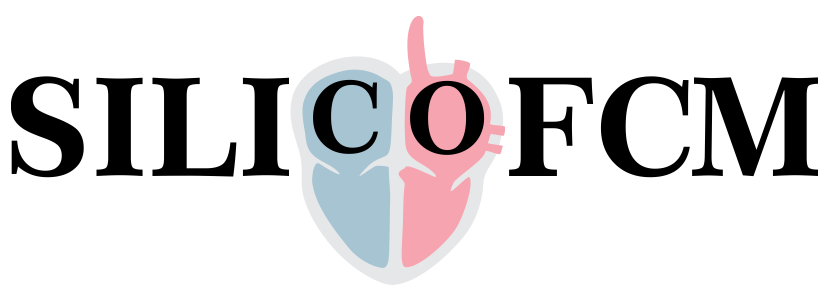 |
|
|
|
|
|
|
04 Jun
2018 |
€100 billion for FP9 "Horizon Europe" |
 |
The EC announced the proposed budget of €100 billion and the name of the next EU Research & Innovation Framework Programme: Horizon Europe (2021-2027)
|
|
|
|
|
|
30 May
2018 |
SmartResilience Open Workshop and CIRAB Meeting |
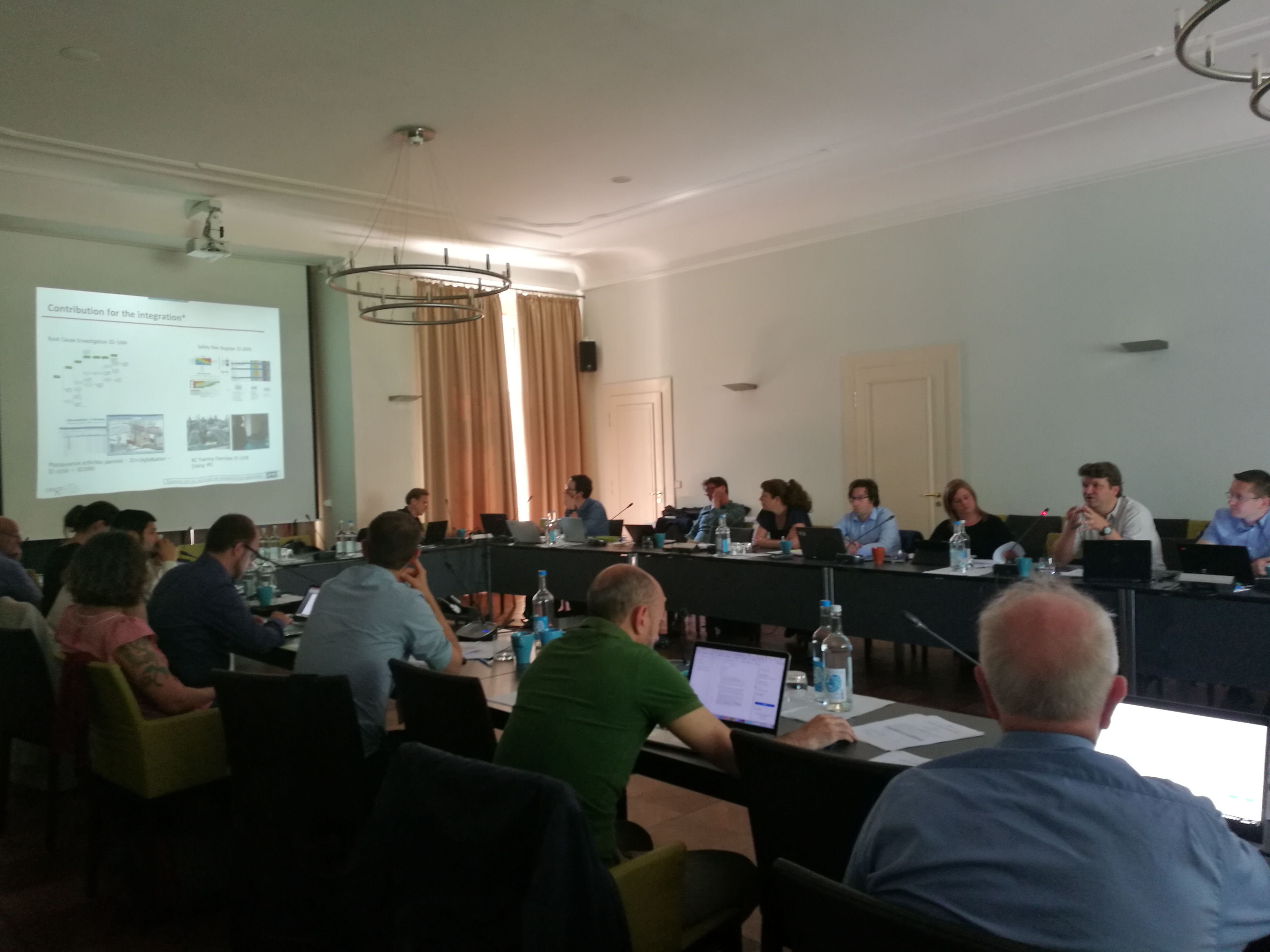 |
SmartResilience Project partners, members of Critical Infrastructure Resilience Advisory Board, insurance experts, and representatives of different research institutes, as well as end-users, met in Potsdam on May 29, 2018, in order to discuss the progress of the work done in the project and align the further actions needed for the remaining 11 months of the project.
Around 40 participants from all over the world (China, USA, France, etc.) gathered together in the premises of Institute for Advanced Sustainability Studies in Potsdam. During the 1-day workshop, the most tangible results of the work done in the project were presented. Project partners higlighted the specific issues tackled by their case studies, showing the indicators which they have selected for the assessment as well as their contribution to the integrated network/tool developed within SmartResilience. Furthermore, application of SR Tool on other EU DRS project has been presented by dr Emanuelle Bellini, coordinator of RESOLUTE.
In the second part of the meeting, Frederic Petit from Argonne National Laboratory presented the need to promote a global approach to resilience.
At the end, the Chair of Critical Infrastructure Resilience Advisory Board, Prof. Claudio Rolandi, and coordinator of the project, Prof. Aleksandar Jovanović led a fruitful panel discussion about the challenges related to resilience management, perspectives on enterprise resilience, and engagement of relevant politicians.
|
|
|
|
|
|
28 May
2018 |
EU-VRi releases the Annual Report 2017 |
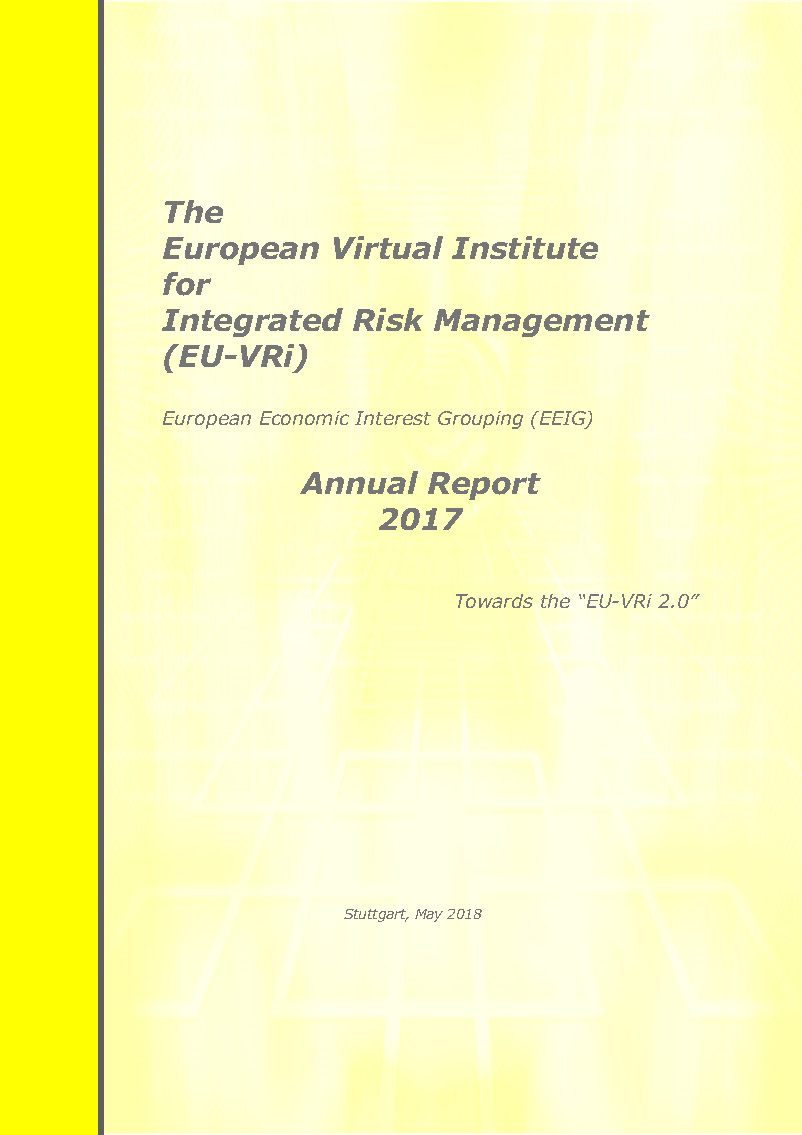 |
The report contains the representative running projects of EU-VRi, and introduces the new model of "Membership-as-a-Service".
The EU-VRi management has been reorganized, newpersons got involved. While maintaining ALL the main benefits for the current membership model starting with the project acquisition and including proposal preparation, project management, liaisoning and networking, dissemination, exploitation & implementation, standardization and education & training, the new model of “Membership-as-a-Service” has been introduced.
Downdload the Annual Report at https://www.eu-vri.eu/filehandler.ashx?file=16527.
The new model of “Membership-as-a-Service” means that the members can now choose between the fixed membership fee and “paying-per-service” and can, thus, participate in, e.g.:
1. Setting up new EU and industrial projects (large proposals prepared in 2018 e.g. for DRS calls)
2. Preparation of the new ISO 31050 standard (“Emerging risks and resilience”) and other standards
3. Collaboration agreements with leading US, Chinese and Japanese institutions (e.g. with Argonne NL or Beijing Academy of Science and Technology)
4. Sharing tools and resources developed by EU-VRi (databases, project results, reports…) free of charge.
This course will be pursued also in 2018 and this opens new horizons for further scientific and business activities for EU-VRi and all its members.
Downdload the Annual Report at https://www.eu-vri.eu/filehandler.ashx?file=16527. |
|
|
|
|
|
14 May
2018 |
NanoFASE Hands-on Stakeholder Consultation |
 |
Stakeholder Consultation, May 14, 2018 in Rome, Italy (SETAC Meeting)
Help shape the NanoFASE Framework! The NanoFASE integrated environmental Exposure Assessment Framework applicable to engineered nanomaterials will enable understanding and prediction on the "exposure" side of the risk assessment equation (Risk = Exposure x Hazard).
If you are attending SETAC Rome – SETAC Europe 28th Annual Meeting, come learn about concepts and approaches underpinning our "Exposure Assessment Framework" and help us tailor it to be even more suited to your specific needs in the Regulatory, Industrial or Research sector.
|

|
|
NanoFASE Hands-on Stakeholder Consultation
Announcement and Call for Participation
Ancillary Workshop at SETAC Rome – May 14, 2018
Meeting Room 10, Cloud, New Rome-Eur Convention Centre
Viale Asia, 40
00144 Rome, Italy
Progress is needed in the prediction of environmental distribution, concentration and form (speciation) of nanomaterials, to allow early assessment of potential environmental and human exposure and risks, to facilitate safe product design and to include these aspects in nano regulation.
The NanoFASE project coordinated by Claus Svendsen (NERC) aims to address these needs principally through the delivery of an integrated Exposure Assessment Framework (protocols, models, parameter values, guidance etc.) that:
- Allows all stakeholders to assess the environmental fate of nano releases from industrial nano-enabled products,
- Is acceptable in regulatory registrations and can be integrated into the EUSES model for REACH assessment,
- Allows industry a cost-effective product-to-market process, and
- Delivers the understanding at all levels to support dialogue with public and consumers.
NanoFASE seeks to provide a level of engineered nanomaterial fate and exposure assessment at least comparable with that for conventional chemicals. For that, our 35 partners are developing a set of novel concepts and approaches, which underpin the Framework and accompany your assessments.
Our stakeholder consultation to bring the Framework to a new level will take place in the conference center at SETAC (Society of Environmental Toxicology and Chemistry) Rome – SETAC Europe 28th Annual Meeting. Sign on to explore the scope and practicalities of the NanoFASE Exposure Assessment Framework and influence its form and applicability.
The 2-hour consultation on the afternoon of Monday, 14 May is a hands-on guided tour through the NanoFASE Clickable Exposure Assessment Framework using case study particles as exemplars. These include metal and metal oxide materials used in products such as antifouling paints, textiles, photocatalytic coatings for roads, inks, waste water treatment additives, and ground water and soil remediation products. Our approach encompasses value chain pathway analysis, transport and transformation processes throughout air, soil, freshwater, marine and biotic environmental compartments.
By participating in the consultation workshop, you will learn about concepts and approaches underpinning the NanoFASE Exposure Assessment Framework, and shape the interface to make it applicable in your own stakeholder context.
Program:
Start: May 14, 2018 16:30 - Refreshments provided
|
| 16:30-17:00 |
Welcome & Scientific Introduction
|
| 17:00-17:30 |
Three parallel expert group discussions (regulators, industry/consultants, researchers and standardization bodies) working through selected case studies under NanoFASE scientists' guidance
|
| 17:30-18:00 |
Mixed group discussions
|
| 18:00-18:15 |
Reporting and summarizing of stakeholder feedback
|
| 18:15-18:30 |
Conclusion & Closure
|
|
End: May 14, 2018 18:30
|
Meeting Type:
Selected participants only, to ensure representation of the full scope of stakeholders. Max no. of participants: 24. For stakeholders who cannot attend the event at the venue or in case of more participants than we can accommodate in Rome, a "reporting and follow up" webinar will be organized in June 2018. Please select separately for the webinar in the registration link.
Target Audience:
Regulators, industry and consultants, academics and standardization bodies.
|
Organizers: C. Svendsen & L. Walker (NERC), C. Mays (Symlog), G. Balachandran & A. Jovanovic (EU-VRi).
|
|

REGISTER HERE:

Registration Deadline: April 20
NOTE: As the number of participants is limited to 24, a final confirmation regarding the acceptance will be provided by April 23, 2018.
Contact: Ms. G. Balachandran at:
gbalachandran@eu-vri.eu
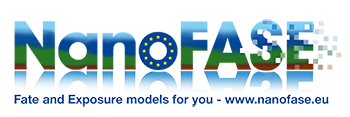
www.nanofase.eu
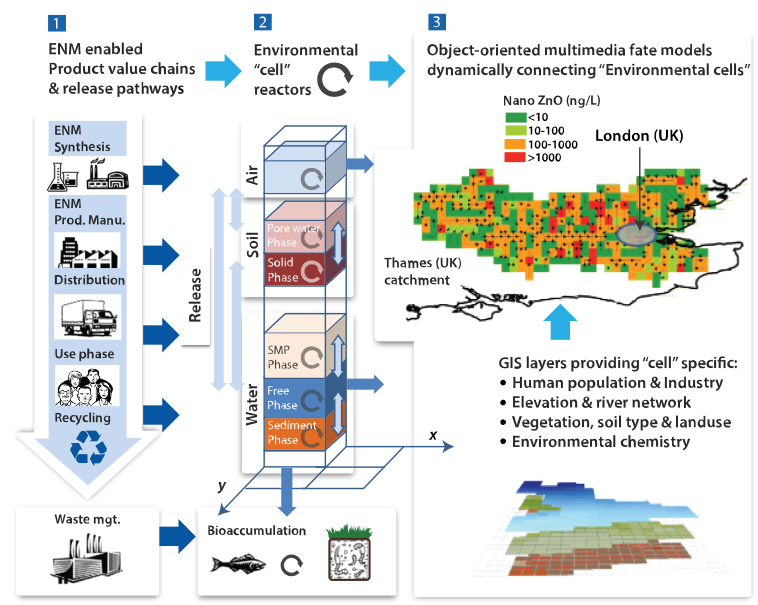
NanoFASE Exposure Assessment Framework
The project has received funding from the European Union's H2020 research and innovation programme (call H2020-EU.2.1.2.2. - Ensuring the safe and sustainable development and application of nanotechnologies; grant n° 646002).
|
|
Participation in the workshop is free of charge for SETAC attendees and also for webinar participants, but registration is mandatory!
|
|
|
|
|
|
|
30 Apr
2018 |
ResiStand project finished |
 |
The H2020 project ResiStand (Increasing disaster Resilience by establishing a sustainable process to support Standardisation of technologies and services, www.resistand.eu) was successfully finished end of April 2018.
ResiStand is a two-year project (May 2016 - April 2018) that aims to identify new ways to improve the crisis management and disaster resilience capabilities of the European Union and individual Member States through standardisation. Whilst standardisation is a powerful tool with the potential to maximise technical, procedural, operational and semantic interoperability, there is a need to overcome apathy and limited participation from stakeholders. ResiStand contributed to an improved disaster resilience by identifying and analysing the drivers, constraints and expectations of three main stakeholder communities: Standardisation Organisations, End-Users, and Suppliers, consisting of researchers, industry and SMEs.
ResiStand’s partners worked with these communities to identify standardisation gaps and to create a prioritised roadmap for new initiatives. The roadmap was complemented by a critical evaluation of standards as a tool to improve disaster resilience. Additionally, ResiStand implemented a pre-standardisation process that supports the development of standards.
The overall objective of ResiStand was to identify new ways to improve the crisis management and disaster resilience capabilities of the European Union and of individual Member States through standards. This objective was achieved by:
- Proposing new standardisation activities that can advance and improve disaster resilience.
- Providing a better understanding of the potential of standardisation as a tool for improving disaster resilience.
- Presenting a new, sustainable process for better and faster capitalizing on the potential of standardisation.
EU-VRi was co-coordinating the project and lead the development of the ResiStand Process, which aims at improving the coordination of activities at EU and international levels as well as cross-fertilization among different sectors. In addition, EU-VRi was leading the Workpackage that had the goal to perform of the Gap Analysis of Standardization Needs in the area of Crisis Management and Disaster Resilience. EU-VRi members DIN, Fraunhofer, Steinbeis R-Tech and D’Appolonia are part of the project consortium. |
|
|
|
|
|
05 Apr
2018 |
SmartResilience Newsletter - 3rd issue |
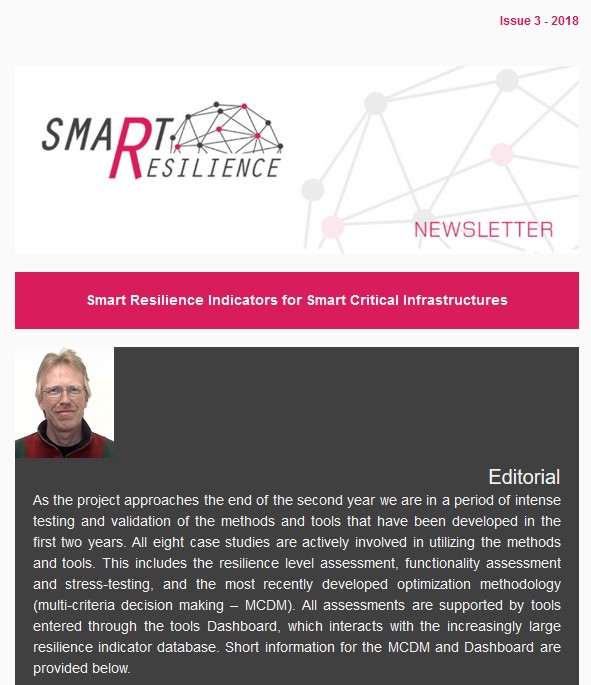 |
Approaching the end of its second year, SmartResilience has released its 3rd newsletter!
Approaching the end of its second year, SmartResilience has released its 3rd newsletter!
| This newsletter gives some hints about the project progress and results
as well as information about the use of big data in the project, and the
short information for MCDM & Dashboard. |
|
 |
|
|
|
|
|
|
19 Mar
2018 |
MoU with ANL on resilience of critical infrastructures |
 |
EU-VRi and Argonne National Laboratory (US) sign a MoU in the field of resilience of critical infrastructures !
Early 2018, the European Virtual Institute for Integrated Risk Management (EU-VRi) and Argonne National Laboratory (ANL) have signed a Memorandum of Understanding with the aim of strengthening their collaboration in the field of resilience of critical infrastructures.
Argonne National Laboratory is a science and engineering research national laboratory operated by the University of Chicago Argonne LLC for the United States Department of Energy.

This new collaboration aims to develop the mechanisms and processes to promote research, academic exchange and cooperation for the mutual goal of improving safety, security and sustainability aspects of resilience of critical infrastructures. This exchange of information will include resilience related indicators, assessment methods, tools, auditing for the improvement of protection of critical infrastructures. |
|
|
|
|
|
12 Feb
2018 |
Seveso Monitoring systems - SURVEY |
 |
A questionnaire focusing on the monitoring and reporting requirements as described in the Directive has been launched.

Seveso Monitoring systems - SURVEY
The European Commission, DG Environment, has awarded a study contract [1] to Amec Foster Wheeler (study lead), the Institut National de l’Environnement Industriel et des Risques (INERIS) and the European Virtual Institute for Integrated Risk Management (EU-VRi) to support the review of the current monitoring system established under Directive 2012/15/EU, the Seveso III Directive [2].
The Seveso-III-Directive concerns the control of major industrial accidents involving dangerous substances and provides a benchmark for industrial accidents policy in the EU and beyond. The Directive applies to establishments where dangerous substances are used or stored in large quantities. The aim of the Directive is to prevent accidents and, where they do occur, to effectively minimise their consequences.
The current monitoring system has now been in use for many years. While the overall current monitoring system is deemed appropriate, with the increased knowledge, experience gained and general political developments as well as more modern reporting standards it is appropriate to assess whether the monitoring system can be further improved. Considering that during 2018 and 2019 the updates of the relevant Commission Implementing Decisions are due; it is particularly important to ensure that the right data is being collected with an adequate level of administrative burden before preparing the new Decisions. Furthermore, the responses to the questionnaire will be used to identify whether an adaptation of the data collected might be necessary to allow the establishment of policy indicators to better monitor and communicate on the achievements of the Directive. Overall, the aim of this questionnaire is to gather feedback and insights from a range of stakeholders on the usefulness of the current monitoring system and, if appropriate, possible ways to improve it. The questionnaire focuses on the monitoring and reporting requirements as described in the Directive.
Prevention and control of accidents is achieved through specific requirements placed upon operators storing or handling certain dangerous substances above a threshold quantity. There are requirements for both operators and Member State competent authorities.
Please complete all of the sections / questions that you are able to. Where you are not able to answer any of the questions – either through lack of data or because it is not relevant to you/ your organisation – there is no need to provide a response. If you would prefer to discuss the questionnaire over the phone rather than draft a written response do not hesitate to contact the contractors. We would also welcome any additional supporting documentation you are able to provide.
https://www.surveymonkey.co.uk/r/SevesoMonitoring-EU_Internationalorg
Please fill in this survey by March 28, 2018. It takes approximately 30 minutes to complete.
[1] Terms of reference available at: https://circabc.europa.eu/sd/a/9dc34635-7f3a-4366-b4cf-4dbc2e6bb971/170821%20Sev%20monitoring%20-%20TOR%20Ares(2017)4104173.pdf
[2] http://eur-lex.europa.eu/legal-content/EN/TXT/PDF/?uri=CELEX:32012L0018&from=EN
|
|
|
|
|
|
21 Nov
2017 |
Fourth SAF€RA joint call on the themes "New technologies and the effects of major changes in industry" and "Measuring and monitoring safety performance" |
 |
SAF€RA has launched its fourth joint call for transnational, collaborative research projects. The call aims to foster collaboration between researchers from different countries in Europe and from different scientific disciplines, in order to improve safety and the management of technological risks

SAF€RA has launched its fourth joint call for transnational, collaborative research projects. The call aims to foster collaboration between researchers from different countries in Europe and from different scientific disciplines, in order to improve safety and the management of technological risks.
The call topics are:
- T1: New technologies and the effects of major changes in industry
- T2: Measuring and monitoring safety performance
Funding available
The total available budget for the 2018 call is approx. 1.6 M€. Two forms of funding are available:
- research grants for researchers from universities, institutes, research organizations and public firms;
- person-months for personnel from certain participating institutes and research organizations.
Most projects funded within this call will include 2 to 4 partners, for a duration between 12 and 36 months and funding between 20 and 150 k€ per project partner. The call aims to fund mainly applied research carried out in universities or research institutes, though contributions from industry are also eligible. Interdisciplinary research is encouraged. Cooperation and joint activities between different consortia funded within the call will be encouraged.
Call timeline
The 2018 joint call will use a two-stage application process with a pre-proposal mechanisms for the first stage. The calendar of the various stages is shown below.
| Publication of the call |
November 20 2017 |
| Deadline for submissions of pre-proposals |
January 25 2018 |
| Information sent to applicants on results of the first stage. Requests for full proposals are sent to selected applicants, and collaborations proposed to single-nation applicants. |
January 31 2018 |
| Deadline for submission of full proposals |
March 22 2018 |
| National funding decisions transmitted to applicants |
September to October 2018 |
| Projects start |
October to December 2018 |
Call documentation
The following documents are available:
- The Guidelines for proposers contains a description of the topics covered by the 2018 joint call, information on the participating funding organizations and the budgets available, and other important information for researchers wishing to submit a proposal.
- The Guidelines for evaluators are written for the experts who will evaluate the projects, but will be useful to researchers who wish to understand the evaluation criteria.
- The pre-proposal form is available in Microsoft Word (.doc) or OpenOffice/LibreOffice (.odt) formats.
- Templates for the SAF€RA progress reports, which must be sent to the SAF€RA Call Secretariat by the project coordinator on behalf of the project consortium. The mid-term reporting template should be submitted halfway through your project, assuming the project has a duration greater than 18 months. A final administrative report should be sent by all projects, within three months of the end of the project. (This report is distinct from the final scientific report which most projects will be producing as one of their deliverables.)
A web-based matchmaking facility is available to help researchers wishing to submit projects as a consortium to find partners.
Contact information
For general queries concerning the 2018 joint call, please email the call secretariat at call-secretariat@safera.eu. Make sure you read the call documents above and check the list of frequently asked questions first.
If you have questions concerning the eligibility criteria of specific funding organizations, please check the contact information provided in the Guidelines for proposers document, which can be downloaded above.
For more information, please visit the call website at www.call.safera.eu. |
|
|
|
|
|
18 Oct
2017 |
EU-VRi Annual Report 2016 |
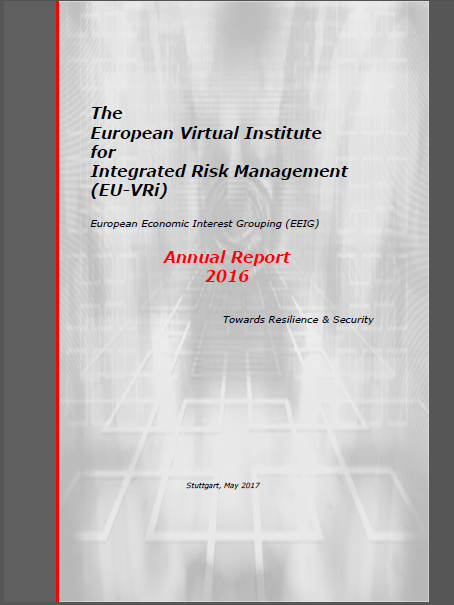 |
The EU-VRi Annual Report 2016 is now available. For download please click here.
After the challenging year 2015 and a lot of effort invested into new topics (security & resilience) and collaboration with industry, the year 2016 was marked by the actual start of the corresponding projects. The new wave of projects resulted in the consolidation of the overall situation and has allowed to more than compensate the losses of 2015.
In addition, the consolidation helped to strengthen the leading role of EU-VRi in the European and internationals risk-related activities, initiatives and projects. Keynotes, contributions, papers and presentations at meetings and conferences have clearly confirmed this. As “broker and coordinator” EU-VRi has continued its activity as Operating Agent of the European Technology Platform Industrial Safety (ETPIS), Operating Agent of the SRA-Europe (Society for Risk Analysis Europe) and the Operating Agent of the European Safety and Reliability Association.
As the “project leader and coordinator”, EU-VRi has contributed to safety-security EU integration through the EU projects like SmartResilience (“Smart Resilience Indicators for Smart Critical Infrastructures”) and ResiStand (“Increasing disaster Resilience by establishing a sustainable process to support Standardisation of technologies and services”), as well as through the industrial projects like PSMS (“Implementation of the Process Safety Management System into NIS j.s.c. Novi Sad”).
In the 10th full year of operation of EU-VRi, one should recall the overall balance expressed in terms of the “key performance indicators" of EU-VRi:
· Full 10 years of sustainable operation (as an SME, losses in one year only)
· Over 50 members (under 5% of annual fluctuation in membership, 2-3 members leaving/joining annually)
· Over 80 projects successfully finished or under way
· Over 50% of success rate in projects (the EU-average well below 20%)
· Over 20 Mio € in projects for EU-VRi members
· Over 4.5 Mio € in EU-VRi turnover.
Finally, in 2016, the construction of the “bridge” between safety and security, announced already in 2014 has been successfully realized in large European projects. This will be pursued also in 2017 and this certainly opens of new horizons for further scientific and business activities for EU-VRi and all its members. |
|
|
|
|
|
15 Sep
2017 |
Resilience-Related projects met in EC premises in Brussels in order to align further activities |
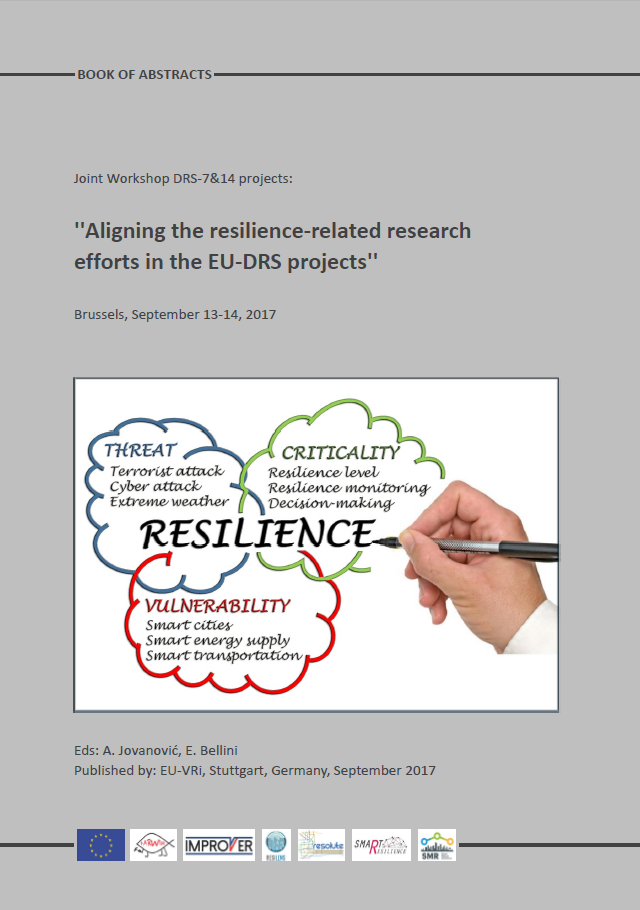 |
Workshop entitled: ''Aligning the resilience-related research efforts in the EU DRS Projects'' took place in BAO Centre in Brussels on September 13-14.
Resilience Workshop organized by DRS-7&14 Projects (Darwin, Improver, Resilens, Resolute, SmartResilience, SMR) in conjunction with CoU meeting had been finished. More than 140 participants gathered during 2-day Resilience Workshop discussed the following items:
Session 1: Towards the aligned European Resilience Management Guidelines: How to achieve alignment and interoperability?
Session 2: Resilience assessment method and indicators: How to define them? How to monitor them? How to implement them?
Session 3: Tools & methods for resilience operationalization
Session 4: Application cases – are the newly developed methods, guidelines & tools implemented/analyzed?
Session 5: Importance of international/global cooperation in the area of resilience – How to enhance it in the future?
Session 6: Alignment of the Resilience Workshop findings/items with IMG-S - EARTO WG Security Research approach
Furthermore, in the Interactive Space audience had an opportunity to become familiar with projects' outcomes and dissemination materials. Also, thanks to presence of Nexus Perspectivity Challenge Game, experts had a chance to be put in the shoes of key decision makers.
The most important findings of the workshop agreed among projects coordinators have been summarized and can be found here.
In order to download the book of abstracts please click on the picture below.

Below are uploaded presentation slides as .pdf files for sessions held during the Resilience Workshop. The content, style or layout of the slides should not be changed without the permission of the authors.
Session 1: Towards the aligned European Resilience Management Guidelines: How to achieve alignment and interoperability?
1) J.M. Sarriegi: European Resilience Management Guideline (SMR)
2) S. Jacobzone: Achieving Resilience: sharing best practice, value and limit of guidelines (OECD) - not yet available
3) D. Lange: Integration of risk and resilience management (IMPROVER) - not yet available
4) W. Hynes: European Resilience Management Guidelines (ERMG) for the operators and owners of Critical Infrastructure (CI) (RESILENS)
5) M. Branlat: Practical interventions to support critical infrastructures in enhancing their resilience (DARWIN) - not yet available
6) E. Gaitanidou: European Resilience Managment Guidelines and their adaptation for UTS (RESOLUTE) - not yet available
Session 2: Resilience assessment method and indicators: How to define them? How to monitor them? How to implement them?
1) R. Almeida: Assessing resilience based on the ISO/IEC 33000 standard series (IMPROVER)
2) A. Jovanovic & L. Bodsberg: Which indicators can tell us if critical infrastructure is resilient? How do we know the ‘’quality of indicators?’’ (SmartResilience)
3) J.M. Sarieggi: Indicators for assessing the resilience-building process in cities (SMR)
4) D. Verner, F. Petit: Assessing Resilience: from Facilities to Regions (ANL)
5) E. Bellini: Exploiting SmartResilience indicators in RESOLUTE Resilience Assessment Framework (RESOLUTE)
Session 3: Tools & methods for resilience operationalization
1) G. Rafaeli: The RESILENS Toolkit – Decision Support for CI operators and owners (RESILENS)
2) R. Almeida: A web tool for assessing resilience using any framework (IMPROVER) - tool presented online: http://improver-inov.herokuapp.com/users/sign_in
3) P. Nesi, A.Drosou: Evidence-driven Collaborative Resilience Assessment and Management Support System for Urban Transport System, A VA Platform for Personalized Crowd, Fleet & Resources Management (RESOLUTE)
4) U. Barzelay: Why and how to use Interactive data visualization in resilience related projects? (SmartResilience)
5) C. Grimes: Overview of the resilience tools developed and their intersections (SMR) - not yet available
6) I. Kozine: Capabilities-based approach to building and maintaining resilience
Session 4: Application cases – are the newly developed methods, guidelines & tools implemented/analyzed?
1) A. Corrigan: The RESILENS Pilot Demonstrations – Testing the Toolkit across three CI Sectors in Ireland, Portugal and Germany (RESILENS)
2) E. Bellini: Florence pilot case (City of Florence) (RESOLUTE)
3) Z. Szekely, I. Macsári: Case study DELTA and the significance of the SmartResilience project for the aviation security sector (SmartResilience) - will be published later
4) V. Latinos: Local Resilience Planning: A review of methodologies adopted for the SMR pilot implementation process (SMR)
5) P. Berggren: DARWIN - Pilot application in Sweden involving among others health care, public sector and transport services (DARWIN)
Session 5: Importance of international/global cooperation in the area of resilience – How to enhance it in the future?
1) W. McNamara: US DHS views on critical infrastructure resilience - not yet available
2) S. Jacobzone: Application of resilience concepts: the case of critical infrastructure - not yet available
3) I. Linkov: Resilience: State of Science and State of Applications in the USA
4) F. Petit, D. Verner: Resilience Indicators and Interdependencies: Need to Promote a Global Approach
5) C. Grimes: The role of local and regional networks and partnerships in resilience-building (SMR) - not yet available
6) J. Kieran: Enhancing International Collaboration through DARWIN’s Community of Practitioners (DARWIN) & movie (click here)
Session 6: Alignment of the Resilience Workshop findings/items with IMG-S - EARTO WG Security Research approach
1) C. Fuggini: Joint Position Paper on Resilience in Security Research
|
|
|
|
|
|
13 Sep
2017 |
Resilience Workshop - Brussels |
 |
Resilience Workshop will take place in Brussels on September 13-14, 2017.

|
|
Joint Workshop DRS-7&14 in conjuction with the CoU - Community of Users (http://ereg.me/cou-sept-2017) meeting of Sept. 12, 2017:
Aligning the resilience- related research
efforts in the EU-DRS projects
September 13-14, 2017
BAO Congress Centre
rue Félix Hap 11
1040 Brussels, Belgium
Following the initiatives coming from several DRS-projects and support expressed by the European Commission, this joint workshop is organized with the goal to ensure collaboration and alignment among the projects, especially in the areas related to methods, guidelines and tools developed in the projects. The challenges related to aligning experience, findings and lead to research in single project towards a ''common approach'' will be tackled during this workshop and the possibilities for joint practical actions examined.
The format of the joint workshop will include plenary sessions devoted to alignment of:
- Methods & Guidelines for resilience assessment
- Resilience Indicators
- Tools, operationalization, application
- International/global collaboration in the area of resilience involving international organizations (OECD, EU), ISO and partners from USA and China (ytbc)
as well as the
- Infobooths of single projects
- Posters & demonstrations
- Serious gaming (related to resilience, ytbc)
The registration web-page will contain book of abstracts and presentations (after the workshop)
Program in a nutshell:
| Start: September 13, 2017 11:30 |
| Session 1: |
Towards the aligned European Resilience Management Guidelines: How to achieve alignment and interoperability? |
| Session 2: |
Resilience assessment and indicators: How to define them? How to monitor them? How to implement them? |
| Session 3: |
Tools and methods for resilience operationalization |
| Session 4: |
Application cases: Where the newly developed methods, guidelines & tools have been implemented / analyzed? |
| Session 5: |
Importance of international/global cooperation in the area of resilience |
| |
Final discussion |
| End: September 14, 2017 14:00 |
SHORT COURSE:
Indicator-based resilience assessment for critical infrastructures - the Smart Resilience methodology and tools
A. Jovanovic & K. Øien
September 14, 2017 14:00 - 16:30
Max no. of participants: 25 (first registered - first served)
|
Program Committee: E.Bellini* (RESOLUTE), I. Herrera (DARWIN), W. Hynes (RESILENS), A. Jovanovic* (SmartResilience), S. Jacobzone (OECD), D. Lange (IMPROVER), I. Linkov (OECD), P. Nesi (RESOLUTE), J. M. Sarriegi Domínguez (SMR); * - organizers
Interested in submitting a contribution?
Contact ktetlak@risk-technologies.com
|
|

REGISTER HERE:

http://www.smartresilience2.eu-vri.eu/Events/default.aspx?EventID=11100

http://www.smartresilience2.eu-vri.eu/Events/default.aspx?EventID=11101
NOTE: Registration remains open by until the workshop date or until reaching the capacity limits of the venue (max. no. of participant for the workshop 120, for the course 25)
Contact: K.Tetlak at:
WorkshopResilience2017@eu-vri.eu

www.h2020darwin.eu

www.improverproject.eu

www.resilens.eu

www.resolute-eu.org/

http://www.smartresilience.eu-vri.eu

www.smr-project.eu
The projects above have received support from the EU DRS project line - the support is gladly acknowledged
|
|
Partners from the EU-DRS projects are specifically invited and encouraged to participate,
all other interested Community of Users (CoU) members and external parties are cordially invited.
Please, register online (room limitations: 120 participants).
Contact organizers: Ms. K. Tetlak at WorkshopResilience2017@eu-vri.eu
Participation in the workshop and the course is free of charge, but registration is mandatory!
|
|
|
|
|
|
|
18 May
2017 |
The 5th SAF€RA Symposium |
 |
The 5th SAF€RA Symposium in Bilbao, on May 18-19, 2017.
 
The 5th SAF€RA Symposium will take place in Bilbao, Spain, on May 18-19, 2017. It is to present and discuss results from the first two SAF€RA joint calls, give an insight to research needs in industrial safety, and provide details of the 3rd SAF€RA joint call.
The draft programme is available here and the key information can be found hereunder:
Registration in the SAF€RA Final Conference has to be made before April 21, 2017:
http://safera-symposium.evenium.net
The registration is free of charge. Only the dinner on May 18 and the lunch on May 19 will be at your own cost.
Presentations dedicated to scientific topics and with wish to open new collaborations are encouraged.
If you intend to make a presentation, please submit your abstract at the following link https://goo.gl/forms/nTbpYTxMdo4ACGGm1
Deadline to submit an abstract: April 7, 2017.
HOTEL MIRÓ * * * * - 160 m from IBERDROLA Tower
http://www.mirohotelbilbao.com/
HOTEL NH VILLA DE BILBAO * * * * - 700 m to the IBERDROLA Tower
https://www.nh-collection.com/es/hotel/nh-collection-villa-de-bilbao
HOTEL NH DEUSTO * * * - 650 m from IBERDROLA Tower (8 min)
https://www.nh-hoteles.es/hotel/nh-bilbao-deusto
HOTEL Ercilla **** , 15 min walking to the Iberdrola Tower
http://www.hotelercilla.com/
Ms. Maria Nieves de la Peña
Osalan - Instituto Vasco de Seguridad e Higiene Laborales
Camino de la Dinamita, s/n
48903 Barakaldo (Spain)
T: +34944032145 / E: osalantpr16ba@euskadi.eus
Olivier Salvi, EU-VRi, Germany, Symposium Chair
Maria Nieves de la Peña, OSALAN, Spain, Symposium Co-Chair
Carita Aschan, FIOH, Finland
Eric Marsden, FonCSI; France
Kai Holtappels, BAM, Germany
SAF€RA originated as an ERA-NET project entitled 'Coordination of European Research on Industrial Safety towards Smart and Sustainable Growth' that was funded for three years by the European Commission in the 7th Framework Programme (Grant agreement no: 291812). Under the ERA-NET scheme it identified areas of joint interest and expected synergies of collaborative research, and stimulated transnational research on industrial safety.
SAF€RA brings dynamism into European research on industrial safety where it cannot be tackled at the national level. SAF€RA will continue in context of the European Technology Platform on Industrial Safety, ETPIS, which initiated the original SAF€RA project.
Former Chairman: Jürgen Lexow, juergen.lexow@bam.de
Vice-Chairman: Olivier Salvi, salvi@eu-vri.eu
SAF€RA homepage: http://www.safera.industrialsafety-tp.org/
Call Homepage: http://call.safera.eu/
ERA-NET scheme: http://cordis.europa.eu/fp7/coordination/about-era_en.html
European Technology Platform on Industrial Safety (ETPIS): http://www.industrialsafety-tp.org/
|
|
|
|
|
|
07 Feb
2017 |
NMSA Conference in Malaga - Call for abstracts |
 |
Jointly organized by five major FP7 projects NANOSOLUTIONS, GUIDEnano, SUN, NanoMILE and eNanoMapper, the NMSA conference will take place in Malaga on February 7-9, 2017.
New tools and approaches for nanomaterial safety assessment (NMSA conference)
Jointly organized by five major FP7 projects NANOSOLUTIONS, GUIDEnano, SUN, NanoMILE and eNanoMapper, the NMSA conference will take place in Malaga on February 7-9, 2017. The conference aims at presenting the main results achieved in the course of the projects fostering a discussion about their impact in the nanosafety field and possibilities for future research programmes.
Target audience
The conference welcomes consortium partners from the organizing projects, as well as representatives from other EU projects, industry and government, civil society and media.
Conference highlights
- 10 Scientific Sessions
- 5 Keynote presentations
- Stakeholders workshop
- Over 300 attendees
Conference topics
- Hazard assessment along the life cycle of nano-enabled products
- Exposure assessment along the life cycle of nano-enabled products
- Risk assessment & management
- Systems biology approaches in nanosafety
- Categorization & grouping of nanomaterials
- Nanosafety infrastructure
- Safe by design
Stakeholders workshop
The conference will be wrapped up with a stakeholder workshop which will provide a platform for an open discussion with interested stakeholders that could ultimately guide the research needs that should be addressed in future projects.
Call for abstracts
The Call for Abstract is open until the September 30, 2016.
Conference website: www.nmsaconference.eu
    
With the support of

|
|
|
|
|
|
01 Feb
2017 |
ELSEVIER - Special Issue: societal safety, critical infrastructure reliability and related intersectoral governance |
 |
Submissions of full papers are due via Safety Science’s submission portal on February 1, 2017.

Special Issue: societal safety, critical infrastructure reliability and related intersectoral governance
Societal safety refers to the consolidation of society’s robust “normal” functioning and includes the prevention and absence of major disruptions within and across key sectors. When failures occur, societal safety incorporates the ability to respond to and cope with external or internal stresses, such as natural hazards, terrorism and major industrial accidents. Critical infrastructures are the lifelines of modern societies and their reliability is essential for societal safety. Sectors, organizations and populations are organized around the expectation that infrastructures function, typically with near 100 per cent reliability. Their success—their usefulness and high reliability —produces societal vulnerability and challenges in terms of governance, as dependence on them is engrained in the fabric of society. Joint and coordinated efforts from different disciplines are required to maintain societal safety in general and critical infrastructure reliability in particular as both the vulnerabilities and the resources for resilience straddle organizational, sectoral, jurisdictional and national boundaries.
This Special Issue invites studies that advance our understanding of societal safety and our capability for preventive and responsive action. We seek to elaborate societal safety around two particular foci: as societal issues (matters concerning policy and regulation) and as operational issues (the operation and emergency management in infrastructure sectors along with their other key functions) and, importantly, how the two foci are intertwined. At least two important trends challenge both:
1) Neoliberal forms of governance have led to more fragmented organizations while sectors of society have become more tightly coupled.
2) Digitalization has introduced new, often intractable, interdependencies and couplings, increasing complexity and the potential for domino- or cascade effects. It opens up new vulnerabilities related to intentional and accidental events but also new means for risk monitoring and coordination in emergencies.
While the dependency on highly reliable critical infrastructures and digital technologies may invite models of societal safety based on strict rules and regulation, the last decades of safety and reliability theory has increasingly been concerned with how system variability is handled in dynamic ways and how situational adaptations and adjustments can be resources for resilience. Our Special Issue specifically encourages reflection on the boundaries of this adaptability, the managing of adaptability, and its regulation.
The special issue invites papers discussing societal safety as operational and societal issues. We are particularly, but not exclusively, interested in papers discussing the inter-organizational/inter-sectoral management of societal safety, case studies of critical infrastructures and organizations/agencies responsible for societal safety, resilience based perspectives on societal safety, perspectives on the management on the societal interconnectedness of risk and on the relationship between safety and security. We are also interested in theoretical and empirical contributions addressing the implications of digitalization and neoliberal governance (New Public Management, managerialism, public-private partnerships etc) for these topics.
Submission Method
The length of submitted papers will be between 7,000 and 10,000 words. Submitted papers must be unpublished and not currently under review by other journals. Papers using previously published conference papers should not exceed 20% similarity.
All Full length papers should be submitted via the Safety Science submission system. While submitting a paper to the special issue, please choose the article type “Societal Safety” otherwise your submission will be handled as a regular manuscript. All submissions will go through the journal’s standard peer review process. Criteria for acceptance include originality, contribution, scientific merit and relevance to the theme of the Special Issue. For author guidelines, please visit the website of the journal at http://www.journals.elsevier.com/safety-science
Deadlines:
Submissions of full papers are due via Safety Science’s submission portal on February 1, 2017. Papers must be in accordance with the ordinary format requirements of Safety Science.
We also invite interested authors to submit abstracts or extended abstracts (by email, max 1000 words) to the editors by October 15, 2016. This is not mandatory for full paper submission.
Managing guest editor:
Dr. Emery Roe, Center for Catastrophic Risk Management, University of California, Berkeley, US, emery.roe@berkeley.edu
Guest editors:
Dr. Petter G. Almklov, NTNU Social Research, Norwegian University of Science and Technology (NTNU), Norway, pettera@svt.ntnu.no
Kristine V. Størkersen, NTNU Social Research, Norwegian University of Science and Technology (NTNU), Norway, kristine.vedal.storkersen@apertura.ntnu.no
Dr. Stian Antonsen, Department of Safety Research, SINTEF Technology and Society, Norway, Stian.Antonsen@sintef.no |
|
|
|
|
|
24 Nov
2016 |
The European Project EDEN: when numbers count |
 |
The European Project EDEN has recently published a press release "When numbers count".
 |
|
The European Project EDEN:
when numbers count
|
Fifteen demonstrations, 109 tools evaluated, more than 200 End-Users involved and 90 gaps addressed: these are the headline numbers presented by the Coordinator of the European Project EDEN, Clive Goodchild (BAE Systems), during the final conference held in Brussels on 11 and 12 October 2016.
These figures represent extensive work by 36 partners from 15 European countries who for more than three years developed innovative tools and procedures for preventing and responding to CBRNE (Chemical, Biological, Radiological, Nuclear and Explosive) threats and incidents with a focus on integration of capabilities, technologies and systems.
As part of the consortium development activities over 50 existing tools were developed and matured, including new methods for determining system resilience, hazard and population response modelling, remote sampling and detection, multi-level situational awareness systems and a European first (Nuclear Reactor core integrity sensing) and 10 new innovations were invented and developed during the Project, with 2 of them being taken to full commercial availability. A new concept for allowing existing systems to be integrated with new innovations was demonstrated and implemented in all demonstrations.
The fifteen demonstrations were grouped into three scenario themes: firstly, emergencies arising from biological and chemical contamination in the food supply chain, secondly responses to chemical attacks and thirdly radiological and nuclear security. The demonstrations ranged from Large Scale Actions, with the active involvement in the field of hundreds of First Responders to Table Top Exercises carried out in simulated environments. The added value of the EDEN project was the deployment during the demonstrations of 109 tools and their evaluation by End-Users who assessed whether the tools were effective in addressing the gaps identified at the beginning of the project during a series of workshops and provided feedback on improvements that could be made to meet there operational needs. Great importance was set upon the constructive involvement of SMEs during the demonstrations who nowadays play an energetic and constructive role in R&D for the security sector and whose contribution to EDEN was coordinated by the SME Platform working closely with the Supplier Platform.
Two key elements of the EDEN Final Conference was the presentation of the final version of the EDEN STORE and the CBRNE FAIR 2016 held simultaneously with the Conference.
EDEN STORE is web accessible application providing stakeholders in the CBRNE sector a set of functions which include a catalogue of more than 270 tools with different capabilities and functionalities, a simulation and real time crisis management environment, a secure forum to allow practitioners to share information and expertise and a central repository to share training kits/modules and operating procedures. This achievement puts Europe ahead in the field of research and development in the CBRNE sectors of prevention and response. It is accessible through the link https://eden.astrium-eu-projects.eu after authentication.
The CBRNE FAIR 2016 was a two day exhibition held in Brussels where the Project EDEN partners and members of the SME and Supplier Platforms exhibited solutions developed during the project. Stakeholders and End Users had the opportunity to learn about the project and its results. The Fair was an important opportunity for the cross-fertilisation of research ideas including product development and an opportunity to boost collaboration between organisations thereby enhancing European liaison to tackle the CBRNE threats.
The legacy of Project EDEN is conspicuous and valuable providing a tangible impact for improving the security of European citizens and infrastructure.
Updates and reports on the EDEN project are available at the web address https://eden-security-fp7.eu/. |
|
|
|
|
|
16 Nov
2016 |
European SME week “Helping Europe’s entrepreneurs reach new heights” - How do SMEs benefit from standards? |
 |
CEN and CENELEC together with SBS (Small Business Standards) would like to showcase how standards can help SMEs to reach new heights.

European SME week
“Helping Europe’s entrepreneurs reach new heights”
-
How do SMEs benefit from standards?
Within a fortnight we will be celebrating the European SME week! A great opportunity to promote how standards help SMEs to do better business. This year’s theme is “Helping Europe’s entrepreneurs reach new heights”. CEN and CENELEC together with SBS (Small Business Standards) would like to showcase how standards can help SMEs to reach new heights.
Are you an SME, take this opportunity to promote your business! Send a quote (max. 100 words) and share why you use standards and/or why you are involved in standardization. Maybe you contributed to the development of a particular standard? Tell all about it! Your activities will be promoted through social media and on website to kick-start the SME week on 21 November.
Need inspiration for a quote? Maybe these tips will help:
1: There are many benefits that SMEs can gain from using standards. Knowing which standards to use, and how to apply them in the correct way, is vital for the success of your business.
Why do you use standards? (e.g. to ensure quality/safety of products/services, compatibility between product/components, market access, meet legislation, ...)
Which standards are relevant to your company?
2: It is also important to understand how standards are made, and how SMEs can contribute to the standardization process.
Why did you get involved in European standardization?
What did you get out of this involvement? ? (e.g. networking, advance knowledge of new technologies and innovation, ...)
3: SMEs face specific challenges (problems, obstacles…) to participate in standardization (e.g. they often don’t have the time or resources to get as involved as they would wish)
What challenges if any did you meet?
How do you think the standards organizations (or anyone else) can help?
4: And, don’t forget to present yourself and your company (name, company name and main activity, number of employees). If you could add a picture, that would be nice too
CEN, CENELEC and SBS are looking forward to receiving your quotes by November 16 at SME-NEWS@LISTSERV.CENCENELEC.EU.
Unless explicitly mentioned, CEN/CENELEC and SBS understand that they have agreement to publish and share the quotes/pictures received.
|
|
|
|
|
|
11 Oct
2016 |
CBRNE innovation fair 2016 & EDEN final conference |
 |
The CBRNE INNOVATION FAIR 2016 and the EDEN final conference will take place 11-12 October 2016 in Brussels.

The CBRNE INNOVATION FAIR 2016 will take place 11-12 October 2016 in Brussels and will bring together decision-makers, from government, operational units, industry, science and research in CBRNE and crisis management.
The industry’s top performing companies and organisations will present their products and innovations. Among the products presented a special focus will be on EDEN Store, tools developed by the EDEN project and constructive dialogue and collaboration on topics relevant to disaster risk management and crisis management.
The EDEN Consortium invites decision makers, operators and donors of CBRNE technologies to join its Final Conference on 11 October 2016 organised jointly with the CBRNE INNOVATION FAIR 2016 in Brussels.
During the event, EDEN partners will present their results and achievements obtained in the last years of work in terms of technology, procedures and methods for the management of CBRN accidents. The EDEN Store will be presented and the movies from the validation exercises displayed.
EDEN Final Conference | Tuesday 11 October 2016, 11:00–16:30
- Project Results
- EDEN Store
- EDEN Demonstrations Results (food, chemical, radiological)
- EDEN Trainings
- End-users Assessment of EDEN Solutions
- The Future
|

www.eden-security-fp7.eu
|
Registration at www.cbrne-fair2016.eu
Attendance is free of charge, but registration is required (number of visitors is limited).
EU-VRi (Operating Agent of ETPIS) is coordinating the project’s Supplier Platform that is reaching out for innovative solutions throughout the CBRNe security cycle. In addition, the institute is in charge of standardization aspects, acting as organization in liaison with CEN TC 391 on Societal and Citizen Security on behalf of the consortium |
|
|
|
|
|
29 Jun
2016 |
Resilience and Technological Risk: comparative experiences 40 years after the disaster in Seveso |
 |
The conference Resilience and Technological Risk: comparative experiences 40 years after the disaster in Seveso will take place June 29th, 2016 at Committee of the Regions in Bruxelles.
 
In the occasion of the "40 years anniversary of the disaster of Seveso*", The European Commission would like to invite you to the conference Resilience and Technological Risk: comparative experiences after the 40 years of disaster of Seveso to analyse in-depth the effectiveness of the adoption of the European Directives and by local governments and debate how “resilience actions” have been lasting uninterrupted for forty years.
Experts of the European Commission and EU regional authorities will discuss how risk management and prevention have been improved thanks to the synergy between Institutional and socio-economics regional and local structures as well as the new perspectives: ranging from environmental restoration, scientific research and safety regulations.
Confirmation to the participation is required by June 20th, 2016 to silvia.dognini@flanet.org (specifing surname, first name, date of birth, type and number of document, organization).
*The accident of Seveso (July 1976) marked the start of a series of “resilience actions” which has been lasting uninterrupted for forty years thanks to an active participation of the civil society.
Informations:
40° Anniversary after Seveso:
Resilience and Technological Risk: comparative experiences 40 years after the disaster in Seveso
29/06 at Committee of the Regions
Bâtiment Jacques Delors, Rue Belliard 99-101 - Bruxelles
Room JDE53 (5th floor of the JDE building) |
|
|
|
|
|
18 Mar
2016 |
OPEN CALL FOR TECHNICAL EXPERTS : CBRN substances in Healthcare facilities |
 |
CEN (European Committee for Standardization) is currently looking for experts to carry out the work under the Specific Grant Agreement SA/CEN/GROW/EFTA/000/2015-09 "Guidance for the security of CBRNE substances for healthcare facilities along their lifecycle".
OPEN CALL FOR TECHNICAL EXPERTS:
CBRN substances in Healthcare facilities
CEN
(European Committee for Standardization) is currently looking for experts to
carry out the work under the Specific Grant Agreement
SA/CEN/GROW/EFTA/000/2015-09 "Guidance for the security of CBRNE
substances for healthcare facilities along their lifecycle".
- Project
title: Guidance for the security of CBRNE substances for healthcare facilities
along their lifecycle
- Looking
for:
- Expert
for the handling of CBRNE substances in healthcare facilities
- Expert
in the legislation and administration of healthcare facilities
- Expert
in the legislation and control of nuclear safety
- New
Deadline for
applications: 18 March by midday (CET)
Further
details are available at CEN website and UNMZ website.
Interested experts are kindly requested to send the completed form in Annex 2
(Application Form) by 18th of March 2016 12:00 CET, to Mr. Stefan Krebs (krebs@unmz.cz ) by e-mail. Please duly fill in
the Application Form when applying for one of the eligible positions.
Applications
received after the deadline will not be taken into consideration.
The
selected experts are expected to start work late April and work together with
the CEN/TC 391’Societal and Citizen Security’ to prepare a technical
specification under the guidance of the CEN/TC 391 convenor.
|
|
|
|
|
|
18 Dec
2015 |
R-Tech to help mapping and calibrating nanorisks in the EU! |
 |
In the new Horizon 2000 project caLIBRATe of Steinbeis R-Tech will play a key role in the development of the next generation EU tools for risk governance of nanomaterials. The main objective of caLIBRAte is to funnel the state-of-the-art in Nano safety research and merge it with state-of-the-art risk governance and communication. It will provide versatile risk governance tools and the framework for assessment and management of human and environmental risks of micronano and micronano-enabled products.
R-Tech is going to take a leading role in the project by developing the Nano-Risk for the identification and monitoring of nanotechnology emerging risks. In addition, R-Tech will consolidate the caLIBRAte Nano-Risk Governance framework by developing the System of Systems (SoS) platforms. The framework models will be linked to the 10 steps of the ERMF framework developed within the iNTeg-Risk project and support the Cooper-style stage gate innovation model as a special interface for different stakeholders.

The web-based “system-of-systems” will link different models and methods for: 1) screening of apparent and perceived risks and trends in nanotechnology, 2) control banding, qualitative and fully integrated predictive quantitative risk assessment operational at different information levels, 3) safety-by-design and multi-criteria decision support methods, 4) risk surveillance, - management and -guidance documents. Control banding tools and quantitative models will be subject to sensitivity analysis and performance testing followed by a revision as needed. After revision the models will again be analyzed by sensitivity testing, calibration, performance tested to establish the uncertainties. After calibration, the models will be part of the framework, which will be demonstrated by case studies. Stakeholders will be involved for defining the user requirements of the framework and will receive training in the framework at the end. The caLIBRAte project answers to the call of NMP30-2015: Next generation tools for risk governance of Micronanotechnologies. The project is specifically designed to address the key challenges defined in the scope of the call text. There is particular focus on model revision, calibration and demonstration of existing models and methods that support the risk governance framework in regards to safe innovation and already implemented nanomaterials. Next generation computational exposure assessment and -toxicology is anticipated in the framework. |
|
|
|
|
|
28 Oct
2015 |
Lethabo Power Station "RBI- certified" |
 |
The Steinbeis Advanced Risk Technologies RBI system implemented in Eskom, Lethabo Power Station, in South Africa, was successfully certified by TÜV Rheinland South Africa.

|
"Thanks to the Lethabo Assessment team, especially Hari, for the dedication and commitment in assisting Lethabo throughout the RBI Certification process.
The risk assessment schedule was extremely tight to redo all the assessments, however with the commitment and dedication of the team we succeeded.
Thanks again for your support!
Anisha Ulassi
Lead Risk Engineer
Lethabo Power Station"
|
|
|
|
|
|
|
11 Oct
2015 |
ISO 9001 Recertification Audit |
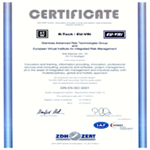 |
In connection that we obtained ISO 9001 certification, the re-certification audit on October 8-9, 2015, showed again that The Steinbeis Advanced Risk Technology Group duly improves the Quality Management System.
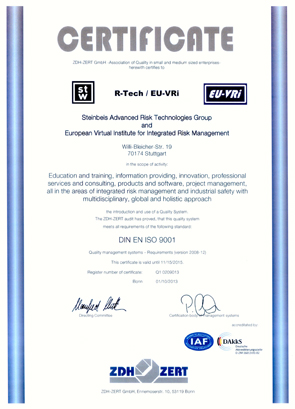 |
|
Steinbeis Advanced Risk Technology Group is one of over one million companies and organizations in over 170 countries where this standard was implemented.
Due to owning this certification, our company stepped to next level of activity with maintaining the highest quality of services which are provided.
|
|
|
|
|
|
|
25 Sep
2015 |
6th International Symposium on Industrial Engineering |
 |
Steinbeis Advanced Risk Technologies Group was co-organizer of the 6th International Symposium on Industrial Engineering which took place on September 24-25, 2015 in Belgrade, Serbia.
|
The regular event was hosted by the Mechanical Faculty of the University of Belgrade and co-organized by the Steinbeis Advanced Risk Technologies Group.
The presentation and discussions during and between the different sessions at the SIE 2015 contributed to a better understanding of the important role of Industrial Engineering for an economic and environmental sustainable future of Serbia and other countries. The symposium provided insights into the scientific work and achievements of international researchers as well as interesting trends with respect to the challenges practitioners of the future will have to face.
From the side of Steinbeis Risk Technologies Group, Michael Löscher was invited to give a welcome speech for the opening of the event as well as a keynote on “Safe and Sustainable Innovation in Germany – The Steinbeis Approach”.
|
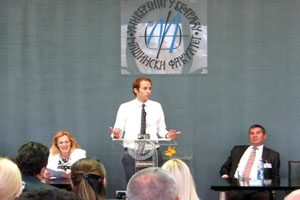 |
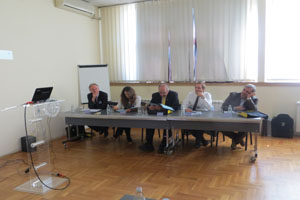 |
|
|
|
|
|
|
18 Sep
2015 |
5th China Europe Risk Forum |
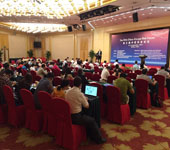 |
On Sept. 16-19, 2015, Beijing Academy of Sciences, European Virtual Institute for Integrated Risk Management (EU-VRi) and Steinbeis Advanced Risk Technologies Group have organized the 5th China Europe Risk Forum. The Forum was devoted to: "Emerging risks and resilience of critical systems and infrastructures".
|
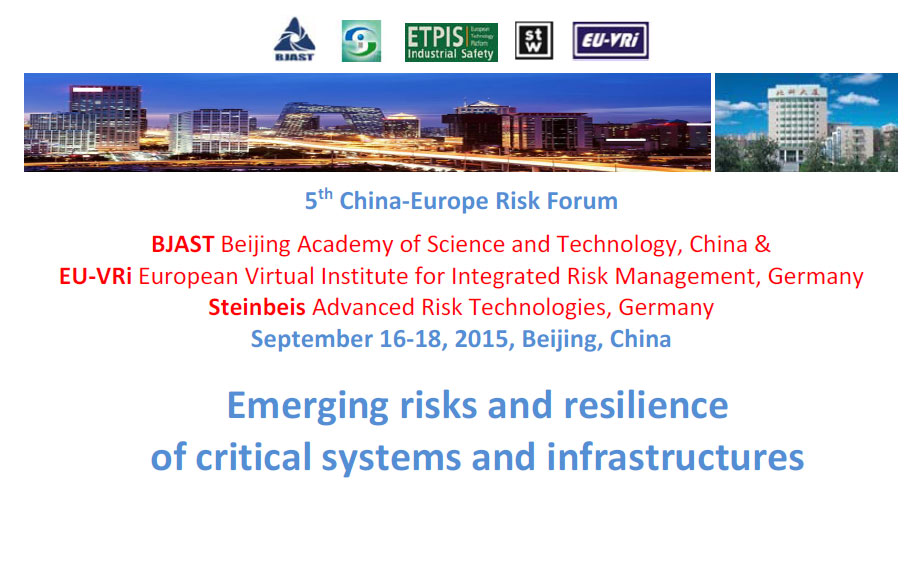
|
| The Forum brought together the specialists in risk fields from different areas and countries from all over the World. The topics were presented by experts, not only from Europe or China, but also by representatives from United States, Singapore and Japan. Thanks to this, it was a very good opportunity to exchange experiences and knowledge, how to deal with hazards which threaten the critical systems and infrastructures. |
|
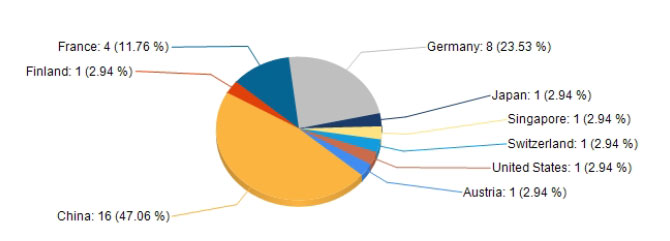
|
|

|
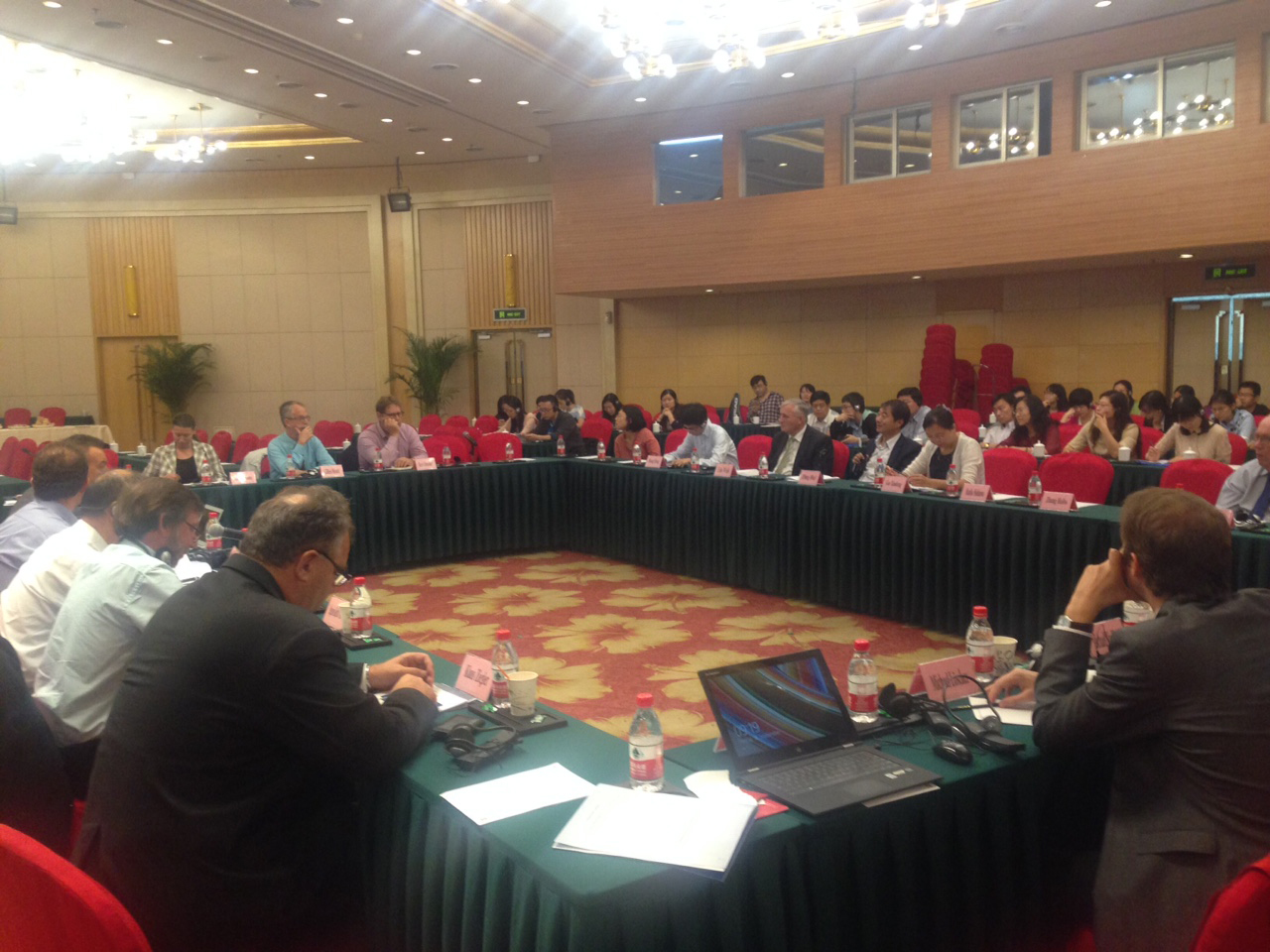
|
|
|
|
|
|
|
10 Sep
2015 |
HORIZON 2020 - Draft work programmes 2016-17 |
 |
The draft versions of the Horizon 2020 work programmes for 2016-2017 have been published.
HORIZON 2020 - Draft work programmes 2016-17
The draft versions of the Horizon 2020 work programmes for 2016-2017 have been published.
These documents are being made public just before the adoption process of the work programme to provide potential participants with the currently expected main lines of the work programme 2016-2017. They are not yet endorsed by the Commission and they do not in any way prejudge the final decision of the Commission.
https://ec.europa.eu/programmes/horizon2020/en/draft-work-programmes-2016-17 |
|
|
|
|
|
24 Jul
2015 |
Risks of Industry 4.0 |
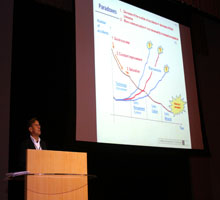 |
Prof. Jovanovic explains the Steinbeis vision and approach in his keynote at The World Congress of Risk in Singapore (July 19-23, 2015)

"The overall theme of the 2015 World Congress was Risk Analysis for Sustainable Innovation, highlighting sessions that identified ways that risk analysis can assist private and public policy makers facing complex and uncertain challenges while maintaining innovation and development. Special emphasis was placed on the role of risk analysis as a tool for policy making and tradeoffs in situation of limited resources and extreme challenges that are characteristic of developing countries."*
Among speakers, who represented topics from fields of health, environment, agriculture, engineering, economics, decision-making, psychology, social & political sciences, communication, law & policy, Prof. Jovanovic "(…) explaining his concept of "Industrial Revolution 4.0". He particularly highlighted the difficulties laypeople have in grasping fundamental understandings of where technology is heading today, stating that with the advent of automation, "humans could go the way of the horse", and that the practice of human skills may be lost”**.
The congress is finished, but all new ideas which have arisen during that time will be expanded in the future.
Photos
Read more about The World Congress on Risk 2015
* http://www.sra.org/worldcongress2015
** http://www.sra.org/news/sra-world-congress-risk-2015
|
|
|
|
|
|
02 Jul
2015 |
European NanoSafety Cluster Compendium |
 |
The 2015 edition of the nanosafety cluster compendium is now available
European NanoSafety Cluster Compendium
|
As FP7 ends and Horizon2020 begins in
earnest, the focus on nanosafety and responsible innovation continues,
with significant investment throughout FP7 and beyond. About fifty
nanosafety projects were funded under FP7, many of which are completed,
but about 15 will continue well into 2017 producing important data and
knowledge regarding the safe design of nanomaterials. The first H2020
projects are just about to start (September 2015) and three are also
presented in the 2015 Edition of the NSC Compendium. The focus is
shifting towards supporting industry, commercialisation and regulation,
and addressing the major gaps that still exist, primarily in terms of
prediction of impacts and read-across from existing materials to
emerging ones.
Please click on the link below to view the latest
version (June 2015) of the European NanoSafety Cluster Compendium, which
contains information on all running or recently completed projects
funded under the Seventh Framework Programme FP7, information on the 1st
H2020 nanosafety projects and updates from the NSC Working Groups whose
aim is to support collaboration and knowledge-sharing across the
nanosafety projects. Information on older projects can be found in the
previous editions.
|
|
 |
|
|
|
|
|
|
20 Apr
2015 |
EU-VRi & ETPIS events (GA, Brokerage event and Cross-ETP event) |
 |
This year annual meeting of ETPIS will be organized together with the General Assembly of EU-VRi and is accompanied by a Brokerage Event and a Cross-ETP Event.
EU-VRi & ETPIS events
This year annual meeting of ETPIS will be organized together with the General Assembly of EU-VRi and is accompanied by a Brokerage Event and a Cross-ETP Event.
All events EU-VRi and ETPIS are organizing on April 20-21, 2015 will take place at the European Commission premises Covent Garden in Brussels, Belgium.
- EU-VRi 11th General Assembly of All Members including ETPIS Members
April 20, 2015, 12:00 - 14:00
Agenda (for members only)
- Brokerage Event for H2020 calls in 2015
April 20, 2015, 14:30 - 18:00
Agenda (for members only)
- ETPIS Cross-ETP Event: Common challenges to safety, security and risk management
April 21, 2015, 09:00 - 16:00
Agenda
Condition of participation:
The participants have to be registered as EU-VRi member or ETPIS member.
If not yet done, send the registration form duly filled and signed to the ETPIS secretariat.
As soon as we have received your form, we will send you the official invitation. |
|
|
|
|
|
09 Mar
2015 |
SUN-SNO-GUIDENANO Sustainable Nanotechnology Conference 2015 |
 |
A forum for researchers, industry, and regulators on research findings on the interface between nanotechnology and sustainability.
SUN-SNO-GUIDENANO
Sustainable Nanotechnology Conference 2015
The SUN-SNO-GUIDENANO Sustainable Nanotechnology Conference 2015 is a forum for nanotechnology researchers, industry, and regulators to present and discuss research findings on the interface between nanotechnology and sustainability.
Our view of sustainability includes not only its environmental dimensions, but also the societal and economic ones. The conference program will address the critical aspects of sustainable nanotechnology such as life cycle thinking; environmental release and fate of engineered nanomaterials (ENMs) ; environmental, occupational and consumer exposure to ENMs; environmental and human health impacts of ENMs; safe production, handling and disposal of ENMs; regulatory and industrial decision support for sustainable nanotechnology; nanotechnology applications for sustainability; societal implications of nanotechnology; curriculum and training for sustainable nanotechnology.
The conference will be held from 9-11 March 2015 in Venice, Italy. It is being jointly organized by the Sustainable Nanotechnology Organization (SNO), a USA based non-profit organization dedicated to advancing sustainable nanotechnology, and two large EU FP7 nanosafety projects SUN and GUIDENANO. Perspectives on the implications and applications of nanotechnology will be provided by leading experts in EU and USA. We also hope to foster new multi-sector collaborations in nanotechnology.
Deadlines
Abstracts for Oral or Poster: December 10, 2014
Student Award: December 10, 2014
Conference Registration: January 12, 2015
Hotel Registration: January 9, 2015
Late Conference Registration: January 13, 2015
More information at: http://www.susnano.org/conferenceOverview2015SNO-SUN-GN.html |
|
|
|
|
|
16 Jan
2015 |
3rd Joint Transnational Call 2014 of the ERA-NET SIINN |
 |
The Third Joint Transnational Call 2014 of the ERA-NET SIINN has been opened on the 1st of October 2014.

|
3rd Joint Transnational Call 2014
of the ERA-NET SIINN
|
The Third Joint Transnational Call 2014 of the ERA-NET SIINN has been opened on the 1st of October 2014.
10 funding agencies from 8 countries including the United States of America participate in this joint call.
Funding will be offered to innovative projects focusing on:
- Exposure Assessment
- Toxicity Mechanisms
- Effects of manufactured nanomaterials on human health
- Environmental impacts of manufactured nanomaterials
The deadline for the online submission of electronic proposals is the January 16, 2015, 12.00 am CET (07.00 Washington D.C. time).
The electronic online submission system will be put into operation mid of October 2014 and will be available at: https://www.siinn-submission.eu/
Details about the call volume and the participating countries and regions are available on the SIINN Call 2014 website: http://www.siinn.eu/en/joint-calls/2014-third-siinn-call/,161
All call documents are published there.
It is strongly recommend that all applicants contact their regional/national funding agency for regional/national programme details. Details of the participating funding organizations and their national/regional regulations can be found in Appendix A and B of the Guidelines for Applicants: http://www.siinn.eu/bin/Annex_III_-_SIINN_3rd_Call_-_GfA_final_30.09.2014.pdf
Applicants are kindly invited to take this opportunity for realizing transnational projects in nanosafety and nanorisk research.
The FP7 NMPTeAm2 project offers a partner search tool for the SIINN Call 2014 at: http://www.nmpteam.com/
The ERA-NET SIINN is a European network of public funding organizations and funding programmes on nanosafety and nanorisk research, for the benefit of European industry and society. This EU funded project has been established to support and increase the coordination of national and regional funding and research to develop a strong European RTD community taking into account the global dimension of the addressed field.The ERA-NET SIINN network consists of 14 European countries and 19 funding organizations, of which 16 are national and 3 are regional. Between August 2011 and July 2015, the ERA-NET SIINN consortium aims to support the European and international research on potential impacts and risks of manufactured nanomaterials. Three US funding agencies participate in the third joint SIINN call.
For more information about ERA-NET SIINN and the third joint call, please visit http://www.siinn.eu/
|
|
|
|
|
|
15 Jan
2015 |
Global Reporting Initiative |
 |
Global Reporting Initiative - Organizational Stakeholder 2015 |
|
|
|
|
|
09 Jan
2015 |
Conclusions of the EC Workshop on Industrial Safety |
 |
On September 24, 2014 the European Commission organised a Workshop on Industrial Safety in Brussels.
Official communications on the Conclusions
of the EC Workshop on Industrial Safety
On September 24, 2014 the European Commission organised a Workshop on Industrial Safety in Brussels.
The aim was to discuss with the different industrial stakeholders the interest of taking safety into account as a cross-cutting issue in the different PPP topics, similarly to what is done with sustainability. Secondly to sensitise the audience about the safety issues which are an everyday concern to the safety research community, but less familiar to the stakeholders in charge of industrial R&D in their respective sectors.
Finally, bringing together different sectors also allowed addressing the question of sharing the best practices that have emerged (for instance in process industries). During this workshop, a number of presentations were made, some of which are available here. A report of the workshop (PDF version, 560KB) was written by an independent expert.
Other documents: Programme and presentations |
|
|
|
|
|
02 Dec
2014 |
"Lieferengpässe bei Medikamenten vorbeugen" |
 |
"The results of the successful project SafeMed, dealing with security of Drug Supply Chains, with participation of EU-VRi Founding Member ZIRIUS is being discussed in "Deutsches Ärzteblatt". See the Article here." |
|
|
|
|
|
01 Oct
2014 |
3rd International Conference on Fires in Vehicles (FIVE) |
 |
The 3rd Conference on Fire in vehicles will be held in Berlin, Germany, October 1-2, 2014.
3rd International Conference on Fires in Vehicles (FIVE)
The 3rd Conference on Fire in vehicles will be held in Berlin, Germany, October 1-2, 2014.
This event will bring together expertise in the field of Fires in Vehicles for 2 days of presentations and exhibits. The previous conferences in Gothenburg and Chicago were both a success with more than 160 delegates from countries all over the world.
Each day is opened by invited Keynote Speakers, leaders in their field, providing an overview of their topic of expertise as an introduction to the themes of the day.
|
FIVE 2014 has the following confirmed Keynote Speakers:
- Serge Métral,
SNCF Centre d'Ingénierie du Matériel, France
- Steve Hodges,
Alion Science and Technology, USA (Chairman - SAE Safety Committee)
- Michael Försth,
SP Technical Research Institute of Sweden
|

|
You are welcome to submit a manuscript for presentation. Manuscripts will be reviewed on the basis of an extended abstract of not more than two pages.
Manuscript abstracts should be submitted to the Secretariat by email ( five@sp.se) by December 1st, 2013.
For more information please see Call for Papers at the Conference website where you can find Author instructions.
Event website: http://www.firesinvehicles.com/en/conference/five2014/Sidor/default.aspx |
|
|
|
|
|
14 Aug
2014 |
Final Assessment Report flags iNTeg-Risk as Success Story |
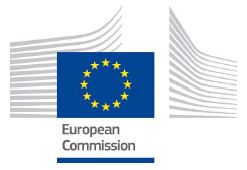 |
In its Final Assessment Report of iNTeg-Risk Project (www.integ-risk.eu) the European Commission flagged the project and the work of the consortium made up of 60 beneficiaries and 29 Third Parties as a "success story".
 |
In its Final Assessment Report of iNTeg-Risk (www.integ-risk.eu) the European Commission flagged the project and the work of the consortium made up of 60 beneficiaries and 29 Third Parties as a "success story" (the Report is available for Project Partners at http://www.integrisk.eu-vri.eu/home.aspx?lan=230&tab=533&itm=534&pag=594).
The EC explicitly highlights EU-VRi's project management ("outstandingly effective and efficient") for this complex large collaborative project which has received more than 12.5 Million EUR funding from 2008 to 2013.
The follow-up initiatives, such as the European Emerging Risk Radar (E2R2) or the European Common House Safety are underway and we are looking forward to build up on the results that have been achieved in iNTeg-Risk.
|
|
|
|
|
|
|
19 Apr
2014 |
Survey to identify existing regulations in force in EU on Li-ion battery systems |
 |
The STABALID project has launched a survey aiming at identifying existing regulations in force in EU on Li-ion battery systems.
 |
Survey to identify existing regulations in force in EU
on Li-ion battery systems |
Period of consultation: From 02.04.2014 to 19.04.2014
Objective of the consultation:
In relation with the initiative developed by the EU FP7 project STABALID, you are invited to take part in this survey to provide information to identify existing regulations in force in EU on Li-ion battery systems.
Further information at the following link: http://stabalid.eu-vri.eu/Survey_Run.aspx?ID=563 |
|
|
|
|
|
10 Apr
2014 |
"Das Fürchten lernen" |
 |
Ortwin Renn, President of EU-VRi, gave an interview with ZEIT about (incorrect) assessments of hazards.

|
EU-VRi President, Prof. Ortwin Renn, talked with the German national weekly newspaper ZEIT about the reasons why people assess the different hazards incorrectly.
The whole interview in German is to be seen using the link.
|
|
|
|
|
|
|
26 Mar
2014 |
Joining forces through Smart Specialisation : Synergies between ESIF and Horizon 2020 for Key Enabling Technologies |
 |
Info Day organised by the European Commission in cooperation with the Committee of the Regions.

|
Joining forces through Smart Specialisation :
Synergies between ESIF and Horizon 2020
for Key Enabling Technologies
|
Info Day organised by the European Commission in cooperation with the Committee of the Regions will take place on March 26, 2014 in Brussels.
In view of the upcoming publication of the guidelines on synergies between European Structural and Investment Funds and Horizon 2020, the information day aims to continue raising awareness on Key Enabling Technologies (KETs) as drivers for industrial competitiveness in regions. It aims to stimulate regions to take-up KETs that are relevant for their smart specialisation strategies and operational programmes, and to promote synergies and interregional cooperation between national/regional authorities and industrial, research and innovation stakeholders.
Registration and agenda are available at http://s3platform.jrc.ec.europa.eu/joining-forces-through-s3 |
|
|
|
|
|
10 Mar
2014 |
European Innovation Convention 2014 |
 |
European Commission President José Manuel Barroso will host the 2nd Innovation Convention in Brussels on March 10 and 11, 2014.
European Innovation Convention 2014
European Commission President José Manuel Barroso will host the 2nd Innovation Convention in Brussels on March 10 and 11, 2014.
Already established as Europe’s leading innovation event, the Convention will bring together a unique gathering of world-class visionaries and innovators, including CEOs from some of Europe's top companies, young innovators and net-entrepreneurs, such as the founders of Prezi and Storify.
It will explore innovation in all its facets and cover a variety of themes with more than 2000 visitors expected to attend to hear a range of speakers including: the CEOs of Telefonica, Jaguar Landrover, Airbus, Bayer, Nokia, Safran Group and Sanofi Aventis, Nobel Prize winner Serge Haroche, Professor Athene Donald from Cambridge and Lord Patten from Oxford, among many others.
Join the innovation debate and register for free on the event website: www.ec.europa.eu/euic2014 |
|
|
|
|
|
28 Feb
2014 |
Consultation - Identify the needs related to safe lifetime extension and aging management of infrastructures networks and industrial plants |
 |
(SURVEY - 2nd round) You are invited to participate to the identification of the needs related to safe lifetime extension and aging management of infrastructures networks and industrial plants - Deadline: February 28, 2014
CONSULTATION
In relation with the initiative developed by the EU FP7 project SafeLife-X coordinated by EU-VRi, you are invited to take part in the second round of the survey to provide information to identify the needs related to safe life extension management of aged infrastructures networks and industrial plants, as expressed by the various stakeholders involved in the project, i.e. the industry from various sectors (construction, transport, energy, industrial plants, pipeline networks…), from service to industry companies dealing with inspection and certification, from public authorities and from research organizations.
http://www.safelife-x.eu-vri.eu/Survey_Run.aspx?ID=557
We draw your attention on the "Suggestion" columns that are the most important aspect of this survey.
We kindly ask you to provide your inputs by February 28, 2014.
Don't hesitate to contact us at SafeLifeExtension@eu-vri.eu if you have any question. |
|
|
|
|
|
19 Dec
2013 |
Call for expression of interest for experts |
 |
The European Commission has launched a call for expression of interest for experts for the evaluation of proposals under Horizon 2020.
Call for expression of interest for experts for the evaluation of proposals under Horizon 2020
The European Commission has launched a call for expression of interest for experts for the evaluation of proposals under Horizon 2020, the EU new funding instrument for Research and Innovation (2014-2020), and for other tasks as described in the call.
Experts can register in the database on their own initiative or be named by organisations.
EC is looking for experts specifically for the Horizon 2020 part "Industrial Leadership - Leadership in Enabling and Industrial Technologies" (LEIT), and therein for the Key Enabling Technologies (KET), notably for:
- Nanotechnologies,
- Advanced materials,
- Advanced manufacturing and processing
- Biotechnology
and for cross-cutting and interdisciplinary questions.
If you are already registered in the FP7 experts' database and you are interested to continue under H2020, you are invited to update your profile on the Participant Portal.
Other interested experts are welcome to register new on the Participant Portal.
Registered and new experts should tick the Horizon 2020€ box, and indicate their fields of expertise related to the NMP+B part of H2020.
You are invited you to pay particular attention to the following 2 sections of the registration process:
- Area of expertise, section C "Open Keywords": please make sure that your keywords adequately reflect your area of expertise. These open keywords will be an essential tool for EC staff to identify relevant experts for specific calls for research proposals.
- Professional experience, section C "publications and achievements": if not all your publications can be referred to, make sure that you select the most important ones and those that demonstrate best your expertise in the open keywords chosen previously. Please do similarly for your achievements.
All details on this call for experts can be found on the Participant Portal. |
|
|
|
|
|
05 Nov
2013 |
European Conference HRO |
 |
In November, a HRO event connecting researchers and practitioners of High Reliability Organizations with the aim to exchange ideas and solutions across enterprises and industries will be organized in France.
European Conference HRO
In November, a HRO event connecting researchers and practitioners of High Reliability Organizations with the aim to exchange ideas and solutions across enterprises and industries will be organized in France.
High Reliability Organizations (HROs) are a subset of organizations that exhibit continuous, nearly error-free operations, even in multifaceted, turbulent, and dangerous task environments. The Conference’s purpose is to disseminate the most recent findings in HRO theory, find cross-pollinations with related disciplines and share practical experiences, in order to provide new avenues for research and new long-term solutions for practice.
Participants:
This Conference invites interaction between researchers, practitioners (from front-end operators to top managers), and regulators to characterize, deepen and spread these approaches. Members of organizations not operating in dangerous task environments can also benefit from the lessons learned by HROs, in order to become more reliable, to reach for higher quality standards and, more broadly, to develop capacities for detecting and responding to situational changes.
Programme:
Highly interactive presentations and discussions will address key issues of high reliability organizing, such as learning from near misses, making sense of early warnings, real-time response, humans as the last barrier, and HRO based change. Discussions will be consolidated from the following perspectives:
- Theory: The aim is to present the latest theoretical developments in HRO theory and to explore the potential cross-pollinations between HRO and related disciplines such as resilience engineering, communication, ergonomics, cognitive psychology, neurosciences and philosophy.
- High reliability in critical industries: Practitioners will be encouraged to consider HRO ideas to describe their operations in terms that help diagnose problems or improve performance. A special focus is placed on the petro-chemical, aviation, nuclear and healthcare industries. Participants from other sectors are also welcome, as they will benefit from cross-industry learning opportunities.
- Societal resilience: The common assumption to all proposed panels is that HRO ideas can contribute to anticipate, avoid or mitigate disruptions to our societies. Specifically, HRO precepts will be mobilized in the perspective of new emerging risks, risk management methodologies and enhanced societal response.
Sitting in the “hot seat:” Top Executives as Incident Commanders
SDIS13 will host the Conference in its newly-built training facilities. They include a virtual reality based training platform, used by France’s civil protection to train the highest levels of Incident Management Teams. We will give the opportunity to top executives to successively stand in the shoes of an Incident Commander (IC) during a high tempo, risky and complex operation. In a plenary session, all participating executives will reflect on their experience and, more broadly, the lessons they learned about Crisis management.
Technology and Services for High Reliability
A permanent exhibition room will showcase innovative products and services that contribute to helping individuals and teams operate more reliably. Examples include eye tracking systems, biosensors, training simulators or situational awareness enhancing tools. This exhibition room is seen as a venue to encourage researchers and larger industries to engage with startup entrepreneurs and to think of innovative projects.
Poster session
Research posters from both academia and industry will be displayed during the conference. They will describe findings of recently completed projects, encouraging preliminary results of ongoing projects and innovative ideas for future research, to be discussed with other researchers or potential SME/Industry partners.
website: http://hro.pole-risques.com/
Email: info.hro2013@gmail.com / scientific.hro2013@gmail.com |
|
|
|
|
|
20 Sep
2013 |
NanoMILE hosts NanoSafetyCluster meeting: 20/9 Birmingham |
 |
Following its 2nd General Assembly, NanoMILE is hosting a NanoSafetyCluster meeting on 20/9. This meeting is open for registration.
|
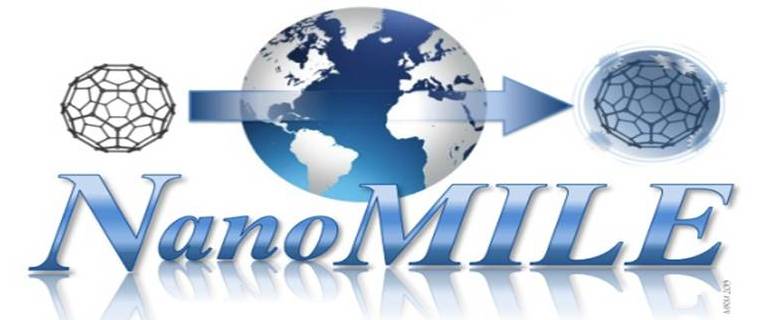 hosts hosts 
|
Location: University of Birmingham.
Please register to the meeting by using this link.
Please find here the Agenda of the NSC meeting.
The meeting of the Working Group 7 (Dissemination) will focus on standardization: landscape, process, improvement through the nanoSTAIR service: please find the agenda here. |
|
|
|
|
|
17 Jun
2013 |
22nd SRA-Europe annual conference |
 |
The 22nd SRA-Europe annual conference will be held 17-19 June 2013 at the Norwegian University of Science and Technology in Trondheim, Norway.

22nd SRA-Europe annual conference
The 22nd SRA-Europe annual conference will be held 17-19 June 2013 at the Norwegian University of Science and Technology in Trondheim, Norway.
The special theme of the conference is «Safe societies – coping with complexity and major risk», concerning challenges related to our society’s vulnerability to major risk of natural and industrial disasters, malicious attacks, financial breakdowns, and epidemic diseases.
The conference endeavors to facilitate cross-disciplinary research and collaboration across actors in the risk field to create safer societies by strengthening our ability to govern major risks and ensuring balanced development in a complex and uncertain world.
The conference is open to all interested researchers and experts in the various fields of risk analysis. Industry representatives are also encouraged to participate.
The Society for Risk Analysis - Europe
SRA-Europe aims to bring together individuals and organisations interested in risk assessment, risk management and risk communication in Europe. SRA-Europe is a regional section of the Society for Risk Analysis, which is an international society that provides an open forum for all those who are interested in risk analysis, including risk assessment, characterization, communication, management, and policy across all sectors and societal levels.
The 22nd Annual conference of SRA-E in 2013 is arranged by the ROSS Geminisenter which is a strategic network between the Norwegian University of Science and Technology and SINTEF. ROSS endeavors to develop knowledge, methods, and tools to prevent major accidents through interdisciplinary studies on risk and vulnerability.
Key note speakers
The following have tentatively accepted to give keynote presentations:
-
Elisabeth Paté-Cornell, Stanford University, USA
-
Nick Pidgeon, Cardiff University, UK
-
David D Woods, Ohio State University, USA
Spesific topics and call for abstracts
The special theme of the conference, «Safe societies – coping with complexity and major risk», is reflected in this list of specific topics. Abstracts and symposia within these topics are wanted before February 15, 2013.
Conference pamphlet
Download conference pamphlet here.
Book of abstracts
The book of abstracts can now be downloaded at http://www.srae2013.no/lib/exe/fetch.php?media=abstracts_v2.pdf
Further information available at the following web address: http://srae2013.no/ |
|
|
|
|
|
10 Jun
2013 |
OECD - PLANNING GUIDE FOR PUBLIC ENGAGEMENT AND OUTREACH |
 |
The OECD Working party on nanotechnology developed a guide for planning outreach and public engagement in nanotechnology.
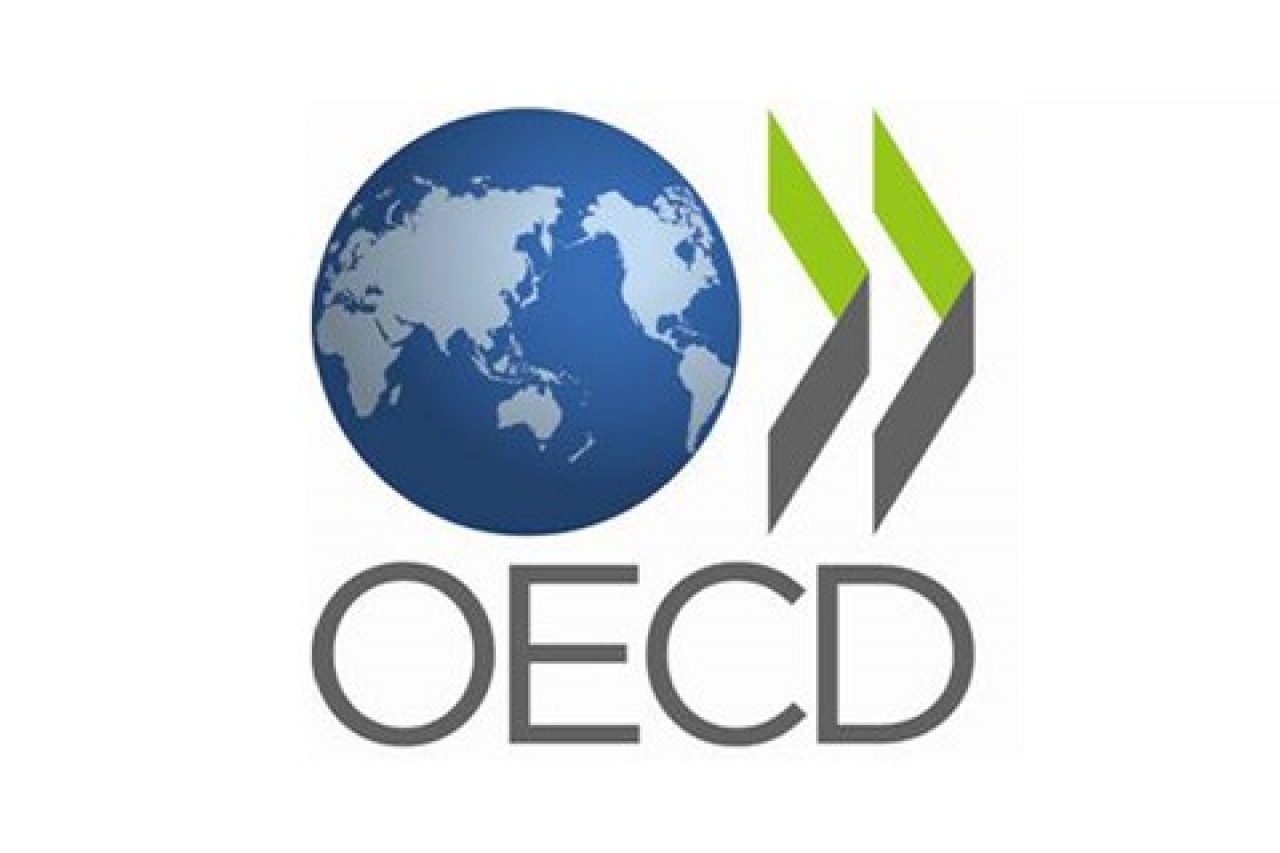
|
OECD - PLANNING GUIDE FOR PUBLIC ENGAGEMENT AND OUTREACH |
The OECD Working party on nanotechnology developed a guide for planning outreach and public engagement in nanotechnology.
This guide identifies key issues to be considered by policymakers involved as organisers, commissioners, or funders of public engagement activities in nanotechnology.
http://www.oecd.org/sti/biotech/49961768.pdf
|
|
|
|
|
|
20 May
2013 |
Accompanying course to the 5th iNTeg-Risk Conference on the topic of ISO 31000 |
 |
The course 'ISO 31000 Principles and Management' was held just before the 5th iNTeg-Risk Conference 2013 on May 20, 2013. This course touched on the key elements in the International Standard of ISO 31000:2009; the complex relationship between risk management principles, frameworks and processes and the applications in industry and in general.
V-R32 ISO31000: 'ISO 31000 Principles and Management'
on May 20, 2013 in Stuttgart, Germany hosted and organized by R-Tech
Lecturer: Prof. Aleksandar S. Jovanovic, STI R-Tech
Venue: Steinbeis Transfer Institute Advanced Risk Technologies, Haus der Wirtschaft, Willi-Bleicher-Str. 19,
70174 Stuttgart, Germany
At the end of the course, students are expected to have basic knowledge about:
- main principles of the ISO 31000 standard
- ISO 31000 framework for managing risk
- implementation principles of the ISO 31000 standard
- related standards
- open issues in ISO 31000
- further development of ISO 31000 (ISO 31004, new revisions)
Course content by Units
|
Unit 1: Introduction to the ISO 31000 philosophy and principles
|
Duration
(minutes)
|
|
Explanation on the philosophy and basic principles of ISO 31000
|
60
|
|
Review and conclusions of the Unit 1. Questions and answers.
|
15
|
|
Unit 2: ISO 31000 Framework
|
Duration
|
|
Overview of the ISO 31000 framework for risk management
|
60
|
|
Review and conclusions of the Unit 2. Questions and answers.
|
15
|
|
Unit 3: Implementation principles of ISO 31000
|
Duration
|
|
Explanation on implementing the ISO 31000 risk management framework
|
60
|
|
Review and conclusions of the Unit 3: Questions and answers
|
15
|
|
Unit 4: Practical aspects of implementation
|
Duration
|
|
Elaboration on the practical aspects of implementing ISO 31000
|
60
|
|
Review and conclusions of the Unit 4: Questions and answers
|
15
|
|
Unit 5: Review and final discussion
|
Duration
|
|
Review of main course issues and final discussion
|
30
|
|
Closing the course
|
-
|
Announcement / Course Profile / Registration
Register before April 15, 2013 and you will receive a 10% discount from the registration fee! Final application deadline: May 6, 2013.
The course is intended for:
- professionals responsible for developing risk management policy within their organization
- professionals accountable for ensuring that risk is effectively managed within the organization as a whole or within a specific area, project or activity
- developers of standards / guides / procedures / codes of practice that, in whole or in part, set out how risk is to be managed within specific context(s)
- other professionals (engineers, managers, inspectors, legislators, etc.) who wish to deepen their knowledge in the field of risk management standardization
- individuals with no previous experience in the field of risk management standardization, but willing to extend their knowledge and take up new roles in this field within their companies
- university student
Direct contact: sti889@risk-technologies.com
Mr. Andras Veres
Tel: +49 711 1839 647
av@risk-technologies.com
Ms. Roswitha Kokejl
Tel: +49 711 1839 616
rk@risk-technologies.com |
|
|
|
|
|
22 Apr
2013 |
Learn about robust decision making in risk management |
 |
The SHB/iNTeg-Risk course 'Decision Aid Approaches for Risk Management' is organized on April 22 - 26, 2013 in Stuttgart, Germany. The participants benefit from the course by acquiring the basic knowledge about 1) main concepts related to decision making in risk management; 2) key decision making moments of risk management frameworks; and 3) tools available to improve the way managers are dealing with decision making.
VF-R39 DAA: 'Decision Aid Approaches for Risk Management'
on April 22-26, 2013 in Stuttgart, Germany hosted by the International Center for Culture and Technology Research at the University of Stuttgart and organized by R-Tech
Lecturer: Dr. Chabane Mazri, INERIS - Institut National de l'Environnement Industriel et des Risques (France)
Venue: Internationales Zentrum für Kultur- und Technikforschung (IZKT), Geschwister-Scholl-Straße 24, 70174 Stuttgart, Germany
Decision making is a process where multiple factors interact to shape the final outcome. Those factors can be technical, informational, emotional/psychological, cultural… Nevertheless, the limited rationality of economic operators makes the decision exercise more and more difficult in a more and more complex world. Safety management requires short, mid and long term decisions that may highly influence the ability of the organization to cope with its risks.
Course content by Units
|
Unit
|
Title & contents in brief
|
|
1.
|
Introduction to decision making in risk management
- Present how decision making may shape the way organization deals with risk. Through the study of various risk management frameworks (IRGC, ISO31000).
- Stakes and challenges associated to those critical phases will be highlighted.
|
|
2.
|
Reference models
A global presentation of the way decision making is considered through different disciplines and theoretical frameworks. At the end of this second phase, the students will develop a good overview of the reference models and theories related to decision making.
|
|
3.
|
Methods and tools
The scope of decision support tools is large. This section will introduce the most frequently used tools and methods within organizations dealing with risks.
Highlights will be given to:
- Multicriteria approaches like ELECTRE and Multi Attribute Utility Theory.
- Methods to elaborate and choose Key Performance Indicators for risk management.
- Uncertainties management in decision making.
|
Announcement / Course Profile / Registration
The registration is free of charge, anyone interested in the topic are welcome on the course. Please note, however, that the course is intended for 20-25 participants. The registrations will be processed on the first-applied-first-served basis. Final application deadline: April 15, 2013.
The course targets attendees with inimum mathematical background and openness to psychological and behavioral approaches of decision makin.
Direct contact: sti889@risk-technologies.com
Mr. Andras Veres
Tel: +49 711 1839 647
av@risk-technologies.com
Ms. Roswitha Kokejl
Tel: +49 711 1839 616
rk@risk-technologies.com |
|
|
|
|
|
17 Apr
2013 |
SHB/PromisLINGUA course on Intercultural Management & Communication |
 |
The course 'Business Communication and Management of Intercultural Differences' has taken place on April 17, 2013 in Stuttgart, Germany. The course stressed the importance of cultural differences and multilingual issues for the success of collaboration with partners from other cultural background, particularly in international projects. The course was organized to promote the results of the PROMISLingua project among SMEs.
IVC-R19 BC&M: 'Business Communication and Management of Intercultural Differences'
on April 17, 2013 in Stuttgart, Germany hosted and organized by R-Tech
Lecturer: Prof. Aleksandar S. Jovanovic, STI R-Tech
Venue: Stuttgart Institute of Management and Technology (SIMT), Filderhauptstraße 142, 70599 Stuttgart (Plieningen), Germany
The purpose of this course is exactly to assure that engineers, managers and IT experts can understand the importance of these aspects for the success of their collaboration with partners from other cultural background. It will address issues such as
- Intercultural value systems
- Differences in cultural practices
- Cross-cultural project management
- Individualism vs. Teamwork
- Successful management of cultural differences as a factor of success in international projects
- What one should know, do or not do in an EU project
- Case studies: US, Japan, India, China ...
Course content by Units
Unit 1: Successful management of cultural differences as factor of success of IT and other projects
Unit 2: Multicultural contexts – what you should know, what you should do, what you should not do…
Unit 3: Multilingual environments in international projects
Unit 4: Essentials of Business communication & Elements of Human Resources Management in multinational projects
Announcement / Course Profile / Registration
Among others, the course is intended to promote the results of PROMISLingua project among SMEs. Due to these promotional purposes, the registration for PROMISLingua members and for SMEs is free of charge. For any other individuals and organizations (not SMEs), the registration fee is EUR 500.
Register before March 27, 2013 and you will receive a 10% discount from the registration fee! Final application deadline: April 14, 2013.
The course targets attendees such as:
- Engineers
- Managers of IT and other companies
- Project managers
Direct contact: sti889@risk-technologies.com
Mr. Andras Veres
Tel: +49 711 1839 647
av@risk-technologies.com
Ms. Roswitha Kokejl
Tel: +49 711 1839 616
rk@risk-technologies.com |
|
|
|
|
|
08 Apr
2013 |
SHB/iNTeg-Risk: 'Quantitative- and Transportation Risk Assessment' courses in April |
 |
Two courses have been held in the first half of April on the topics of Risk Assessment techniques, frequency and consequence assessment, risk index calculations and advanced applications by case studies. The courses were lectured by recognized professors of chemical and safety issues from the CONPRICI group of Italian universities. For detailed description, click on
VD-R26 QRA&A: 'Quantitative Risk Assessment and Advanced Applications'
on April 8-12, 2013 in Stuttgart, Germany hosted and organized by STI R-Tech.
Lecturers: Prof. Valerio Cozzani, University of Bologna; Dr. Ernesto Salzano, CNR - Combustion Research Institute; Dr. Alessandro Tugnoli, University of Bologna
Venue: Stuttgart Institute of Management and Technology (SIMT), Filderhauptstraße 142, 70599 Stuttgart (Plieningen), Germany
The course presents an introduction to Quantitative Risk Analysis, thus illustrating the necessary steps for the calculation of risk indexes. Practical approach to frequency calculation and consequence assessment, including vulnerability models, will be discussed. A specific focus on domino effect and accidents triggered by Natural-Technological (Na-Tech) events will be presented.
Course content by Units
|
Unit
|
Title & contents in brief
|
Duration (minutes)
|
|
1.
|
Definitions and risk metric
- Risk indexes: definition and use
- Risk tolerability and acceptability criteria
|
180
|
|
2.
|
Basic elements for risk calculation: scenario selection, frequency and consequence assessment
- Scenario selection from hazard identification. Parameters needed for the quantitative assessment of a scenario. Assumptions needed for the analysis of a scenario.
- Frequency calculation: use of results from fault tree analysis; parts count.
- Consequence assessment: use of models for consequence assessment.
|
240
|
|
3.
|
Risk calculation
- Vulnerability models. Vulnerability maps and influence of meteorological conditions.
- Simplified examples of risk calculation: individual risk, IRPA, societal risk, example of risk-based decision making;
|
120
|
|
4.
|
Quantitative assessment of domino effect
- Examples of approach to quantitative assessment (threshold models, probabilistic models, advanced deterministic models)
- Analysis of domino effect in complex industrial layouts
- Simplified examples of risk calculation
|
300
|
|
5.
|
Assessment of the industrial risk induced by natural events (Na-Tech)
The main steps of the procedure developed for the assessment of Na-Tech accidents will be presented:
- Characterization of the natural event
- Identification of target equipment, damage states and reference scenarios
- Estimation of the damage probability, detailed fragility models
- Consequence evaluation of the reference scenario, identification of credible combinations of events
- Frequency/probability and consequence calculation for each combination
- Calculation of risk indexes, Early warnings
|
420
|
|
6.
|
Case-studies and use of risk results
- Simplified assessment of an Oil&Gas installation: simplified calculation of risk indexes and risk-based decision making;
- Example of domino effect and Na-Tech implementation in risk assessment
|
420
|
Announcement / Course Profile / Registration
Register before March 22, 2013 and you will receive a 10% discount from the registration fee! Final application deadline: April 1, 2013.
VD-R35 TRA: 'Transportation Risk Assessment'
on April 15-19, 2013 in Stuttgart, Germany hosted and organized by STI R-Tech.
Lecturers: Prof. Giuseppe Maschio, University of Padova; Dr. Giacomo Antonioni, University of Bologna; Dr. Gabriele Landucci, University of Pisa
Venue: Stuttgart Institute of Management and Technology (SIMT), Filderhauptstraße 142, 70599 Stuttgart (Plieningen),
Germany
The aim of the course is the introduction to transportation risk analysis. The risk assessment of road, rail and pipeline transportation of hazardous substances will be illustrated. The approaches to frequency calculation, consequence assessment and risk assessment will be discussed. Case-studies will be analyzed to illustrate the calculation and the use of individual, societal and other advanced risk indexes.
Course content by Units
|
Day
|
Title & contents in brief
|
Duration
|
Lecturer
|
|
1.
|
(UNIT 1) Hazards in the land transportation of hazardous substances
- Relevant past accidents in road, rail and pipeline transportation of hazardous substances. Statistical data and relevance of the problem.
- Characterization of risk sources.
- Applicable standards and legislation (ADR, RID, voluntary agreements, etc.)
|
5 h
|
Prof. Maschio
|
|
(UNIT 2) Basic elements for risk calculation: scenario selection, frequency and consequence assessment
- Scenario selection from hazard identification. Parameters needed for the quantitative assessment of a scenario. Assumptions needed for the analysis of a scenario.
|
2 h
|
|
2.
|
(UNIT 2 - continued)
- Frequency calculation: accident statistics, failure data.
- Consequence assessment: use of models for consequence assessment.
(UNIT 3 – part 1) Risk for the environment and tunnel fires
- Tunnel fires. Analysis of past accidents. Complicating phenomena. Modeling tools.
|
3.5 h
|
Prof. Maschio
|
|
(UNIT 3 – part 2 continued ) Risk for the environment and tunnel fires
- Scenarios causing environmental damage. Modeling tools and approach to risk assessment. Magnitude of environmental damage. Parameters needed for the quantitative assessment of a scenario.
|
3.5 h
|
Dr. Antonioni |
|
3.
|
(UNIT 4 - introduction)
- Frequency calculation: accident statistics, failure data
- Representation of linear risk sources
- Calculation of damage and risk. Simplified and detailed approaches.
|
3.5 h
|
Dr. Antonioni
|
|
(UNIT 4 – continued) Basic elements for risk calculation: scenario selection, frequency and consequence assessment
- Examples of risk calculation
|
3.5 h
|
|
4.
|
(Unit 4 – continued)
- Examples of risk calculation
|
3.5 h
|
Dr. Antonioni
|
|
(Unit 5) Use of risk results
- Examples of risk-based decision making. Direct calculation of risk for different routes.
- Cost benefits Analysis of passive protections.
|
3.5 h
|
Dr. Landucci |
|
5.
|
- Tutor day - Self learning
|
5.5 h
1.5 h
|
Dr. Landucci
|
Announcement / Course Profile / Registration
Register before April 1, 2013 and you will receive a 10% discount from the registration fee! Final application deadline: April 8, 2013.
Both courses are dedicated to participants interested in advanced applications of risk assessment:
- Professionals dealing with risk issues on management and operational level
- Individuals with experience in industrial safety and risk assessment
- Students of mater courses in Process, Industrial, Risk engineering or similar courses
Direct contact: sti889@risk-technologies.com
Mr. Andras Veres
Tel: +49 711 1839 647
av@risk-technologies.com
Ms. Roswitha Kokejl
Tel: +49 711 1839 616
rk@risk-technologies.com |
|
|
|
|
|
18 Jan
2013 |
SHB/iNTeg-Risk course HSSE: Health, Safety, Security and Environment successfully concluded |
 |
The event was part of the series of courses belonging to the joint effort of iNTeg-Risk project (represented by EU-VRi and other partners) to set a modern, modular and distributed model of education and certification in the area of Risk Engineering and Management, with particular emphasis on the issue of emerging risks. The HSSE course took place in Paris, January 14 - 17, 2013 and was hosted by the iNTeg-Risk partner, INERIS.
| The SHB/iNTeg-Risk course HSSE: Health, Safety, Security and Environment provided the participants with the essentials of HSSE management in Europe by giving an overview of EU regulation in the field of HSSE, explaining the objectives and requirements as well as the state-of-the art in the implementation including constraints and advantages. Special focus was also given to the Integrated Pollution Prevention and Control (IPPC) directive, Industrial Emission Directive (IED) and the directive on prevention of major accidents (Seveso). Click here to see details about the course.
This course took place in Paris from January 14 - 17, 2013 and was hosted by the iNTeg-Risk partner, INERIS. The course was led by Mr. Olivier Salvi (INERIS/EU-VRi) as the main lecturer.
Check out also our calendar of courses to find other topics which may be of interest for you!
|
|
 |
|
|
|
|
|
|
14 Dec
2012 |
SafeChina project: Commencement ceremony on Jan. 12, 2013 |
 |
The SafeChina commencement ceremony and the company promotion event for 'Steinbeis Advanced Risk Technologies China' took place on Jan. 12, 2013, at BMILP in Beijing.
SafeChina project:
Commencement ceremony Jan. 12, 2013
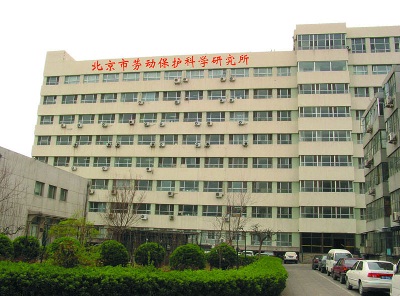
Beijing Municipal Institute of Labour Protection
No. 55 Taoranting Road, Beijing, 100054
The SafeChina project (http://www.safechina.risk-technologies.com) approaches its planned end in February 2013. The project main aim has been to build a sustainable education service in China offering the engineers and relevant professions the possibility to learn about the EU safety practices and regulation, and qualify as Environmental- and Safety engineers according to EU criteria, guidelines and practice. The project has been financed by DEG - Deutsche Investitions- und Entwicklungsgesellschaft mbH (German Investment and Development Agency) and realized by Steinbeis University Berlin (SHB) represented by Steinbeis Transfer Institute Advanced Risk Technologies and Beijing Municipal Institute of Labor Protection BMILP (www.bmilp.com), as the main strategic partner of Steinbeis in China.
The SafeChina project has created:
a) a curriculum of courses in Risk Engineering and Management adapted to the needs of Chinese beneficiaries,
b) a pattern for on-the-job training in EU/Germany and
c) a certifications scheme for Chinese professionals.
So far, the project has already achieved most of its goals, so far namely:
- performed a large-scale survey of Chinese needs in the area of industrial safety
- signed cooperation agreements with 17 Chinese partners
- signed cooperation agreements with INERIS, France and DEKRA, Germany
- prepared the curriculum of 12 full courses, fully translated in Chinese
- organized 14 instances of the above courses, attended by almost 500 participants
- certified over 400 professionals (passed various levels of exams)
- had already 14 short and 3 long on-the-job-trainings for Chinese professionals in Germany
- qualified 18 Chinese trainers in the framework of the train-the-trainer measures
- incorporated courses from the project in the curricula of one of the Chinese top-class universities, CUEB
- negotiates incorporation of the courses into one of the Chinese top universities, Tsinghua
- negotiates incorporation of the courses into the professional education in Chinese companies (Sinopec, Ping An, etc.)
- prepares an independent German-Chinese joint venture ("Steinbeis Advanced Risk Technologies Beijing") which will continue project activities after the official DEG-project end, i.e. after February 2013.
The project activities performed so far have been evaluated as "excellent" or "very good" by approx. 90% of all the Chinese stakeholders/participants in the project.
The event of January 12, 2013 was the occasion to award certificates to the Chinese professionals who have earned them as Risk Examiners and Risk Assessors, as well as Chinese trainers for the Safe-China courses (certified in the train-the-trainer program).
Draft Agenda
|
9:00 – 9:40
|
Welcome
|
|
9:00 – 9:20
|
Brief introduction of the speakers attending the ceremony and welcome address (Prof. Zhang Bin, General director of BMILP)
|
|
9:20 – 9:30
|
Welcome DEG officer (Ms. Veth [ytbc])
|
|
9:30 – 9:40
|
Welcome Steinbeis (Prof. Johann Löhn, President of Steinbeis University Berlin and former Government Commissioner for Technology Transfer in the State of Baden-Württemberg / Prof. Aleksandar Jovanovic, SafeChina Project Coordinator)
|
|
9:40 – 11:00
|
Presentations / Guest and keynote speeches
|
|
9:40 – 10:00
|
Presentation of the SafeChina project and its results / Presentation of the joint venture “Steinbeis Advanced Risk Technologies Beijing” (A. Jovanovic)
|
|
10:00 – 10:15
|
Keynote speech (Officer of Beijing Administration of Work Safety)
|
|
10:15 – 10:30
|
Keynote speech (Officer of State Administration of Foreign Experts Affairs)
|
|
10:30 – 11:00
|
Guest speech: Globalized Innovation and the Role of BRIC Countries (Prof. Manuel Heitor, former Secretary of State for Science, Technology and Higher Education in the Government of Portugal)
|
|
11:00 – 11:15
|
Short break
|
|
11:15 – 12:30
|
Guest and keynote speeches
|
|
11:15 – 11:30
|
Keynote speech (Officer from one department of State of Administration of Work Safety)
|
|
11:30 – 11:45
|
Keynote speech (Officer from another department of State of Administration of Work Safety)
|
|
11:45 – 12:15
|
Guest speech: Global education for global risks (Prof. Ortwin Renn, Member of the German Federal Government Ethics Committee on Energy Future)
|
|
12:15 – 12:30
|
Keynote speech (Mr. Ding Hui, President of Beijing Academy of Science and Technology)
|
|
12:35 – 13:00
|
Awarding the certificates
|
|
|
In two tracks (A-M and N-Z, handed out by Prof. Ding Hui, Prof. A. Jovanovic, DEG officer and Mrs. M. V. Florin [IRGC])
|
|
13:00
|
Closing announcement (Prof. Zhang Bin)
|
NOTES:
1. The event will be take place in conjunction with the IRGC International Conference in Beijing, on the topic of “From crisis management to risk governance” on 9-11 January 2013.
2. Possibility of establishing a cross-link to the EU project 2011/S 112-183587 will be explored.
About the hosting institution:
The Beijing Municipal Institute of Labor Protection was established in 1956 and is one of the first research institutes in China to carry out scientific research on security and environment. The institute has built many research institutes of professional techniques and test centers in the following three fields: urban security hygiene, work safety and labor protection and human living environment, which have laid solid foundation for a basic, applied and foresighted research. In the latest 50 years, it has achieved more than 500 scientific and technological results and won more than 200 awards for scientific and technological achievements and progress. It has stipulated more than 100 standards in labor protection and environment protection.
|
|
|
|
|
|
30 Nov
2012 |
SAFETY SCIENCE: CALL FOR PAPERS |
 |
This call for papers is intended to contribute towards making scientific foundations more explicit to the community of safety scientists.
SAFETY SCIENCE: CALL FOR PAPERS
Special Issue on the foundations of safety science
This call for papers is intended to contribute towards making scientific foundations more explicit to the community of safety scientists.
Safety as a particular science can be claimed to have emerged in relation to social ambitions for increased safety and security – developing, experimenting and testing practical methods, tools and models with the aim of understanding and managing unwanted actions or events. However, being “applied” in nature does not mean that safety science is philosophy-free. All knowledge claims about safety are based on some form of foundational assumptions, rationality and logics. The ‘science’ part of ‘safety science’ seeks to ensure rigorousness of theories and methods for research, while providing credibility for the field and the community of people contributing to the domain.
This call for papers is intended to contribute towards making scientific foundations more explicit to the community of safety scientists. The aim of this special issue is to facilitate an understanding of the philosophical underpinnings of safety science and the construction of a more systematic view on the foundations of safety science.
Original contributions are invited that deal, for example, with the following questions:
- Key concepts and underlying assumptions affecting safety science
- The object of study and the aim of safety science
- Moral implications of the philosophical foundations of theories of safety science
- Explanation and causality in safety science
- Prediction in safety science
- Duality of subjective and objective in safety science
- The question of emergence in safety science
- Philosophical underpinnings of Resilience Engineering, Behaviour Based Safety, Safety Culture, High Reliability Organisations, etc.
The deadline for receipt of papers is November 30th, 2012, with publication expected for the second quarter of 2013.
All papers will be subjected to the standard peer-review procedures of the journal.
Papers should be submitted online via the Elsevier Editorial System ( http://ees.elsevier.com/safety/)
Further information is available at the following link:
http://www.journals.elsevier.com/safety-science/call-for-papers/special-issue-on-the-foundations-of-safety-science/ |
|
|
|
|
|
25 Nov
2012 |
Certification activities in China |
 |
Certification tracks and the SafeChina train-the-trainer exams were organized on November 15-24, 2012 in Beijing.

Certification for Risk Examiners and for Senior Risk Assessor both on the tracks Plant/Asset/Equipment and HSSE, as well as train-the-trainer oral exams have been organized between November 15 and 24, 2012 in the Beijing Municipal Institute of Labour Protection.
|
The certification process, per candidate, went as the following:
- Presentation of a project done relevant for the title Risk Examiner/Risk Assessor (the candidate has to prepare a presentation in MS Power Point, 15 minutes/candidate)
- Discussion about the project presented (15 minutes/candidate)
- Conclusion related to the presented work
In addition to the certification, oral exams were organized for the candidates who have passed the written exams in order to become a SafeChina trainer. The oral part of the train-the-trainer exam consisted of:
- Presentation of a selected part of the training material for the SafeChina course (the candidate has to prepare a presentation in MS Power Point, 15 minutes/candidate)
- Questions and answers related to the course topics (15 minutes/candidate)
- Conclusion related to the presented work
|
|
|
|
|
|
15 Nov
2012 |
Nanosafe 2012 |
 |
The NANOSAFE project will organize the next edition of the International Conference on Safe production and use of nanomaterials Nanosafe 2012 on November 13-15, 2012, in Grenoble (France).
NANOSAFE 2012
The NANOSAFE project will organize the next edition of the International Conference on Safe production and use of nanomaterials Nanosafe 2012 on November 13-15, 2012, in Grenoble (France).
Following the successful outcome of the past International Conference on Safe production and use of nanomaterials Nanosafe 2010 that took place in Grenoble (France), the Organizing Committee has decided that the next edition will take place in MINATEC again in November 2012.
Topics
- Exposure assessment
- Detection and identification
- Toxicology
- Environmental interactions
- Nanomaterials release
- Protection technology
- Industrial production
- Life Cycle Analysis
- Ethics and societal issues
- Commercial equipement
- Risk management for OHS experts
- Regulation for nano products: REACH-US
policies on nanoparticles in consumer products
|
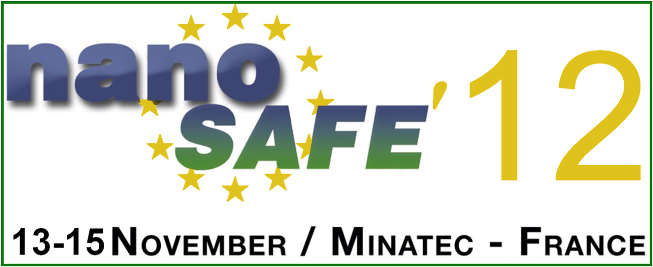 |
Programme
The three-day programme for this conference will comprise:
- Invited plenary lectures:
G.
Oberdörster (U. ROCHESTER), D. Pui (U. MINNESOTA), D. Brouwer (TNO), T.
Nhuyen (NIST), F. Schuster (CEA), B. Nowack (EMPA), R. Muir (NANEUM).
D. Bernard (ARKEMA), J. Rose (CEREGE), C. Engeman (UCSB) A. Grobe (U.
STUTTGART). A. Grinbaum (CEA), F. Roure (FRENCH MINISTRY FOR ECONOMY,
FINANCE AND INDUSTRY), A. Kishimoto (AIST, RISS), C. Emond (U.
MONTREAL), L. Golanski (CEA), O. Witschger (INRS), E. Drais (INRS), P.
SCHULTE (NIOSH/CDC), M. Puolamaa (European Commisssion, Brussels).
- Selected oral contributions
- Posters sessions
- Panel discussions: Governance/ Toxicology/ The opinion of the civil society regarding nanomaterials
- Exhibition of equipments related to safe production and use of nanomaterials
- Satellite meeting:TRIMATEC
Call for papers (Deadline for abstracts: August 30, 2012)
Papers will be presented in oral and poster sessions.
To submit a paper, please go at the following link:
http://www.nanosafe.org/scripts/home/publigen/content/templates/show.asp?P=134&L=EN&ITEMID=57
|
|
|
|
|
|
12 Nov
2012 |
SHB/SafeChina course 'Emerging Risks' concluded in Beijing |
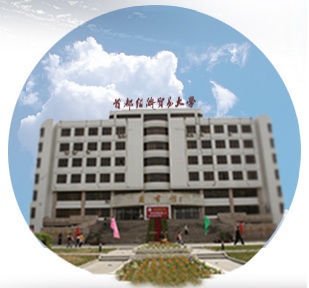 |
The Steinbeis University Berlin/SafeChina course Emerging Risks was held on November 10 - 11, 2012 in Beijing.
The course IV-R17 EmRISK: Emerging Risks has been taken place on November 10 - 11, 2012 at the Capital University of Economics and Business in Beijing.
The main objective of the course was to introduce the concept of "emerging risks" and explain to the students the issues of early recognition, classification and monitoring of emerging risks. In addition, the course presented frameworks, procedure and factors of emerging risks. 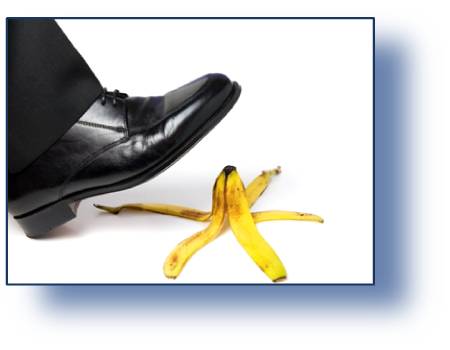
Emerging Risks was dedicated to professionals and students in the field of risk engineering and management. The structure of the course units and tutoring style allowed to understand and adopt the main topics even to beginners in this field.
The participants of the course have particularly benefited from the lecturing done by Prof. Aleksandar Jovanovic from STI Advanced Risk Technologies/EU-VRi, who is leader of some of the most important research and development projects in the EU dedicated to emerging risks (e.g. iNTeg-Risk).
For further information, see the announcement of the course. |
|
|
|
|
|
07 Nov
2012 |
STOA Workshop on E2R2 Initiative gained very positive support from the industry, academia and public sector |
 |
EU-VRi (www.eu-vri.eu) and iNTeg-Risk Consortium (www.integrisk.eu-vri.eu) prepared this workshop together with Science and Technology Option Assessment Committee of the European Parliament (STOA, http://europarl.europa.eu/stoa). Read more about the results of this workshop by clicking here to access the summary report!
|
STOA Workshop on E2R2
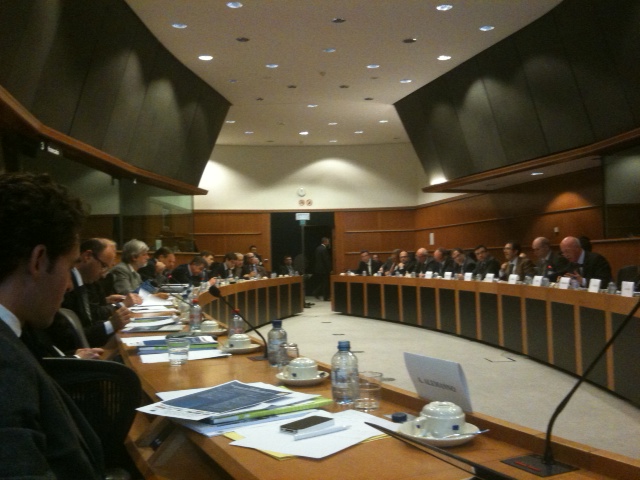
Click on the image to view enlarged version

Click on the image to view enlarged version
|
|
Results of STOA Workshop*
|
The STOA workshop on European Emerging Risk Radar (E2R2) Initiative, which took place on November 6, 2012 at the European Parliament in Brussels, successfully concluded with very positive support from the industry, academia and public sector. EU-VRi (www.eu-vri.eu) and the iNTeg-Risk Consortium (www.integrisk.eu-vri.eu) prepared this workshop together with Science and Technology Option Assessment Committee of the European Parliament (STOA, http://europarl.europa.eu/stoa) as an important follow-up to ensure the sustainability of the iNTeg-Risk results. Below are some of the key results from this workshop:
- Notable representatives from the industry, academia and public sector (see short profiles of the speakers and panelists) each presented and/or shared their perspectives regarding their support for the E2R2 Initiative. In summary,
- the Industry is in favor of E2R2 because the initiative could serve as a European reference source for emerging risk information and this will be of huge benefit for the EU industry as well as enhance its competitiveness;
- the Academia is in favor of E2R2 because, in view of the challenges for risk management in a fragmented environment with respect to European risk activities, the initiative poses as a strategic global advantage as well as a way to increase credibility and popularity for Europe; and
- the Public sector is in favor of E2R2 because the initiative promotes efficient use of available resources, enlarge the scope as well as increase the quality of results for governments, in particular, those which are already carrying out similar activities.
- Inspiring discussions across the various sectors during this workshop can be considered as an endorsement of the E2R2 Initiative and that all comments received at this workshop pertaining to this initiative will certainly be taken into account for future developments.
- Drawing from all important suggestions on the E2R2 Initiative made during the presentations and discussions of this workshop, the following “3Cs, 3Ts, 3Is” approach was proposed whereby E2R2 should be:
- Competent, Complete and Co-evolutionary;
- Trustworthy, Transparent and Transferrable; and
- Independent, Integrative and Inclusive.
In view of the above, E2R2 could thus serve very well as a decision aid tool.
* Full summary report comprising results of this workshop can be downloaded on the STOA website at: http://europarl.europa.eu/stoa/cms/home/events/workshops/integ.
|
|
|
|
|
|
|
|
25 Oct
2012 |
EU-US Bridging NanoEHS Research Efforts - A Joint Workshop 2012 |
 |
The "EU-U.S. Bridging NanoEHS Research Efforts - A Joint Workshop2012" will take place on 25–26 October 2012 in Helsinki.
"EU-U.S. Bridging NanoEHS Research Efforts - A Joint Workshop2012"
The "EU-U.S. Bridging NanoEHS Research Efforts - A Joint Workshop2012" will take place on 25–26 October 2012 in Helsinki.
The Workshop is organized by the European Union (European Commission / NanoSafety Cluster) and the U.S. National Nanotechnology Initiative (NNI), and it is hosted by the Finnish Institute of Occupational Health (local organizer). The purpose of this second Joint Workshop between the European Union (EU) and the U.S. is to further promote and deepen the EU-U.S. collaboration on nanosafety research. The aim is also to continue developing the Communities of Research (CoR) and to bring them to a concrete level of organization and activity. This Joint Workshop is aimed at administrators and policy makers, decision makers and scientists from the EU and the U.S.
For more information:
http://us-eu.org/
Programme and registration:
http://www.ttl.fi/partner/nanoehs_workshop/Sivut/default.aspx |
|
|
|
|
|
23 Oct
2012 |
Prof. Renn was awarded the "Order of Merit of the Federal Republic of Germany" |
 |
Prof. Ortwin Renn, President of EU-VRi, has received several important awards, in particular the "Order of Merit of the Federal Republic of Germany" (Bundesverdienstkreuz erster Klasse).
 |
Federal President Joachim Gauck awarded Prof. Renn the "Order of Merit of the Federal Republic of Germany" (Bundesverdienstkreuz erster Klasse) upon the suggestion of Minister Annette Schavan. The award recognizes Professor Renn for his "outstanding achievements in the field of science and research" and for his "decades of commitment to strengthening and reputation of research in Germany".
Furthermore, in 2012 Prof. Renn was awarded the "Best Paper Award" of the journal "Risk Analysis" for his articles on "Risk Governance of Oil Platforms in the Barents Sea” authored with Professor Terje Aven. From the International Society for Risk Analysis (SRA). Prof. Renn was also elected as the first non-American to the presidency of the society. This position he will take over in 2013.
Finally, Professor Renn has won the third place in the competition "Best High School Teacher of the Year" organized by the magazine UNICUM, to which some 800 nominations were submitted.
|
|
|
|
|
|
|
12 Oct
2012 |
JRC Reference Report - Review of measurement methods for nanoparticle sizing |
 |
The JRC has just released a reference report on the "Requirements on measurements for the implementation of the European Commission definition of the term 'nanomaterial'".
JRC Reference Report - Review of measurement methods for nanoparticle sizing
The JRC (authors Gert Roebben, Francois Rossi, Douglas Gilliland, Neil Gibson, Christoph Klein, Luigi Calzolai and I) has just released a reference report on the "Requirements on measurements for the implementation of the European Commission definition of the term 'nanomaterial'".
A JRC report, published today, presents an in-depth review of methods available to measure the size of nanoparticles. Following the adoption of the definition of the term 'nanomaterial' in October 2011, it identifies relevant measurement methods and key challenges for measuring nanoparticle size in the regulatory context. The report underlines that no single measurement method can be used for all materials to determine if each of them falls within the regulatory definition. Different methods will be required depending on the material under investigation.
The report gives an overview of the capabilities of currently available measurement methods, including techniques such as electron microscopy, dynamic light scattering and centrifugal liquid sedimentation, among others. It also identifies measurement issues that remain to be solved.
The conclusions highlight the practical challenges of measuring materials with widely varying properties. None of the currently available methods can determine whether all kinds of potential nanomaterials meet the regulatory definition or not. Therefore, a proper combination of measurement methods is required. The reliability of each of the measurement methods used in such combined, tiered approaches will need to be thoroughly checked in dedicated method validation studies.
Please follow this link to the JRC website containing the press release and the link for downloading the report:
http://ec.europa.eu/dgs/jrc/index.cfm?id=1410&obj_id=15310&dt_code=NWS&lang=en&ori=MOR |
|
|
|
|
|
11 Oct
2012 |
Conference Keep Moving Towards Sustainable Mobility |
 |
EEAC and Rli organize the international conference "Keep Moving Towards Sustainable Mobility". This event will take place on October 11th, 2012, in Rotterdam.
Conference Keep Moving Towards Sustainable Mobility
EEAC and Rli organize the international conference "Keep Moving Towards Sustainable Mobility". This event will take place on October 11th, 2012, in Rotterdam.
This international conference will offer topical and inspiring insights into sustainable mobility, approached from various disciplines including economics, governance, psychology and technology.
Fascinating presentations, the findings of a comparative study of European policy, a book of inspiring essays and an interactive ‘knowledge market’ will offer new information and encourage attendees to help plan the route ‘towards sustainable mobility’.
Join in the discussion and become part of the (often surprising) solutions!
Further information is available on the conference website: http://www.rli.nl/eeac/intro |
|
|
|
|
|
24 Sep
2012 |
Course I-R02 PETRO |
 |
The SHB/iNTeg-Risk course I-R02 PETRO: Risk Analysis in Petrochemical Industry was held Sept. 24-28, 2012 in Stuttgart, Germany.
The 5-day course Risk Analysis in Petrochemical Industry has been successfully concluded. The course has taken place between September 24 and 28, 2012 in the Stuttgart Institute of Management and Technology (SIMT) in Stuttgart, Germany.
The course was open for students of the universities and employees of the companies participating in the project, as well as for the external participants.
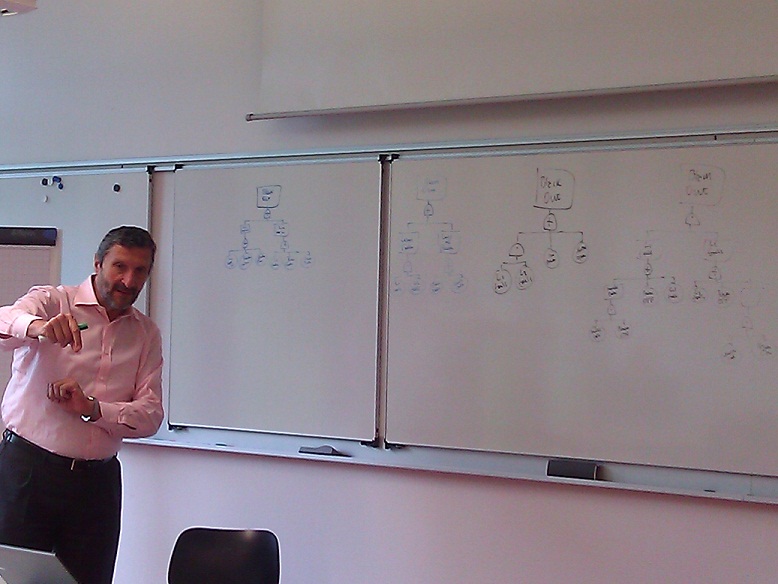
This course presented the current global and regional issues in petrochemical industries. During the course the participants learned about
- risk aspects and the methods for hazard identification applied in petrochemical industries,
- performing probability and consequences analysis and risk assessment, and
- health, safety and environment issues related to petrochemical industries.
Mr. Giovanni Uguccioni from D'Appolonia Spa (Italy) lectured 4 days, elaborating on current global and regional occurrences in the upstream, midstream, downstream and in petrochemical industries. The fifth day was spent by overviewing the course material and the students took an examination testing their acquired knowledge during the course.
|
|
|
|
|
|
|
31 Aug
2012 |
Register for ENISFER & reap the benefits of this network! |
 |
ENISFER is the European Network of Industrial Systems and Facilities for Exploration of Emerging Risks within the EU-VRi organization and tools. This network is in operation since the beginning of 2012, with large industrial companies and renown research organizations among its elite pool of partners. Hence, you are cordially invited to register yourself as an individual (Risk Expert) and/or your Organization/Company and/or Department/Facility and/or other entities. Click here to register for ENISFER now!
|
EU-VRI ENISFER
|
ENISFER is the European Network of Industrial Systems and Facilities for Exploration of Emerging Risks within the EU-VRi organization and tools.
The aim of ENISFER is to have a network of relevant and representative organizations/companies, departments/facilities or persons to continuously innovate and improve management of emerging risks. Therefore, this network will have a structuring effect for all the stakeholders concerned by technology related emerging risks at a regional, national, European or international scale (read more about ENISFER).
In view of the above, you are thus cordially invited to register:
- yourself as an individual (Risk Expert); and/or
- your Organization/Company; and/or
- your Department/Facility; and/or
- other entities.
Follow this link for ENISFER registration*: http://www.eu-vri.eu/fwlink/?LinkID=381
By means of this online registration, all (prospective) ENISFER partners will make available their contact and information to others who are looking for solutions to specific issues related to (emerging) risks. Furthermore, the benefits for joining this network are the ease of:
- finding experts in various areas of (emerging) risk management and engineering;
- finding companies/organizations and their research facilities relevant for your work;
- contacting other ENISFER partners for partnership opportunities.
* Please note that registration to ENISFER is not a membership and at this stage there are no obligations and/or financial contribution foreseen. In addition, the main benefits at this stage are as described above.
|
|
|
|
|
|
|
30 Jul
2012 |
Course on LCA |
 |
The course on Life Cycle Analysis and Assessment was successfully concluded in Stuttgart, Germany.
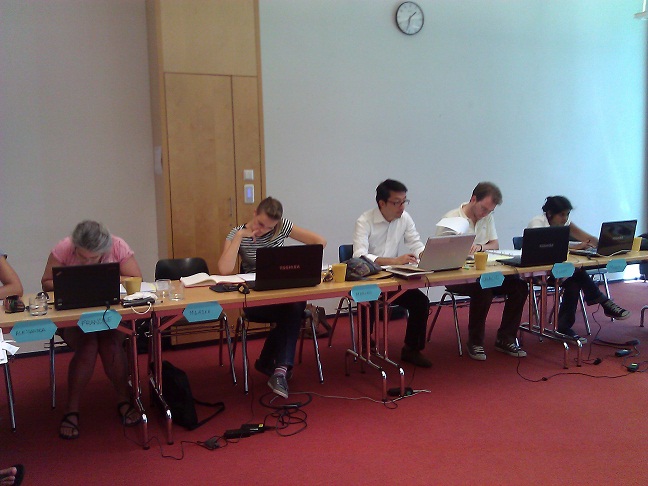
The course was open both for students of the universities participating in the project and for the external participants.
In the course the participants gained a comprehensive overview of the Life Cycle Assessment (LCA), Life Cycle Costing (LCC), International Reference Life Cycle Data System (ILCD) and European Reference Life Cycle Data System (ELCD).
The course is part of the European Master and Certification Program in Risk Engineering and Management, therefore as such, it enabled the participants to earn European ECTS credit points (see http://ec.europa.eu/education/lifelong-learning-policy/ects_en.htm).
|
Read more about the course! |
|
|
|
|
|
17 Jul
2012 |
iNTeg-Risk was presented at World Congress on Risk in Sydney |
 |
The European project iNTeg-Risk was presented at World Congress on Risk (WCR) in Sydney, Australia organized by Society for Risk Analysis (SRA).
|

at
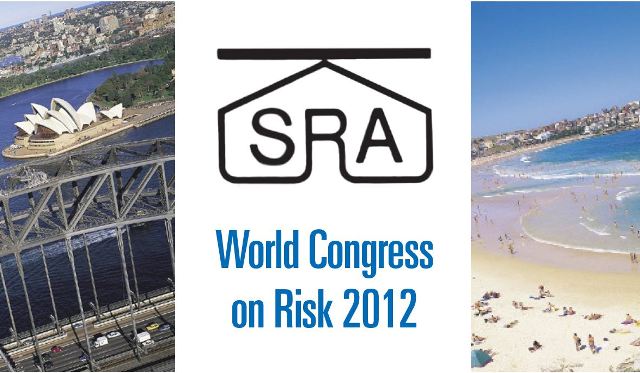
|
The coordinator of iNTeg-Risk project, Aleksandar (Sasa) Jovanovic, gave a presentation on iNTeg-Risk project at WCR in Sydney Australia. The presentation informed participants from all over the world about the main results achieved thus far before the project ends in May 2013. Furthermore, the presentation addresses follow-up initiatives, in particular, the "European Emerging Risk Radar (E2R2)" (click here for more information about E2R2).
Details of the SRA event:
World Congress on Risk (WCR)
Sydney Convention and Exhibition Centre
Sydney, Australia
July 18-20, 2012
The overall theme of the WCR 2012 was Risk and Development in a Changing World, and the three daily sub-themes were:
1. Disasters and Resilience;
2. Global and Emerging Risks; and
3. Risk and Sustainable Development.
Alternatively, visit the SRA WCR webpage at http://sra.org/worldcongress2012 for more information.
|
|
|
|
|
|
|
24 May
2012 |
Occupational Nanosafety Workshop |
 |
Tecnalia is pleased to announce the Workshop “MANAGING OCCUPATIONAL RISKS ASSOCIATED WITH NANOMATERIALS” taking place on 24th May 2012 at Euskalduna Conference Centre, Bilbao (Spain).
Managing occupational risks associated with nanomaterials
Tecnalia is pleased to announce the Workshop “MANAGING OCCUPATIONAL RISKS ASSOCIATED WITH NANOMATERIALS” taking place on 24th May 2012 at Euskalduna Conference Centre, Bilbao (Spain).

|
The Workshop is organised by TECNALIA and the University of the Basque Country in the framework of the 10th International Conference on Occupational Risk Prevention (ORP2012) and under the umbrella of the European Project SCAFFOLD.
The Workshop focuses on the industrial needs of companies
and aims to provide a practical overview of the results of current
research in the field of management of exposure to nanomaterials. The
ultimate objective of the Workshop is to provide companies a set of
skills that enable them - with the available evidence - proper management of the nano-risks.
The Workshop will include technical presentations
from very well known speakers from the different disciplines involved
in occupational nanosafety (USA, France, Finland, Spain); experiences in industry, a round table with involved stakeholders (Industry, Administration, Prevention Services, Research Organisations, Certification Bodies) and finally, a demonstration session to show equipments and devices for exposure measurement. Due to the international nature of the event, the language of the Workshop will be in English. There will be a simultaneous translation system to facilitate the participation of industry and other interested organizations.
The programme is available here.
For further information and registration, please use the following link:
http://www.tecnalia.com/en/divisions/industry-transport/industrial-systems/events/risks-associated-with-nanomaterials.htm
|
|
|
|
|
|
|
23 May
2012 |
OECD Workshop on Natech Risk Management, May 23-25, 2012 in Dresden (Germany) |
|
|
|
|
|
|
07 May
2012 |
Second event of Introduction to Risk Management |
 |
The second instance of the iNTeg-Risk course Introduction to Risk Management took place at the Stuttgart Institute of Management and Technology.
|
The course is part of the series of courses which all belong to joint effort of iNTeg-Risk project (represented by EU-VRi and other partners), University of Stuttgart (ZIRN) and Steinbeis University Berlin (STI Advanced Risk Technologies) to set a modern, modular and distributed model of education and certification in the area of Risk Engineering and Management with particular emphasis on the issue of emerging risks, in particular those related to new technologies.
The event took place on May 2-5, 2012 at the Stuttgart Institute of Management and Technology (SIMT). This specialist course was organized in conjunction with the 4th iNTeg-Risk Conference 2012.
Participants of the course had opportunity to extend their knowledge in the area of industrial safety, starting with different aspects of risks and terminology used in the field, with special focus on major accident prevention and related process safety risk assessment methodology. The participants came from different countries (Spain, Serbia, Germany, China, France, etc.) possessing different profiles (PhD, MSc and BSc students, professionals), thus allowing them to enjoy and profit from a real international environment during the course.
|
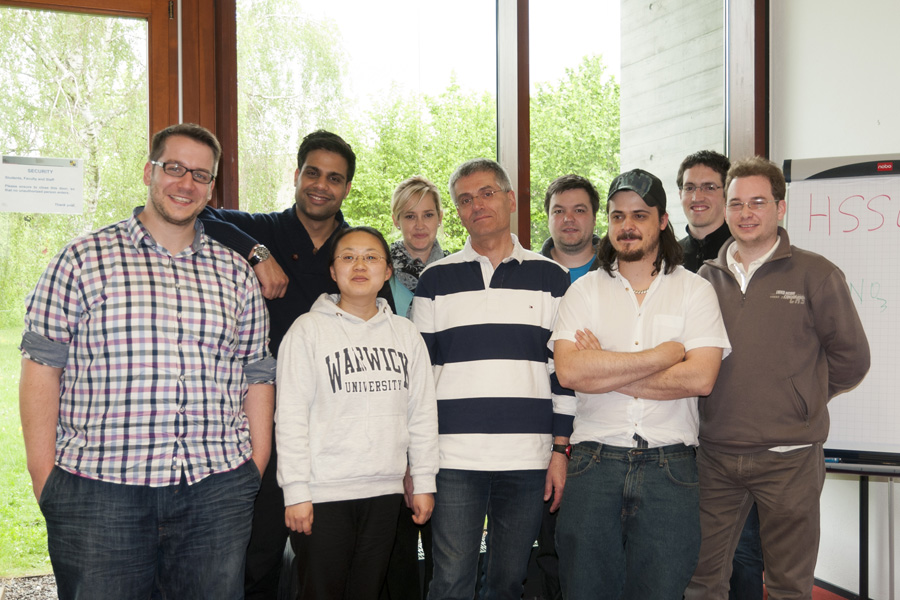
|
|
|
|
|
|
|
01 May
2012 |
2012 Edition of the Compendium |
 |
The 2012 edition of the Compendium of the NanoSafety Cluster is now available.

2012 edition of the Compendium
The 2012 edition of the Compendium is now available.
For several years now, the research community has responded by launching very valuable projects under the Sixth Framework Programme FP6 and Seventh Framework Programme FP7, marking significant technological progress both in the technology and in its safety management. About fifty projects are either completed or running and represent a total RTD investment of €137M, from the NMP and other programmes, under FP6 (13 projects, €31M) and FP7 (34 projects, €106M). These projects together with a significant number of projects supported by government resources in the EU member states and the FP7 associated states, and other projects addressing safety as side objective,represent the valuable efforts of the scientific and industrial research community for progress.
Please click on the link below to view the recently published European NanoSafety Cluster Compendium, which contains information on all running or recently completed projects funded under the Seventh Framework Programme FP7. Information on older projects can be found in the previous editions.
European NanoSafety Cluster Compendium 2012
The previous edition (2011) of the compendium is available here.
For further information on FP6 and FP7 programmes please click here. |
|
|
|
|
|
25 Apr
2012 |
IATA made positive comments on EU-VRi's economic modeling in the Alfa-Bird project |
 |
Following a successful meeting held on April 3, 2012 in Geneva, important observations and positive comments were received from the International Air Transport Association (IATA) regarding EU-VRi's economic modeling developed within the ALFA-BIRD project.
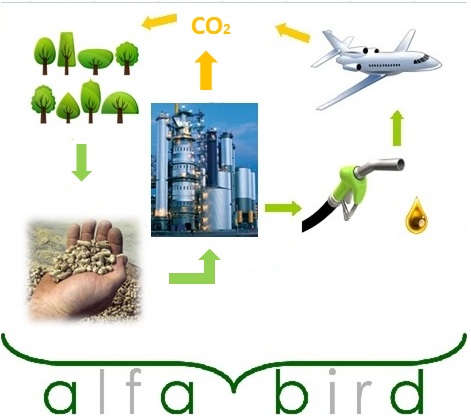
|
The EU-VRi team presented its economic model for the implementation of alternative fuel in the aviation sector to the International Air Transport Association (IATA) at a meeting held on April 3, 2012 in Geneva. Positive comments made by IATA during the presentation support the work developed and encourage further extension of the economic modeling within the ALFA-BIRD project.
“This model is flexible enough to include modules describing the behavior of relevant stakeholders. The team has the skills needed to create realistic models of relevant human behavior. The model development is still in progress and would need the inclusion of further modules, mainly for the description of other production pathways as well as different variants of incentivizing policy instruments. Also the inclusion of exogenous factors such as the influence of other industry sectors competing for resources would be needed. The current stage of development appears appropriate for a decision on such model enhancements, and IATA is happy to support this process further and also to provide relevant data.”
Thomas Rötger, Brian Pearce and Julie Perovic - IATA |
|
|
|
|
|
|
17 Apr
2012 |
StandarDays - Open info days on European standardization |
 |
In order to understand European Standardization and be able to use it, CEN and CENELEC are organizing the StandarDays on April 17-18, 2012, in Brussels.

StandarDays - Open info days on European standardization
CEN, the European Committee for Standardization, and CENELEC, the European Committee for Electrotechnical Standardization, are continuing their efforts to provide the public with the information they need in order to understand European Standardization, and be able to use it to their advantage.
'StandarDays' is a two day information session aimed at newcomers to European Standardization, as well as those who would like to understand CEN and CENELEC better. The info days give a clear and structured overview of the European Standardization System, of the CEN and CENELEC products and processes, as well as the benefits of involvement in European Standardization to potential stakeholders.
'StandarDays' will take place on 17 and 18 April 2012 at the CEN-CENELEC Meeting Centre, Avenue Marnix 17, B-1000 Brussels.
Format:
‘StandarDays’ consists of an introductory plenary meeting, which explains the different aspects and tasks of CEN and CENELEC (day 1) and interactive, in-depth workshops (day 2). This structure gives participants the opportunity to familiarize themselves with the overall European Standardization System (day 1) and then take advantage of the CEN and CENELEC expertise to obtain further clarification and explanations (day 2).
Programme
For whom?
‘StandarDays’ are aimed at all actors interested in the European Standardization System: industry, consumers, administrations and government, European institutions, research centres, national standards institutes, etc.
Participation:
Participation is free. Since there is a limited number of places, registrations will be accepted on a first come, first served basis and will close when the maximum number of participants is reached.
To participate in the ‘StandarDays’, please complete and return the registration form.
More information can be found on:
http://www.cencenelec.eu/news/events/Pages/StandarDaysApril2012.aspx
and
http://www.cen.eu/cen/News/Events/Pages/StandarDaysApril2012.aspx
and
http://www.cenelec.eu/pls/apex/f?p=104:300:725173836789168:::::
|
|
|
|
|
|
02 Apr
2012 |
RBI-PETRO was successfully concluded in Rotterdam |
 |
Risk Based Inspection - Petro was part of a course series organized through the joint effort of iNTeg-Risk project, University of Stuttgart and STI Advanced Risk Technologies.
 |
|
The iNTeg-Risk Course II-R4a "RBI-PETRO: Risk Based Inspection - Petro", which is part of the announced series of SHB/iNTeg-Risk courses, took place on March 27-30, 2012 in Rotterdam, the Netherlands.
During the 4-day course, 12 participants from Germany, Romania, China, Italy, Slovakia, the United Kingdom and Serbia had opportunity to learn more about Risk-Based Inspection (RBI) in general, its application in industry using different tools as well as to understand RBI technologies, procedures, and working processes in compliance with the main reference documents.
This series of courses is proudly organized through the joint effort of iNTeg-Risk project, University of Stuttgart (ZIRN) and Steinbeis University Berlin (STI Advanced Risk Technologies) to set a modern, modular and distributed model of education and certification in the area of Risk Engineering and Management with particular emphasis on the issue of emerging risks, especially those related to new technologies.
Furthermore, the course is a part of the European Master and Certification Program in Risk Engineering and Management.
|
|
|
|
|
|
|
23 Feb
2012 |
ESF-STOA Conference 'The Science of Innovation' was held on February 28, 2012 at the European Parliament, Brussels |
 |
The European Science Foundation (ESF) and the Science and Technology Options Assessment (STOA) office jointly organised a conference on 'The Science of Innovation', whereby it contributed to the debate on EU innovation policy at a crucial time by presenting a range of thought-provoking insights.
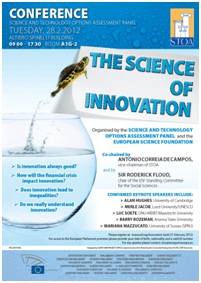 |
|
The Science of Innovation is an important, growing field of research and this ESF-STOA joint conference presented state-of-the-art insights from the cutting edge of 'the science of innovation' on crucial issues for today's policy makers.
Among other questions addressed were: Is innovation always good? How will the financial crisis impact innovation? Does innovation lead to inequalities? Do we really understand innovation?
Keynote speakers included:
- Alan Hughes, Professor of Enterprise Studies at the University of Cambridge, and Director of the Centre for Business Research (CBR)
- Merle Jacob, Professor in Research Policy at Lund University and UNESCO Chair in Research Management and Innovation Systems
- Luc Soete, Director of UNU-MERIT and Professor of International Economic Relations at Maastricht University
- Barry Bozeman, Professor of Public Policy at Arizona State University, Consortium for Science Policy and Outcomes
- Mariana Mazzucato, R.M. Phillips Professor of Science and Technology at the University of Sussex (SPRU)
For more information on the conference including brochure, programme, etc., click here.
|
|
|
|
|
|
|
16 Jan
2012 |
iNTeg-Risk in INERIS "Rapport Scientifique 2010/2011" |
 |
INERIS scientific report devoted attention to the results of iNTeg-Risk project. See more details in INERIS "Rapport Scientifique 2010/2011".
|
|
|
|
|
|
14 Jan
2012 |
Media coverage on World Economic Forum's "Global Risks Report 2012" |
 |
The World Economic Forum's (WEF) "Global Risks Report 2012" which was presented by the Wharton Risk Center, an academic partner of the WEF since 2005, has garnered significant media coverage. Click here to watch the video (WEF).
In the video which is produced by WEF, Erwann Michel-Kerjan, Managing Director of the Wharton Risk Center, examines the main findings of the Global Risks 2012 report and discusses its relevance to the private and public sectors. Click here to watch this video.
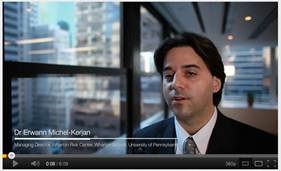
Other relevant media coverage can be accessed below:
- Pfanner, E. (January 11, 2012) Economic Troubles Cited As the Top Risks in 2012. The New York Times.
- Video: Howard Kunreuther, Co-Director of the Wharton Risk Center, addresses globalization and the results of interconnectedness in this interview for CBC Toronto. Click here to watch this video.

- Handley, M. (January 17, 2012) Top 5 Global Risks for 2012. U.S. News and World Reports.
- Video: Erwann Michel-Kerjan discusses some of the report’s findings with Erik Schatzker in Bloomberg Television's "Inside Track" on January 20, 2012. Click here to watch this video.
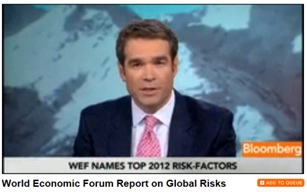
- Lu, K., & Michel-Kerjan, E. (January 21, 2012) Is Income Disparity Slowly Fueling the Next Global Crisis?. The Wall Street Journal (Asia).
|
|
|
|
|
|
14 Jan
2012 |
Global Risks Report 2012 - Wharton partnership with the World Economic Forum |
 |
The Wharton Risk Center, an academic partner of the World Economic Forum (WEF) since 2005, is pleased to present the WEF’s Global Risks Report 2012, Seventh Edition. Click here to download this report.
|
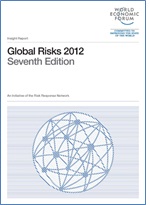
|
The WEF’s Global Risks Report 2012 has identified chronic fiscal imbalances and severe income disparity as the most prevalent risks over the next 10 years. These risks in tandem threaten global growth as they are drivers of nationalism, populism and protectionism at a time when the world remains vulnerable to systemic financial shocks, as well as possible food and water crises. These are the findings of a survey of 469 experts and industry leaders, indicating a shift of concern from environmental risks to socioeconomic risks, compared to a year ago.
Read more about the Global Risks Report here.
* For nearly three decades, the Wharton Risk Center has been at the forefront of basic and applied research in promoting effective corporate and public policies for low-probability events with potentially catastrophic consequences. Listed below are some of the media coverage on the Risk Center's research:
|
|
|
|
|
|
|
30 Dec
2011 |
Risk - we care! - New brochure of EU-VRi and Steinbeis Advanced Risk Technologies |
 |
EU-VRi and Steinbeis Advanced Risk Technologies have published a new brochure "Risk - we care®!" containing interesting information, events and projects about the past 10 years of R-Tech and the past 5 years of EU-VRi.
Link for download
 |
EU-VRi and Steinbeis Advanced Risk Technologies have published a new brochure "Risk - we care®!" containing interesting information, events and projects about the past 10 years of R-Tech and the past 5 years of EU-VRi.
For downloading the brochure please use the following link: http://www.eu-vri.eu/filehandler.ashx?file=9243
|
|
|
|
|
|
|
19 Dec
2011 |
CFS Audit closed |
 |
Audit reports for projects:
*NANODEVICE - Novel Concepts, Methods, and Technologies for the Production of Portable, Easy-to-Use Devices for the Measurement and Analysis of Airborne Engineered Nanoparticles in Workplace Air
* Alfa-Bird - Alternative Fuels and Biofuels for Aircraft Development
* iNTeg-Risk - Early Recognition, Monitoring and Integrated Management of Emerging, New Technology related Risks)
formally accepted and approved by the European Commission (with less than 0.05 % adjustment needed!).

|
Audit reports for projects
- NANODEVICE - Novel Concepts, Methods, and Technologies for the Production of Portable, Easy-to-Use Devices for the Measurement and Analysis of Airborne Engineered Nanoparticles in Workplace Air
- Alfa-Bird - Alternative Fuels and Biofuels for Aircraft Development
- iNTeg-Risk - Early Recognition, Monitoring and Integrated Management of Emerging, New Technology related Risks)
formally accepted and approved by the European Commission (with less than 0.05 % adjustment needed!) |
|
|
|
|
|
|
30 Nov
2011 |
Involvement of the EU-VRi/iNTeg-Risk partners into the first global survey of ISO 31000–Risk Management Principle and Guidelines |
 |
Following the approved liaison between ISO 31000 and EU-VRi/iNTeg-Risk (see news entry), a discussion between the iNTeg-Risk Project Coordinator and the CEO of EU-VRi, A. Jovanovic, and the Moderator of the LinkedIn ISO 31000 Risk Management Standard Group, A. Dali, took place. One of the main results, so far, would be the involvement of the EU-VRi/iNTeg-Risk partners into the first global survey of ISO 31000–Risk Management Principle and Guidelines set to kick off on the 17th of October this year.
Following the approved liaison between ISO 31000 and EU-VRi/iNTeg-Risk (see news entry), a discussion between the iNTeg-Risk Project Coordinator and the CEO of EU-VRi, A. Jovanovic, and the Moderator of the LinkedIn ISO 31000 Risk Management Standard Group, A. Dali, took place.
One of the main results, so far, would be the involvement of the EU-VRi/iNTeg-Risk partners into the first global survey of ISO 31000–Risk Management Principle and Guidelines set to kick off on the 17th of October this year. The aim of the survey is to gauge how ISO 31000 is perceived by risk practitioners across all sectors and to provide input for the preparation of the ISO 31004 guide, due out in 2013.
Members of more than 70 risk management associations around the world are invited to participate in the study which is being run through an initiative by the LinkedIn discussion group on ISO 31000. Issued in November 2009, ISO 31000 provides principles and generic guidelines on risk management. It can be used by any public, private or community enterprise, association, group or individual and is not specific to any industry or sector. "This is the first time the global risk management community active across all fields, sectors, industries and services is being invited to participate in an international survey on ISO 31000. It is a great opportunity to share your thoughts and concerns about the ISO standard on risk management" said Alex Dali.
The survey will run from
Oct. 17, 2011 to Nov. 30, 2011. (extended deadline)
You will be encouraged to participate through EU-VRi/iNTeg-Risk sites or the LinkedIn group. You can join the discussion forum preparing the survey at: http://www.linkedin.com/groups?mostPopular=&gid=1834592.
We encourage your participation and will gladly support it. |
|
|
|
|
|
27 Nov
2011 |
Interim report on SafeChina project accepted |
 |
(excerpt from the e-mail of the project officer)
Dear R-Tech PPP-China-Project-Team,
(...)
The interim report is excellent. It is very well structured, contains all necessary information and nicely sum up all relevant activities / findings or the project up to today.
|
(excerpt from the e-mail of the project officer)
Dear R-Tech PPP-China-Project-Team,
(...) The interim report is excellent. It is very well structured, contains all necessary information and nicely sum up all relevant activities / findings or the project up to today. (...)
For me, the interim report shows that the project now is on a very good way and it looks like you are on a good way to surpass the overall number of participants. It is very good to see that we have already 138 participants successfully passing a final examination. (...)
In any case, i can already confirm the acceptance of the interim report which also contains all necessary documentation to "approve" the achievement of the relevant indicators. Supplemented by the excellent data bases in the internet the project process is perfectly documented. (...)
Thank you very much for the really good work! (...)
Best regards from Cologne
Volker Schwab,
DEG - Special Programs - Cologne
|
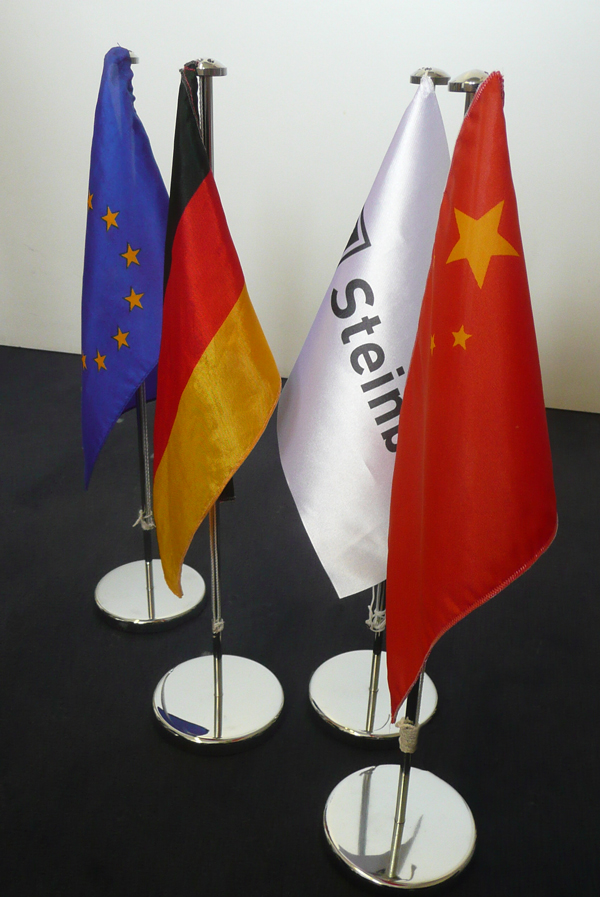
|
|
|
|
|
|
|
18 Oct
2011 |
EUROPEAN COMMISSION - PRESS RELEASE - What is a nanomaterial? |
 |
What is a nanomaterial? European Commission brings a common definition of a nanomaterial, the definition will be now applied in all EU-VRi/R-tech projects dealing with nanotechnology (iNTeg-Risk, MUST, PARTICOAT, Nanodevice…)
 |
EUROPEAN COMMISSION - PRESS RELEASE
What is a "nanomaterial"? European Commission breaks new ground with a common definition
Brussels, 18 October 2011 – "Nanomaterials" are materials whose main constituents have a dimension of between 1 and 100 billionth of a metre, according to a recommendation adopted by the European Commission today. The announcement marks an important step towards greater protection for citizens, clearly defining which materials need special treatment in specific legislation.
European Environment Commissioner Janez Potočnik said: "I am happy to say that the EU is the first to come forward with a cross-cutting designation of nanomaterials to be used for all regulatory purposes. We have come up with a solid definition based on scientific input and a broad consultation. Industry needs a clear coherent regulatory framework in this important economic sector, and consumers deserve accurate information about these substances. It is an important step towards addressing any possible risks for the environment and human health, while ensuring that this new technology can live up to its potential."
Nanomaterials are already being used in hundreds of applications and consumer products ranging from toothpaste to batteries, paints and clothing. Developing these innovative substances is an important driver for European competitiveness, and they have significant potential for progress in areas like medicine, environmental protection and energy efficiency. But as uncertainties remain about the risks they pose, a clear definition is needed to ensure that the appropriate chemical safety rules apply. The definition will help all stakeholders including industry associations, as it brings coherence to the variety of definitions that are currently in use in different sectors. The definition will be reviewed in 2014 in the light of technical and scientific progress.
The recommendation also delivers on a commitment made in 2009 to the European Parliament to issue a single definition that is broadly applicable to all EU legislation concerned by nanomaterials.
The definition adopted today is based on an approach considering the size of the constituent particles of a material, rather than hazard or risk. The wording describes a nanomaterial as "a natural, incidental or manufactured material containing particles, in an unbound state or as an aggregate or as an agglomerate and where, for 50% or more of the particles in the number size distribution, one or more external dimensions is in the size range 1 nm – 100 nm."
The definition is based on scientific advice from the Scientific Committee on Emerging and Newly Identified Health Risks (SCENIHR) and the Joint Research Centre (JRC). A draft version of the definition was subject to a public consultation.
Background
Nanomaterials are currently governed by a variety of legislative instruments at EU and national level. However, definitions have been developed on a case-by-case basis and vary across sectors, creating unnecessary burdens for industry and hampering public debate about risks and benefits of these substances. This recommendation gives EU legislators a legal reference for nanomaterials, when adopting new or implementing existing legislation.
The experience of the first registration deadline (30 November 2010) under REACH, the EU's overarching chemicals policy, showed that companies needed more clarity about their obligations with regard to nanomaterials. REACH has a key role to play in generating information about the properties of nanomaterials as chemical substances. With the adopted definition it will be easier for companies to assess their registration dossiers and determine exactly when they should consider their products as nanomaterials.
Further information:
http://ec.europa.eu/environment/chemicals/nanotech/index.htm
MEMO/11/704
|
|
|
|
|
|
|
23 Sep
2011 |
ISO confirmed the liaison between ISO/PC 262 and EU-VRi |
 |
We are proud to inform that the International Organization for Standardization (ISO) has officially confirmed the liaison between ISO/PC 262 (Project Committee: Risk Management) and EU-VRi.
TC 262 - Project committee: Risk management
|
The International Organization for Standardization (ISO) has officially confirmed the liaison between ISO/PC 262 (Project Committee: Risk Management) and EU-VRi. The ISO/PC 262 members, comprising 31 participating countries and 6 observing countries, have kindly accepted the liaison application of EU-VRi.
EU-VRi and its members are looking forward to a fruitful collaboration and exchange on standardization activities in the field of ISO 31000 family of standards, and ISO 31004 in particular.
Find out more about ISO/PC 262 by following this link. |
|
|
|
|
|
|
19 Sep
2011 |
Workshop “Total Safety Management for Industrial Organisations” |
 |
The last call for proposals for the Cooperation NMP Programme of FP7 has been published on July 20, 2011. It includes the topic “NMP.2012.3.0-2 Total Safety Management for industrial organizations” promoted by ETPIS. To prepare the call, a workshop and brokerage event has been organized on September 19, 2011 in Brussels.
Workshop “Total Safety Management for Industrial Organisations”
The last call for proposals for the Cooperation NMP Programme of FP7 has been published on July 20, 2011. It includes the topic “NMP.2012.3.0-2 Total Safety Management for industrial organizations” promoted by ETPIS.
The call text is now available at:
http://ec.europa.eu/research/participants/portal/page/cooperation#nmp
You can find more information about the call context by visiting the homepage of the Industrial Technologies Unit: http://ec.europa.eu/research/industrial_technologies/index_en.cfm
To facilitate the development of relevant projects, ETPIS has organized a workshop and a brokerage event on September 19, 2011 in Brussels.
In the morning the call “NMP.2012.3.0-2 Total Safety Management for industrial organizations” has been presented by the project officer in charge of the call. Then, results from recent projects and initiatives provided an overview of the remaining challenges in the field of Human and organizational factors in industrial safety.
In the afternoon, a brokerage event was organized in two parts. First, consortia and project initiators have had the opportunity to present their ideas, get a feedback and find possible additional partners. Then, partners interested by the call had the possibility to present their profile.
Agenda, link
Note that the draft agenda includes a list of potential partners describing their profiles and offering participation in a project (access reserved to ETPIS members).
|
|
|
|
|
|
01 Sep
2011 |
New CEN Workshop announced at CEN websites |
 |
The CEN workshop "General Framework and Guidelines for Early Recognition, Monitoring and Integrated Management of Emerging New Technology Related Risks (iNTeg-Risk)" (WS 67) has been announced on CEN websites (see CEN website here).
 |
We are pleased to inform you that the CEN workshop "General Framework and Guidelines for Early Recognition, Monitoring and Integrated Management of Emerging New Technology Related Risks (iNTeg-Risk)" (WS 67) has been announced on CEN websites (see CEN website here).
We would like to thank all persons involved in WP4.9, which is dedicated to the development of CWAs in iNTeg-Risk project, for their valuable contributions and we are looking forward to creating interesting and useful pre-standadization documents under the umbrella of this workshop by taking into account the results of iNTeg-Risk project.
The draft Business plan
The draft Business Plan for the new CEN Workshop is available via the link above.
Kick-Off Meeting
The Kick-Off Meeting of the workshop will take place in Brussels on Friday, 4 November 2011 at CEN-CENELEC Meeting Centre, Avenue Marnix 17, 1000 Brussels (see Project Calendar).
Secretariat
DIN has volunteered to provide the secretariat.
Chairmanship
A Chairman and two Vice-Chairmen have been nominated for the Workshop (CVs are as well available on CEN website). Their appointment will be confirmed at the Kick-Off Meeting.
For any question regarding the workshop, do not hesitate to contact integrisk@eu-vri.eu. |
|
|
|
|
|
|
09 Aug
2011 |
Important event at Beijing Normal University |
 |
Prof. Ortwin Renn, president of the EU-VRi (European Virtual Institute for Integrated Risk Management), participated to an very important event which took place at the Beijing Normal University in the period August 01 - 12, 2011
2011 Summer Institute for Advanced Study of Disaster and Risk,
Disaster, Risk, and Integrated Governance
Prof. Ortwin Renn, president of the EU-VRi (European Virtual Institute for Integrated Risk Management), has participatedto an very important event which took place at the Beijing Normal University in the period August 01 - 12, 2011
2011 Summer Institute for Advanced Study of Disaster and Risk,
Disaster, Risk, and Integrated Governance
(http://www.espre.cn/111/newsview.asp?id=6)
The 2011 Summer Institute is the third of the summer institute series, organized by the State Key Laboratory of Earth Surface Processes and Resource Ecology at Beijing Normal University, the Academy of Disaster Reduction and Emergency Management of the Ministry of Civil Affairs and the Ministry of Education, and the Key Laboratory of Environmental Change and Natural Disaster of the Ministry of Education of China.
|
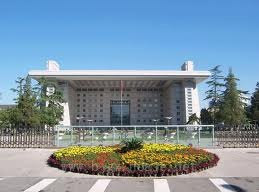
|
The Summer Institute series is implemented in collaboration between the 111 Project/HRSB at Beijing Normal University and the IHDP/IRG-Project. Starting summer 2009, three consecutive summer institutes are to be organized (2009-2011), covering a different thematic focus each year in addition to the essentials in the filed of hazard and risk study. The primary goal is to attract and train young scholars who have both background and strong interest in the field of hazard and risk study, and through which, to improve and strengthen education, research, as well as international communication and cooperation capacity in China in the field of disaster and risk sciences. In the long-term, the summer institutes seek contribution to laying a solid foundation for a state-of-the-art hazard and risk science base in China.
Core faculties Invited
-
David Alexander, University of Florence, Italia
-
Carlo Jaeger, Potsdam Institute for Climate Impact Research, German
-
Roger Kasperson, Clark University, USA
-
Nick Pigeon, Cardiff University, UK
-
Otwin Renn, University of Stuttgart, Germany
-
Peijun Shi, Beijing Normal University, China
|
|
|
|
|
|
20 Jul
2011 |
European Commission launches the call for proposals in the thematic priority NMP of FP7 |
 |
EC has launched the current call for proposals under the 2011 and 2012 Cooperation work programme of Seventh Framework Programme (FP7) for Research, Technological Development and Demonstration Activities (2007 to 2013) and amongst them is the Work Programme 2012 - Theme 4: Nanosciences, Nanotechnologies, Materials and new Production Technologies (NMP). Download the relevant published paper here.
 |
With the unveiling of multiple calls for proposals for all FP7 programmes, this new call invites applicants to present their interesting proposals.
All current call publications as well as related information can be found here. |
|
|
|
|
|
|
14 Jul
2011 |
Extensive media coverage on the report of OECD's "Future Global Shocks" (FGS) project |
 |
Extensive coverage in the international press was given to the report of OECD's FGS project which has come to a fruitful conclusion as the organisation presented the project findings on June 27, 2011.
Click here to watch the news broadcast (Reuters).
 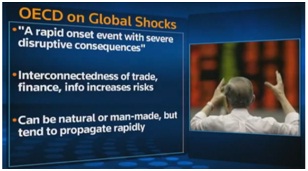
Source: Reuters news broadcast
|
List of FGS media coverage
- Dolan, M., & Pitchford, R. (2011, June 29) Analysis: Serial shocks forcing world to "think long". Thomson Reuters.
- OECD says globalisation increases risks. (2011, June 27) Agence France Presse/ Yahoo! Inc.
- Yang, L. (2011, June 27) OECD predicts more frequent shocks to world economy. Xinhua News Agency.
- Para la OCDE, la economía mundial sufrirá crisis más frecuentes y graves. (2011, June 27) (iEco) Clarín.com.
- Recomienda OCDE anticiparse a mayores efectos de impactos globales. (2011, June 27) Notimex/ SDPnoticias.com.
- Les 5 menaces qui planent sur l’économie mondiale. (2011, June 27) Trends.be.
- L'OCDE pointe les menaces qui planent sur l'économie mondiale. (2011, June 27) LaTribune.fr.
- O'Grady, S. (2011, June 28) World economy set to face more frequent shocks. independent.co.uk.
- Foucart, F. (2011, July 1) L’OCDE met en garde contre les effets d’une éruption solaire sur l’économie. Le Monde.
- Aldrick, P. (2011, June 28) Risk of global 'shocks' has increased, says OECD. Telegraph Media Group Limited.
- Gefahr globaler Schocks wird zunehmen. (2011, June 28) Lëtzebuerger Journal S.A.
- Jackson, G. (2011, June 27) Crises likely to get more frequent, OECD says. Fundweb/ Centaur Media Plc.
- "Le monde va connaître des chocs plus fréquents !", selon l'OCDE. (2011, June 27) Boursier.com.
- Mitchell, R. (2011, June 28) OECD Says Preparation Needed Ahead of Coming Shocks to Global Economy. Daily Report for Executives.
|
|
|
|
|
|
|
14 Jul
2011 |
EU-VRi, together with University of Stuttgart (ZIRN) and Steinbeis R-Tech, made exemplary contribution to the OECD project “Future Global Shocks” (FGS) |
 |
OECD's FGS project came to a fruitful conclusion whereby EU-VRi, together with University of Stuttgart (ZIRN) and Steinbeis R-Tech, contributed notably to the project with their work on one of the selected case studies (Social Unrest). Click to download FGS project report: 1. Executive Summary; or 2. Full report (preliminary version).
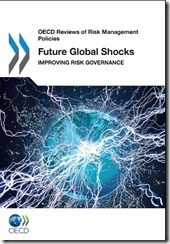 |
|
OECD proudly presented the findings of its two-year "Future Global Shocks" (FGS) project on June 27, 2011.
While discussing a wide range of future shock scenarios, much of the project's focus was set on five highly disruptive future shock events, namely:
- Systemic Financial Risk;
- Pandemics;
- Cyber Risks;
- Geomagnetic Storms; and
- Social Unrest.
Steinbeis will also be publishing the reports of these five case studies. |
|
|
|
|
|
|
21 Jun
2011 |
Horizon 2020 - the Framework Programme for Research and Innovation |
 |
Máire Geoghegan-Quinn, European Commissioner for Research, Innovation and Science, has announced the new name of the future EU funding programme for research and innovation: "Horizon 2020 - the Framework Programme for Research and Innovation", which will enter into force on 1 January 2014, after the end of FP7 on 31 Dec 2013. Click here to read this statement.
 |
|
The new name, "Horizon 2020 - the Framework Programme for Research and Innovation", is an important symbol of a new departure and a new adventure whereby the cutting-edge, integrated funding system will cover all research and innovation funding currently provided through the Framework Programme for Research and Technical Development, the Competitiveness and Innovation Framework Programme (CIP) as well as the European Institute of Innovation and Technology (EIT). With this system, redundant red tape will be eliminated and access to the programs as well as participation will be made easier and simpler.
Moreover, in an effort to further boost excellence as well as ensure that good ideas reach the market and generate sustainable economic growth and new jobs, the different types of the aforementioned funding will be brought together in a coherent and flexible manner so as to support researchers and innovators in Europe. These research and innovation funding will focus clearly on addressing global challenges. |
|
|
|
|
|
|
15 Jun
2011 |
3rd iNTeg-Risk Conference 2011 - Presentations available! |
 |
The 3rd iNTeg-Risk Conference 2011 took place in Stuttgart, Germany on June 6-10, 2011, in conjunction with the SRA-Europe 2011 Annual Meeting. The presentations are available for download. Further information have been sent to all participants via e-mail.
 |
Early Recognition, Monitoring and Integrated Management
of Emerging, New Technology Related, Risks
www.integrisk.eu-vri.eu |
3rd iNTeg-Risk Conference 2011
"Risk vs. Risk: Managing Emerging Risk-Benefit Tradeoffs in Complex Systems"
took place in
Stuttgart, Germany on June 6-10, 2011
in conjunction with
SRA-Europe 2011 Annual Meeting (June 5-8, 2011) www.sraeurope.org,
iNTeg-Risk workshops/courses and iNTeg-Risk ES Seminar

|
Venue:
Haus der Wirtschaft
Willi-Bleicher-Strasse 19
70174 Stuttgart, Germany
http://www.hausderwirtschaft.de
(25 mins by metro to the airport,
10 mins walk to the main railway station) |
The conference was an excellent opportunity for project partners to communicate their results to the “outside world” and an opportunity for interested professionals, not participating in the iNTeg-Risk project, to learn about the project (www.integrisk.eu-vri.eu, budget approx. 20 million €, 80+ companies involved).
The detailed program can be seen following the link.
The presentations are available for download. Further information have been sent to all participants via e-mail.
|
|
|
|
|
|
12 Apr
2011 |
Steinbeis Engineering Forum |
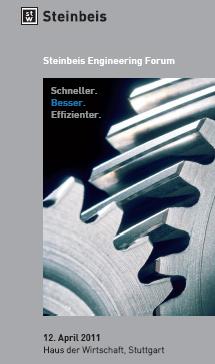 |
Steinbeis Engineering Forum took place on April 12, 2011 in Haus der Wirtschaft, Stuttgart.
Dipl.-Ing. Theo Hack (EADS) and Prof. Aleksandar Jovanovic (Steinbeis R-Tech) gave a speech with the title:
Produktrisiko - Sicherheit und Nachhaltigkeit von Neuen Technologien
Beispiel: Automobil- und Flugzeugtechnik
Further information can be found on the flyer and the website.
 |
Steinbeis Engineering Forum took place on April 12, 2011 in Haus der Wirtschaft, Stuttgart.
Dipl.-Ing. Theo Hack (EADS) and Prof. Aleksandar Jovanovic (Steinbeis R-Tech) gave a speech with the title:
Produktrisiko - Sicherheit und Nachhaltigkeit von Neuen Technologien
Beispiel: Automobil- und Flugzeugtechnik
The complete program and further information about the event can be found on the
flyer and the website. |
|
|
|
|
|
|
21 Mar
2011 |
Steinbeis EnvironNIS project finished – the results praised as "one of the best and the most comprehensive studies, ever performed in Serbia" |
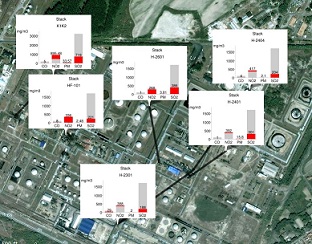 |
Steinbeis Advanced Risk Technologies GmbH and D’Appolonia S.p.A have finished the project Complex ecological examination of Naftna industrija Srbije (NIS) production facilities (EnvironNIS), whereby assessment done in 2010 had covered main environmental issues (air, soil, groundwater and waste water) on 12 selected facilities. The project results were presented at a press conference on March 17, 2011 and according to the words of Minister of Environment, Mining and Spatial Planning, Oliver Dulić, EnvironNIS is "one of the best and the most comprehensive studies, ever performed in Serbia".
Steinbeis Advanced Risk Technologies GmbH and D’Appolonia S.p.A have finished the project Complex ecological examination of Naftna industrija Srbije (NIS) production facilities (EnvironNIS) and submitted the final reports. This comprehensive study was undertaken in 2010 as defined by the Agreement on purchase and sale of NIS shares and in accordance with the Technical assignment approved by Serbian ministries in charge.
|
Final reports were submitted in two languages (English and Serbian) for each of the facility, what makes 24 reports with about 2500 pages. The reports contain description of actual environmental status (soil, groundwater, waste water and air), evaluation of EHS management, as well as assessment of potential environmental risks and proposals for corrective measures.
30+ experts from Steinbeis Advanced Risk Technologies GmbH and D'Appolonia were participating in assessment and reporting work.
|

|
The results of the study were presented at the press conference that took place on March 17, 2011 in the Serbian government’s press room, Nemanjina 11 in Belgrade. Minister of Environment, Mining and Spatial Planning, Oliver Dulić, CEO of Naftna industrija Srbije (NIS) Kirill Kravchenko and the head of the NIS Directorate for Industrial and Environmental Safety, Occupational Safety and Health Stanislav Dedovec pointed out the importance of this study and answered a number of questions.
According to the Minister Dulic's words EnvironNIS project is "one of the best and the most comprehensive studies, ever performed in Serbia".
NIS has already invested 90 million € in environmental projects (60 million € financed by Gazprom Neft) but, based on the results and proposals of the EnvironNIS study, 9.6 million € will be additionally invested.
|
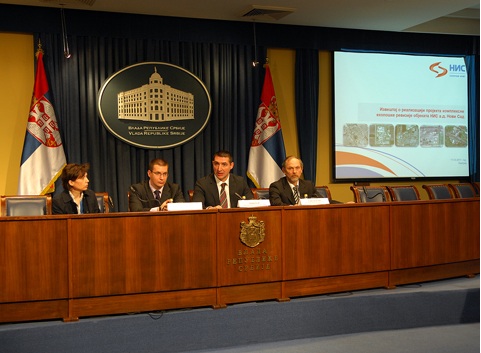 |
|
|
|
|
|
|
13 Mar
2011 |
Japanese multiple catastrophe |
 |
EU-VRi President, Prof. O. Renn, speaks at German television about the Japanese multiple catastrophe (earthquake, tsunami, nuclear accidents). Need to understand the concept of societal/political decision about "the acceptable remaining risk", relationship between alternatives (multiple risks and risk-risk tradeoffs!), inclusion of time into the considerations... Just as the disaster itself, the debate show that the topics dealt/tackled by the EU-VRi and its members (Steinbeis R-Tech, INERIS, Univ. of Stuttgart ZIRN, ... ) , and in particular iNTeg-Risk project (e.g. NaTech – Nature-technology risks) and this year's iNTeg-Risk Conference (Multiple risks, risk-risk-tradeoffs...) timely and important are.
The whole broadcast is to be seen using the link.
 |
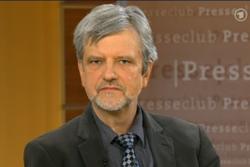
|
EU-VRi President, Prof. O. Renn, speaks at German television about the Japanese multiple catastrophe (earthquake, tsunami, nuclear accidents). Need to understand the concept of societal/political decision about "the acceptable remaining risk", relationship between alternatives (multiple risks and risk-risk tradeoffs!), inclusion of time into the considerations... Just as the disaster itself, the debate show that the topics dealt/tackled by the EU-VRi and its members (Steinbeis R-Tech, INERIS, Univ. of Stuttgart ZIRN, ... ) , and in particular iNTeg-Risk project (e.g. NaTech – Nature-technology risks) and this year's iNTeg-Risk Conference (Multiple risks, risk-risk-tradeoffs...) timely and important are.
The whole broadcast is to be seen using the
link.
|
|
|
|
|
|
|
28 Jan
2011 |
Announcement of the 7th General Assembly and the regular EU-VRi technical workshop on 7-8 April 2011, in Budapest |
 |
The EU-VRi 7th General Assembly (GA) and related meetings took place on April 7-8, 2011 at Danubius Health Spa Resort Helia, Budapest
EU-VRi 7th General Assembly (GA)
and related meetings
will took on
April 7 - 8, 2011
at
Danubius Health Spa Resort Helia
Kárpát utca 62-64.
1133 Budapest
Hungary
There were3 main events taking place, namely:
- EU-VRi Technical Workshop (to exchange information and launch new projects) – April 7, 2011 in the afternoon, followed by a dinner:
- The newly adopted Seveso III Directive
- The preparation of the next FP7 calls for proposals (to be published in July 2011)
- General Assembly EU-VRi Founding Members
April 7, 2011, 17:30 - 19:00 (Part I): dedicated to the review of the previous year
April 8, 2011, 09:00 – 9:45 (Part II): dedicated to the future orientations (strategic discussions)
- General Assembly EU-VRi All Members – April 8, 2011 (from 10:00 to 15:30)
For further details can be found on the Draft Agenda.
|
|
|
|
|
|
26 Jan
2011 |
IRGC has published the report ‘The Emergence of Risks: Contributing Factors’ |
 |
The publication of this report marks the conclusion of the first phase of IRGC’s ongoing project on emerging risks. With this report, IRGC aims to raise awareness among professionals about the fact that risks emerge from a common ‘fertile ground’ cultivated by twelve generic factors which are described and illustrated in detail within the report. Click here to download this report.
IRGC and Emerging Risks
The International Risk Governance Council ( IRGC) is an independent foundation, which aims to improve the understanding and management of global risks that impact on human health and safety, the environment, the economy and society at large.
The project on emerging risks is part of IRGC’s work on core concepts of risk governance, and follows on from its work on risk governance deficits. IRGC defines as “emerging” a risk that is new, or a familiar risk in a new or unfamiliar context or under new context conditions (re-emerging). Emerging risks are issues that are perceived to be potentially significant but which may not be fully understood and assessed, thus not allowing risk management options to be developed with confidence.
 |
The Emerging Risks Report
The publication of this report marks the conclusion of the first phase of IRGC’s ongoing project on emerging risks. The objective of this first phase was to focus on the origins of emerging risks. With this report, IRGC aims to raise awareness among professionals about the fact that risks emerge from a common ‘fertile ground’ that is cultivated by twelve generic factors. The report describes and illustrates these twelve factors, which have the potential to amplify or attenuate the likelihood of a new risk emerging or the severity of its consequences. Some of these factors may provide ripe targets for risk management measures.
Phase 2 of the emerging risks project, currently underway, will explore the major obstacles that risk practitioners must overcome in order to improve their own capabilities for understanding, anticipating and responding to emerging risks. IRGC is working towards developing practical guidance for both the public and private sectors on how such obstacles can be overcome.
For downloading the report please use the following link: http://irgc.org/IMG/pdf/irgc_ER_final_07jan_web.pdf
|
|
|
|
|
|
|
17 Dec
2010 |
EU-VRi Official Partner of the Healthy Workplaces Campaign |
 |
EU-VRi has received the certificate as an Official Partner of the Healthy Workplaces Campaign 2010-2011, which is co-ordinated by the European Agency for Safety and Health at Work and its partners in the 27 EU Member States, supports a wide range of activities at the national and European level that promote safe maintenance. It will highlight the importance of maintenance (of plants, equipment, machines and workplaces) to eliminate workplace hazards, and to provide safer and healthier working conditions in workplaces throughout Europe. It is backed by the EU Presidencies of Spain and Belgium in 2010 and of Hungary and Poland in 2011, by the European Parliament and the European Commission, and by the European Social Partners.

|
EU-VRi has received the certificate as an Official Partner of the Healthy Workplaces Campaign 2010-2011, which is co-ordinated by the European Agency for Safety and Health at Work and its partners in the 27 EU Member States, supports a wide range of activities at the national and European level that promote safe maintenance. It will highlight the importance of maintenance (of plants, equipment, machines and workplaces) to eliminate workplace hazards, and to provide safer and healthier working conditions in workplaces throughout Europe. It is backed by the EU Presidencies of Spain and Belgium in 2010 and of Hungary and Poland in 2011, by the European Parliament and the European Commission, and by the European Social Partners.
|
|
|
|
|
|
|
28 Oct
2010 |
Workshop on Biogas - Safety & Regulations |
 |
Workshop on Biogas - Safety & Regulations, on November 24th, 2010 in Paris
 |
Workshop
Biogas - Safety and Regulations
November 24, 2010, Paris, France
|
 |
A workshop on the Production of Biogas - Safety & Regulations is organised by INERIS and EU-VRi on November 24th, 2010 in Paris.
The overall objective of the workshop is to bring together the European experts in biogas production to define the best practices that will support the quick and safe development of this new energy.
Practically, the operational objectives that the workshop will fulfill are:
- Share information, in particular on projects, processes but also on safety and regulation in order to identify the state of the art in these fields across Europe.
- Find and understand the gaps in terms of safety and regulation.
- Propose solutions to fill those gaps and possibly prepare the base of a permanent network on safety aspects.
The draft agenda of the workshop is available here and the main document for the discussion of the workshop is here.
The conditions for registration are available in the agenda.
The deadline for the registration is: November 12, 2010
|
IMPORTANT NOTES:
1. REGISTRATION IS MANDATORY BEFORE NOVEMBER 12,2010:
Web-registration is available at:
http://www.eu-vri.eu/Events/default.aspx?EventID=2651®=1
2. PARTICIPATION FEES:
· 195.- € fee is foreseen for the coverage of costs related to the venue, catering and the organisation of the workshop.
· 145.- € - Specific discount for ATEE members, EBA members, EU-VRi and ETPIS members. Specify your membership when registering in the “comments” field.
Payment is accepted:
- at the registration desk in cash
- via bank transfer before November 17, 2010 (a proof of the bank transfer will be required if the payment has not been received before the event).
Bank details:
Bank: Deutsche Bank, Germany, Branch 240
BLZ 600 700 70
BIC/SWIFT-Code: DEUTDESS
Account-Nr. 1301548
IBAN: DE22 600 700 700 130 154800
VAT Nr: UID DE 253148518
Legal registration Nr.: HRA 720578
|
If you need more information, please contact delsinne@eu-vri.eu .
Partners of the event:
|
|
|
|
|
|
13 Oct
2010 |
ESIG Award Winner Event in Nurmberg |
 |
The ESIG Award Winner Event was held in Nuremberg on 13 October, 2010. Prof. Jovanovic was invited as one of ETPIS´ senior representatives to give a keynote speech on this occasion.

|
The ESIG Product Stewardship Award is launched every two years and recognizes companies - especially SMEs - which show outstanding health, safety and environmental improvements in the handling, storage, use or transportation of solvents. In 2009 the winner was 120 people, family-owned distributor CSC Jaeklechemie, based in Nuremberg/Southern Germany. The corresponding local event was held in Nuremberg on 13 October, 2010. Prof. Jovanovic was invited as one of ETPIS´ senior representatives to give a keynote speech on this occasion.
For downloading the whole article in the ESIG Newsletter please use the Link.
|
|
|
|
|
|
|
30 Jun
2010 |
EU-VRi Annual Report 2009 |
 |
The EU-VRi Annual Report 2009 is now available
|
|
|
|
|
|
30 Jun
2010 |
EU-VRi is now a partner of the HWC 2010-2011 |
 |
EU-VRi has become a partner of the Healthy Workplaces Campaign 2010-2011 on Safe Maintenance, which is organised by EU-OSHA.
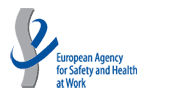 |
EU-VRi: partner of the Healthy Workplaces Campaign 2010-2011
|
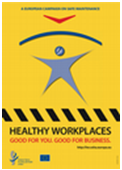 |
The main theme of the campaign, which is organised by the European Agency for Safety and Health at Work (EU-OSHA), is the Safe Maintenance.
EU-VRi has fill in the registration in order to a partner and recently the application has been accepted. --> the letter
EU-VRi will be working closely together to promote their common goal that is to keep workplaces functioning safely and efficiently.
The Campaign was officially launched on 28 April 2010 by László Andor, EU Commissioner for Employment, Social Affairs and Inclusion.
The main actions of the campaign are:
- events organised around the theme of safe maintenance, especially during the annual European Week for Safety and Health at Work in October 2010 and 2011,
- dissemination of information sheets, DVDs and other pieces of Campaign material.
Soon, you will see on the website of EU-OSHA, the profile of EU-VRi as a partner.
More information:
--> The Healthy Workplaces Campaign 2010-2011 (HWC 2010-2011)
--> The European Agency for Safety and Health at Work (EU-OSHA)
|
|
|
|
|
|
28 Jun
2010 |
Job Vacancy |
 |
Steinbeis Advanced Risk Technologies and EU-VRi are looking for skilled and motivated professionals for EU and industrial projects in the area of Risk Engineering and Management.
Steinbeis Advanced Risk Technologies
(www.risk-technologies.eu)
Stuttgart, Germany
and

European Virtual Institute for Integrated Risk Management
(www.eu-vri.eu)
Stuttgart, Germany

JOB VACANCY
Steinbeis Advanced Risk Technologies and EU-VRi are looking for skilled and motivated professionals for EU and industrial projects in the area of
Risk Engineering and Management
dealing with:
- integrated risk management, see project iNTeg-Risk (www.integrisk.eu-vri.eu)
- impacts of new bio-fuels in industry, see project Alfa-Bird (www.alfa-bird.eu-vri.eu)
- life cycle analysis and use of nanotechnologies, see projects MUST (www.must.risk-technologies.com), PARTICOAT (www.particoat.eu), and others
- risk management in industry (RBI, RCM, HAZOP, HSE...) and
- applications of the EU directives like SEVESO, REACH, Solvency, INSPIRE...
The applicants' profiles to be considered are:
- Mechanical, Electrical, Process, Materials or Chemical Engineers, with IT-skills and/or interest in the area of risk management
- Software Engineers (IT), with engineering skills and/or interest in the area of risk management
- Risk and sustainability professionals
Currently open are the following positions:
1 or more researchers
for projects MUST, PARTICOAT and similar projects
1 or more researchers
for projects ALFA-BIRD, iNTeg-Risk and the industrial projects
2 or more fellows/internees
for the development of data/knowledge bases, key performance indicators and GIS systems
(NOTE: the fellowship can be combined with Master/PhD study at Steinbeis University!)
The candidates should:
- have an academic/engineering degree (researchers) or be working towards it (fellows)
- have basic or advanced knowledge of web and other IT technologies
- posses analytical skills and be motivated to learn and cope with new research issues
- be fluent in English (certification on TOEFL, GRE or other comparable test is an advantage), knowledge of German and/or other languages can be of benefit
Successful candidates will be offered:
- competitive, result-dependent remuneration
- support for further education/training and other fringe benefits
The work will be performed in the Steinbeis/EU-VRi offices in Germany and may include frequent business travelling or on-site assignments in industrial plants.
Interested candidates should apply by e-mail to:
info@risk-technologies.com
June 2010 |
|
|
|
|
|
24 Jun
2010 |
EU-VRi in the annual report of the INERIS |
 |
The INERIS which is one of the founding members of EU-VRi has published in its annual report of 2009 a presentation of EU-VRi with an interview of the Prof. Dr. Aleksandar Jovanovic, its CEO.
EU-VRi in the annual report of the INERIS 2009
“No innovation without control of the risks”
In its annual report 2009 of INERIS which has been recently published, the INERIS presents EU-VRi with in addition an interview of the Prof. Dr. Aleksandar Jovanovic, CEO of EU-VRi.
You can find the report here. (in French)
|
The presentation
The Institut National de l’Environnement industriel et des RISques (INERIS), a founding member of EU-VRi, presents the European Economic Interest Grouping and its different projects with some key figures. Indeed, the presentation gives information about INTeg-Risk and Alpha-bird and insists on the fact that EU-VRi approaches its projects in a multidisciplinary way what allows it to work effectively on the emerging risks.
|
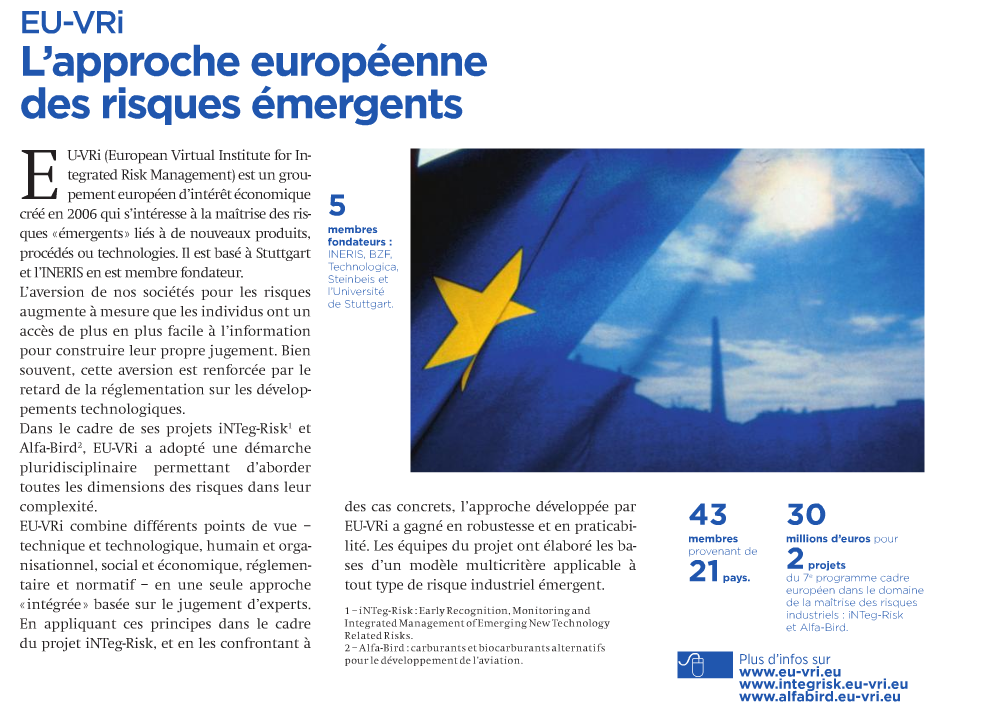
|
|
|
|
The Interview
In the interview which includes a presentation of the Prof. Dr. Aleksandar Jovanovic, the CEO of EU-VRi explains what INTeg-Risk is and what its goals are.
|
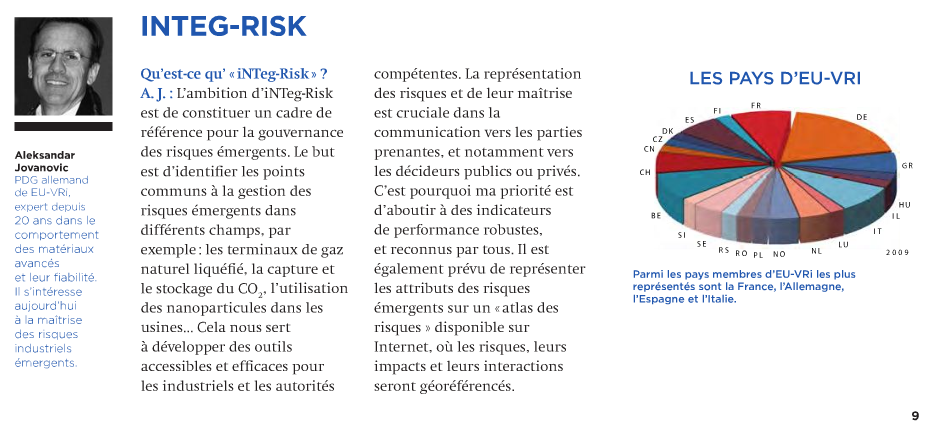
|
For more information about the INERIS:
http://www.ineris.fr/
|
|
|
|
|
|
|
|
24 Jun
2010 |
INTeg-Risk in the Corporate Responsibility Report of the world’s second-largest reinsurer |
 |
Swiss Re has recently published its Corporate Responsibility Report of 2009, in which we can find information related to the partnership between Swiss Re and iNTeg-Risk.
iNTeg-Risk in the “2009 Corporate Responsibility Report Committed to sustainable value creation” of Swiss Re
In its report, Swiss Re, which is the world’s second-largest reinsurer, explains that its partnership with INTeg-Risk is one of its strategic initiatives.
|
In cooperation with its external partners, Swiss Re actively contributes to four strategic initiatives dealing with emerging risks. In this way they want to raise awareness of selected emerging risks and support the business community in prioritizing, communicating and managing them.
- WEF - Global Risk Network
- Chief Risk Officer Emerging Risk Initiative
- International Risk Governance Council
For more information about Swiss Re, you can visit its website here
|
|
|
|
|
|
|
|

You can find the pdf of this report just above
|
|
|
|
|
|
|
26 Mar
2010 |
EU-VRi 6th General Assembly |
 |
The EU-VRi 6th General Assembly took place on March 26, 2010 at INERIS, Verneuil-en-Halatte, France
|
|
|
|
|
|
13 Jan
2010 |
Global Risk Report 2010 |
 |
Global Risks 2010 - A Global Risk Network Report has been released
|
|
|
|
|
|
27 Nov
2009 |
Steinbeis Advanced Risk Technologies and EU-VRi certified according to ISO 9001:2008 |
 |
The ZDH-ZERT audit on November 2, 2009 has proved that the Quality System of R-Tech / EU-VRi meets all requirements of the standard DIN EN ISO 9001:2008 – Quality management systems.
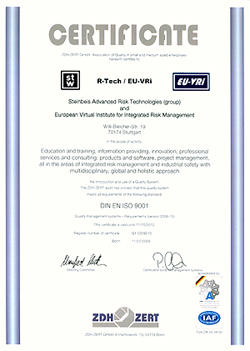
|
The ZDH-ZERT audit on November 2, 2009 has proved that the Quality System of R-Tech / EU-VRi meets all requirements of the standard DIN EN ISO 9001:2008 – Quality management systems.
The scope of activity: Education and training, information providing, innovation, professional services and consulting, products and software, project management, all in the areas of integrated risk management and industrial safety with multidisciplinary, global and holistic approach.
 |
|
|
|
|
|
|
19 Oct
2009 |
Collaboration with China discussed |
 |
During the RACR-2009 on October 2009 at Peking University (China) the Associated Membership of Beijing Municipal Institute of Labor Protection (BMILP) in EU-VRi was discussed.
During the RACR-2009 on October 2009 at Peking University (China) the Associated Membership of Beijing Municipal Institute of Labor Protection ( BMILP) in EU-VRi was discussed. The membership procedure is already in process. |
|
|
|
|
|
28 May
2009 |
EU-VRi Annual Report 2008 |
 |
The EU-VRi Annual Report 2008 is now available
|
|
|
|
|
|
08 May
2009 |
French Ambassador and French Consul General in Stuttgart visit Steinbeis and EU-VRi |
 |
On May 8, 2009 Bernard de Montferrand, French Ambassador in Germany, and Christian Dumon, French General Consul in Stuttgart, visited Steinbeis and EU-VRi.
On May 8, 2009 Bernard de Montferrand, French Ambassador in Germany, and Christian Dumon, French General Consul in Stuttgart, visited Steinbeis and EU-VRi. In his welcome Prof. Löhn, President of Steinbeis University explained in details the concepts of the transfer of technology from academics to industry implemented in a successful manner by Steinbeis. Further information was provided by Mr. Haug, especially about the network of Steinbeis. Prof. Jovanovic, CEO of EU-VRi and director of Steinbeis Advanced Risks Technologies, and Mr. Salvi informed the visitors about the work performed by EU-VRi, initiated thanks to the strong cooperation between Steinbeis and INERIS. The model of Steinbeis might be inspiring for the French institutions and government to develop similar initiatives in France. Mr. Christian Dumon, Mr. Bernard de Montferrand, Prof. Johann Löhn,
Prof. Aleksandar Jovanovic, Mr. Olivier Salvi, Mr. Uwe Haug (from left)
|
|
|
|
|
|
25 Nov
2008 |
iNTeg-Risk officially commences on Dec. 1, 2008 |
 |
Start date of the project is fixed and agreed among partners and EU
25.11.2008
The whole iNTeg-Risk team is glad to announce that the project has adopted Dec. 1, 2008
as
its fixed starting date. The European Commission has agreed to this
date and the final version of the grant agreement is under preparation. |
|
|
|
|
|
03 Oct
2008 |
R-Tech participation in ESREL 2008 |
 |
R-Tech was active at the joint ESREL 2008 and 17th SRA-Europe Conference, held on Sept. 22-25 in Valencia, Spain.
The lecture of Prof. Dr.-Ing. Aleksandar Jovanovic with subject "Practical steps towards sustainable use of safety performance indicators in EU industry" was presented at the ESREL 2008 Conference, which was organised by the European Safety and Reliability Association (ESRA) and took place in Valencia, Spain on September 22-25, 2008.
Prof. Jovanovic introduced the current projects and activities of Steinbeis Advanced Risk Technologies (R-Tech), as for example the innovative Key Performance Indicators (KPI) database, the EU project iNTeg-Risk and the goals of the European Virtual Institute for Integrated Risk Management (EU-VRi).
ESREL conferences are principal European fora for presentation and discussion of scientific and technical papers covering safety, reliability and risk-based methods as well as their application in a wide range of industrial and governmental sectors.
|
|
|
|
|
|
02 Oct
2008 |
Steinbeis collaboration with DIN |
 |
Steinbeis collaborates with DIN on standardization of "new technologies"
 The lecture of the DIN director Dr. Bahke on the Steinbeis Day was the first step towards a close cooperation, which was established in the summer of 2008 between the Chairman of Steinbeis Foundation Prof. Dr. Trasch and Dr. Bahke. At a following stage and during the next years, CEN-Workshop Agreements (CWA) are going to be prepared through a European research project with subject "Early recognition and management of new technology related risks", under direction of Prof. Dr.-Ing. Aleksandar Jovanovic.
The lecture of the DIN director Dr. Bahke on the Steinbeis Day was the first step towards a close cooperation, which was established in the summer of 2008 between the Chairman of Steinbeis Foundation Prof. Dr. Trasch and Dr. Bahke. At a following stage and during the next years, CEN-Workshop Agreements (CWA) are going to be prepared through a European research project with subject "Early recognition and management of new technology related risks", under direction of Prof. Dr.-Ing. Aleksandar Jovanovic.
As stated at the web-site of the German Institute for Standardization (DIN), on the 19th of September during his lecture Dr. Bahke has informed the audience about “Standardization as prerequisite for the success and sustainability of new technologies” and stressed out the positive collaboration between Steinbeis and DIN. “An early care for standardization in the research process and especially for the interpretation of results concerning state-of-the-art technologies can offer an advantage to Germany”, said Dr. Bahke. The audience was particularly interested in the use of standardization in research projects and new innovative fields, as well as in the value of standards in technology transfer.
Steinbeis day is the meeting point of colleagues, students and project partners of the Steinbeis Foundation (http://www.stw.de). Most of the directors of transfer centers are professors at universities.
|
|
|
|
|
|
|
|